#Humanoid Dirthamen/Falon'Din
Text
Andrastian Statues
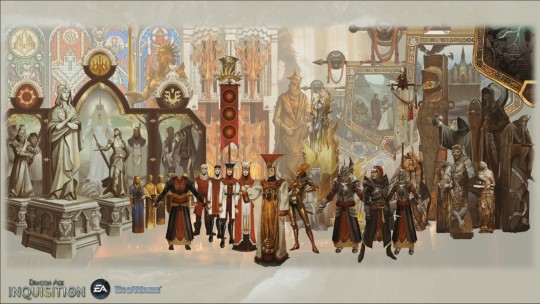
The purpose of this collection of statues is to show the Andrastian style depending on the region, the details in it, and how this may or may not influence other statues we saw in game. I also attempt to recollect some interpretations of them, although most of them are mostly based on speculations.
The current post contains the following set of statues:
Ferelden Style: Pre-Divine Andraste, Chasind Andraste, Ferelden warrior protector Andraste, The Maker, The Dwarf [?], Rider Maferath [?], Masferath Repentant, Hanged Masferath, Other Statues.
Orlesian Style: Rustic Maferath, Hessarian, Andraste; The Orlesian Warrior Andraste, The Stylised Orlesian Andraste, The Orlesian Andraste, The Orlesian Maferath, The Orlesian Havard, and the Orlesian Hessarian; The Weight of War
Free Marches Style: The Free Marches Hessarian, The Free Marches Andrastian Warriors [?]
Unknown Style: The Skull with sword, The Guide, Guardians of the Path / The Watcher.
[This post belongs to the series “Analysis and speculation of Statues”]
Ferelden Style
Pre-Divine Andraste
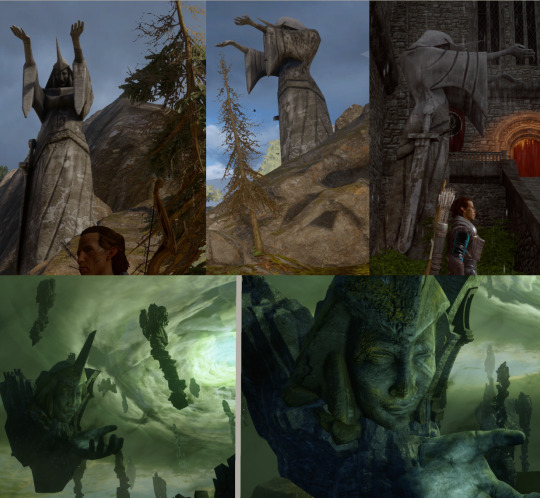
One of the most iconic statues in DAI.
It’s present all over Ferelden, specially in big, colossal statues along the paths of Hinterlands. They are so big that sometimes one can overlook them unless you look upwards [check Hinterlands: Statues, paintings, and structures found in the open].
In Skyhold, we can find this statue in a small version in the local chapel, which triggers the note Bride of the Maker.
Thanks to the DLC Jaws of Hakkon [Main Chamber of Razikale’s Reach], we know that this statue belongs to a pre-divine time. It is probably one of the oldest representations of Andraste we have in-game.
As usual, she has a one-spike helm that has strong resemblances to Flemeth’s tiara, and to Humanoid Mythal statue, Dragon Mythal statue, and the Ferelden Wyvern.
She has a sword in her hip.
Her sleeves and skirt have long lines that emulate folding. It’s a style we saw in statues that were considered “elvhen” in-game [for example, the Elven Archers or The guide]. But we can see this became an Andrastian style since we also see it in the Blocky bearded humanoid.
Her gigantic hands have been used in several elvhen places, and I wonder how meaningful these are: these hands appear in Exalted Plains: the Dead Hand as well as in the Shattered Library, holding eluvians. Is this a mere reuse of resources or hides some lore in it? We know DAI is less lazy about this than previous games.
This statue is curiously aligned with Humanoid Mythal statue in the Fade, as well as with the Imperial Highway Columns [check The Raw Fade: Part 1]. A Design choice that keeps me wondering if it hides some meaning in it.
Chasind Andraste
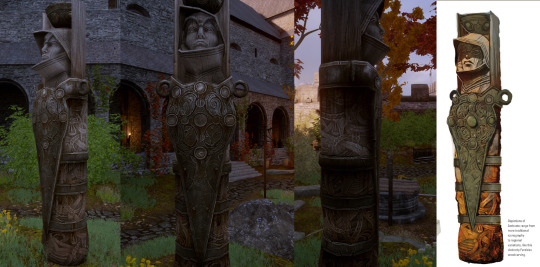
It has the design of a totem.
Its relief is very intricate.
She is represented as a protector warrior due to the strong presence of the shield on it.
We can suspect this statue is also ancient, and you can see that it has similar style to the Alamarri Monolith with swirls we find all over Hinterlands.
If you pick the Chantry-related garden in Skyhold, this statue appears in it and the archivist Banon will mention details about it in The Women of All War. He claims it’s Chasind, not original from Skyhold, brought by Ferelden into the castle. He also suggest it’s a re-usage of an ancient totemic statue.
This last comment streghtens the idea that ancient Andrastian art tends to be done over or using/co-opting statues from previous civilisations.
Ferelden warrior protector Andraste
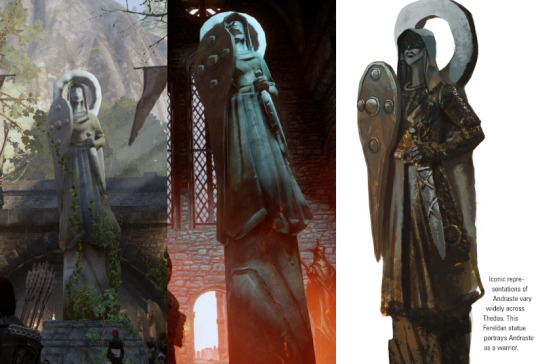
Another classic representation of Andraste in game.
It’s Ferelden style.
She is represented as a warrior [holding shield and sword] but also as a divine entity [I suspect the ring behind her works as a rustic design of a halo].
There is a chance that the thick “halo” could be an adaptation from another icon we saw among the Elvhenan design: the Golden Ring. How is this possible? I think it’s not too strange considering how deeply related to the elves the Avvar are. If we think that part of this culture comes from the Alamarri, one could guess that through the elvhen lover that Thrydda had, some elvhen presence has been around this culture to incorporate elvhen iconography in their own art, translated later into something of this shape.
The Maker
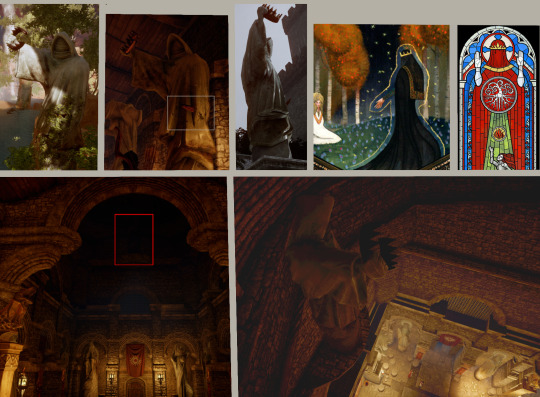
This mysterious figure has no face, in fact, it looks like bandaged. In his right hand holds a crown, while in his left hand, a dagger. The outfit is a very simple robe.
The dagger is quite curious for a representation of the Maker.
This statue took me a long whlie to identify. In early posts I kept calling it Faceless figure holding a crown. I came to the conclusion it is the Maker.
This statue appears always within the context of the Andrastian statues, so it could not be asumed in any other way than related to the Andraste Myth. In the posts Andrastian Design: Stained Glasses and Andrastian Design: Tapestry and Tryptich, we can see that a figure with no face and wearing a crown of similar characteristics is represented as the Maker. These are my main arguments to be confident about this identification.
In Hinterlands, he appears in the main hall of Haven very high upon the hall, hidden in the shadows, in a room filled with andrastian iconography, which reinforces the idea that it represents an entity that is above all of them, Andraste included. Another confirmation of being the Maker.
It also appears in the Tyrdda Bright-Axe Path, which has a mixture of statues, and in Forbidden Oasis, when the place was took by the Andrastian forces. It also appears in the mysterious Hinterlands: The Unknown Ruin. Other more natural and Andraste-related places where we find it: Redcliffe - Future, Therinfal Redoubt, Western Approach: Adamant Fortress.
The Dwarf [?]

This figure was tag along the blog as Blocky bearded humanoid. It is found in the main hall of the Templar building of Therinfal Redoubt and in the corridors of Redcliffe - Future
The design of this statue feels closer to the pre-divine Andraste. Maybe it has some influence of the Alamarri style.
The long lines on sleeves and chest seem to suggest similarity in style with the pre-divine Andraste but also with the elvhenan statues such as the Elven Archers, or The guide.
Its face seems to show a big smile, but if you see it with more detail, it may also represent a long, long beard. The broad constitution, the big ears, the lack of hair, and the prominent beard seem to suggest a golem-like or dwarven representation.
I can’t say I can identify this figure in the Andrastian Myth, but it’s related to the Andrastian Faith since it appears where there are other andrastian figures.
If this figure comes from the Alamarri and it was co-opted by the Andrastian faith, I could suspect that may be related to the dwarven culture that Alamarri had. If we remember Tyrdda Bright-Axe Path, she had a child with a dwarven prince. The Chasind also had mixed descendants of humans and dwarves. So, if it’s an alamarri statue co-opted by the Chantry, it could not be strange for it to be a dwarf. These details may indicate that the Alamarri had a deeper relationship with not only elvhen, but also dwarves, and this aspect appeared in the art until co-opted by the andrastian faith resulting in this figure.
Rider Maferath [?]

This statue appears only in Fallow Mire. Although, the same statue appears riding a horse in Crestwood: surface. Maybe it’s a mere reuse of resources.
It has a similar design to the Blocky bearded humanoid.
It represents a man with a beard, and its angular design may suggest similar time and style than the previous one.
More details in the section Other Statues from this post.
Masferath Repentant

Mostly seen in the region of Ferelden [although, you can find it too in Western Approach: Adamant Fortress]
This is the typical Ferelden statue of Masferath, regretting his betrayal.
He is sitting on a stone which has a design of a snake surrounding it, representing the Tevinter influence or deal he made with the Archon before handing over his wife.
The helm in this statue has a C-shape, which I find very similar in design to the Tevinter helms [check section “Outfits” in Patterns and Styles: Tevinter]. I’m not sure if this is mere coincidence, or it speaks of a common [dragon-inspired] origin source.
Hanged Masferath
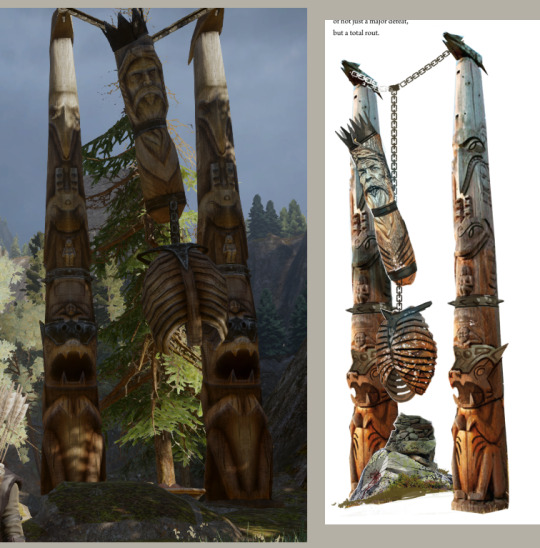
This totemic sculpture can be found in Hinterlands: Statues, paintings, and structures found in the open.
This is a Ferelden representation of Masferath being hanged. Clearly Ferelden has a strong sentiment with his betrayal.
The totemic structure seems to show mabaris at its base, followed by two different kinds of birds or maybe it’s a dragon [hard to say].
The top of these totems keeps bringing my attention: I can’t stop thinking there may be some link with the Tevinter metallic statue that I called “Tevinter bird”, found in Ferelden in the underground region of Crestwood: Flooded Caves.
Other Statues
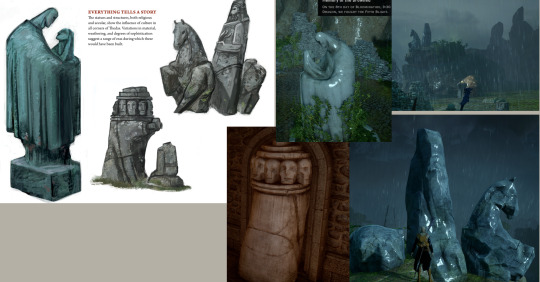
The couple can be found in Hinterlands: Redcliffe - Present, as a symbol to remember those who died in DAO-Redcliffe. It can also be found in Crestwood: surface as a memory statue of the drown, and in Frostback Basin [DLC]: Nigel’s point, as a memory statue of Ameridan’s friends: The templar Haron and the dwarf Orinna. It feels more like a reuse in most cases since it’s a strange statue to represent "fallen/lost people”. Certainly we can assume it’s Ferelden made.
The horse with the rider seems to have, as we see in its drawing from the book Art of Inquisition, a lot in common with the previous statue I called “Rider Masferath”. The horse has been removed in some other places to only let the human figure stay. It can be seen in Fallow Mire without his horse, and in Crestwood: surface. Sometimes the rider is not well chiselled in the stone.
The vessel with many faces is only seen once in the game, in the The Darvaarad - Part2. We know the Qunari took this castle and put a lot of statues that they gathered around the world. However, this statue of many faces looks like it belonged to the inner corridors of the castle, implying the castle per ser may have been Ferelden, or elvhen in origin, but repurposed by Ferelden later. In the game we only see the “back” part of it, while in the book Art of Inquisition, we can see the full statue, which implies a beheaded figure. Maybe it’s the representation of a jury. It could also be interpreted as an entity that puts “the right head” into the people, suiting the Qunari and their Qun philosophy, but this interpretation would make me question why it is so related to Ferelden art in the Art Book.
Orlesian Style
Rustic Maferath, Hessarian, Andraste
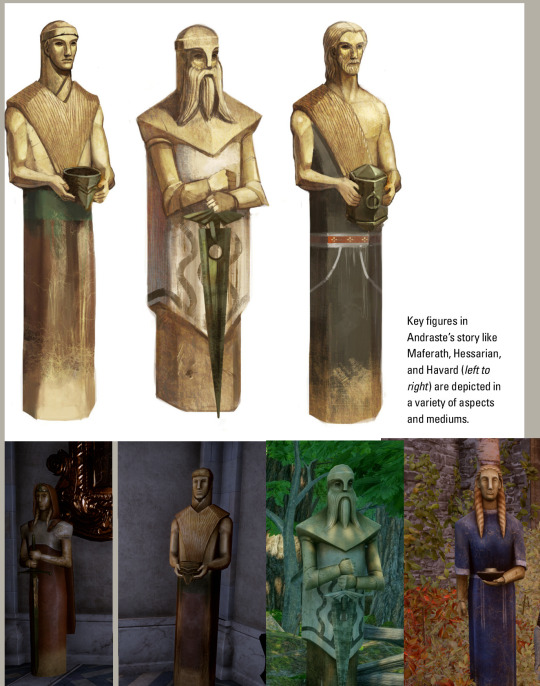
A bit distant to the style of the Blocky bearded humanoid, we have these series of statues representing typical characters from the Andrastian Myth.
They are mostly located in different areas all over Orlais [or inside the Skyhold if you pick an Andrastian garden].
We find Andraste, in blue and red [I’m assuming one is the bride of the Maker, while the other is the warrior protector of her people]
Masferath is carrying a crown (?) in his hands, and Hessarian is holding the Sword of Mercy.
These seem to belong to an Orlesian style but rustic or more “popular”. They give me the impression that were made by the working class people who could not afford realistic artists to sculpt them in stone.
They seem to be made out of wood.
The Orlesian Warrior Andraste

Unlike the previous one, this Orlesian statue is made out of stone and is bigger, more detailed, and realistic. It seems to appear in rich/high class places.
It also appears in Emerald Graves: Din'an Hanin, which may represent the influence of the Andrastian faith among the Ancient Dalish when the Dales was their Kingdom land granted by Andraste herself.
This statue presents Andraste as a warrior: she is wearing a detailed armour, a big sword, and, curiously, a helm that has no iconic single-spike. However, I can see some similarities in the armour design to Flemeth’s armour or the armour used by Humanoid Mythal statue.
Due to the strong similarities in style, this statue belongs to the same group than the Orlesian Andraste, Orlesian Maferath, Orlesian Havard, and Orlesian Hessarian.
The Stylised Orlesian Andraste

Another over-detailed statue of Andraste made out of Stone which appears in wealthy places.
The whole design of Andraste has a strong similarity to Tyrdda Bright-Axe, which may suggest that this statue may have a strong alamarri influence, mixing Andraste tale with the representation of Tyrdda.
The icon that represents the sun, ironically, has a strong similarity with the statue I called Sun-head creature, deeply related to the Elvhenan and, potentially, to Tevinter and its old dragon gods. This may imply that this statue may have collected several icons and details from different cultures and faiths to gather them in the cult to Andraste. This process is well known in human History, where the forced religion tries to blend with the local ancient one to produce an assimilation of the new faith.
The Orlesian Andraste
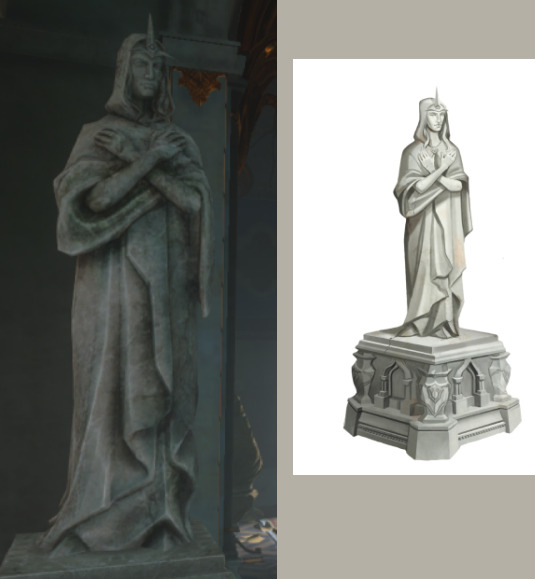
This Orlesian statue is made out of stone and is bigger and a lot more detailed and realistic that the “wooden” sculptures.
It tends to appear in wealthy places as well as inside the Chantries of the game.
It represents mostly the divine Andraste and the bride of the Maker, without any element of her warrior side.
She has a one-spike helm that has strong resemblances to Flemeth’s tiara, Humanoid Mythal statue, Dragon Mythal statue, and the Ferelden Wyvern.
Due to the strong similarities in style, this statue belongs to the same group than the Orlesian Warrior Andraste, Orlesian Maferath, Orlesian Havard, and Orlesian Hessarian.
The Orlesian Masferath
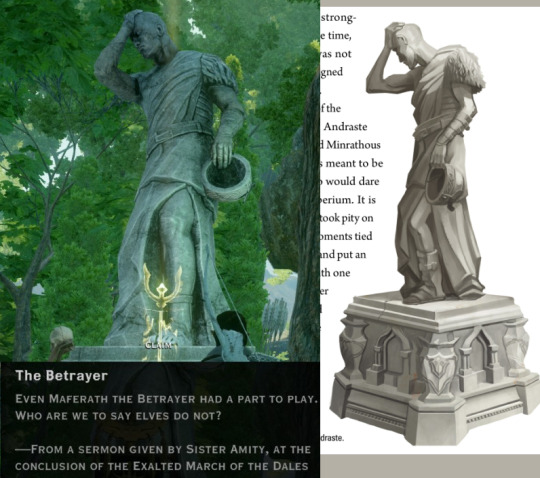
It is called “The Betrayer”.
We see the man worried, grabbing his own head, showing the weight of his own betrayal. He keeps the crowd of his leadership of the Alamarri in his hand since the Chantry tale says that he betrayed Andraste out of jealousy because she was more important than him among their people. I always questioned this since he was the one commanding the armies and their people into Tevinter, and he may have chosen the “lesser bad” option [read the The Chantry and the Mythology of the Chant of Light for more details].
Due to the strong similarities in style, this statue belongs to the same group than the Orlesian Warrior Andraste, Orlesian Andraste, Orlesian Havard, and Orlesian Hessarian.
The Orlesian Havard

Havard is shown here with avvar clothings [fur-based].
He is carrying the urn of Andraste’s ashes that will be placed in Haven and will become later the Temple of Andraste [DAO].
We know thanks to the notes triggered in it that this statue seems to represent Havard but its appearance was based on a noble’s lover [check it in Emprise du Lion: Pools of the Sun].
Due to the strong similarities in style, this statue belongs to the same group than the Orlesian Warrior Andraste, Orlesian Andraste, Orlesian Maferath, and Orlesian Hessarian.
The Orlesian Hessarian

He is holding the sword that will be called the Sword of Mercy, used to kill Andraste in the pyre so she could not suffer anymore.
His hat has a bent T-shape that we can see in many other helms of Tevinter warriors in the section of “outfits” in Patterns and Styles: Tevinter.
Due to the strong similarities in style, this statue belongs to the same group than the Orlesian Warrior Andraste, Orlesian Andraste, Orlesian Maferath, and Orlesian Havard.
The Weight of War

This statue was tagged in this blog as Man holding bigger head for a long while.
It has appeared in Forbidden Oasis, Redcliffe - Future, and in Orlais: Winter Palace.
Thanks to the constant presence of Andrastian-themed art around it, I could finally assume that this statue belongs to Andrastian art in Orlesian style.
The main man has angular features, his ears are not visible since it looks like he is wearing a chain-mail. He uses scale-based pauldrons, and a robe. He is holding a sword with one hand while the other holds a bigger head. By comparison with the state of the overall figure, we can assume that the bigger head has a lot of wounds and scars [meaning that this is part of the sculpture design and not a consequence of erosion].
Despite looking similar, the head in his hand and this man’s profile are different. The bigger head has a smaller, shrank nose.
The only significant shape in this statue that can give us a resemblance of a hint to whom it belongs is his belt, which has pointy ends. We had seen this pattern in two places: in Tevinter artefacts, such as the sacrificial burial, or in andrastian outfits.
It triggers a codex called The Weight of War which is a bit unreliable, since the person explaining this is an amateur historian, but it’s the only hint we have about this statue. The amateur historian implies that this statue may belong to a warrior with a philosophy similar to the Grey Wardens.
More details about this statue in the post Forbidden Oasis.
Free Marches Style
The Free Marches Hessarian
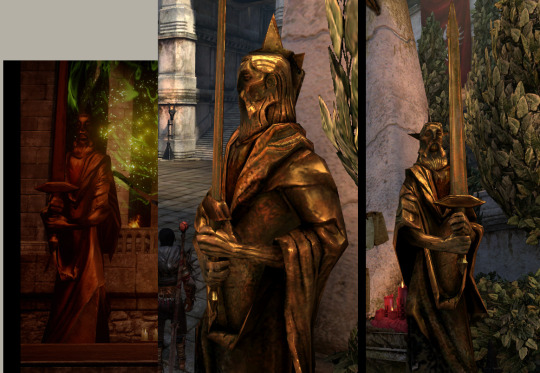
It appears mostly in the Templar fortress of Therinfal Redoubt
This statue has a strong resemblance to Tevinter art. It’s not only the dark metallic material used for the sculpture, which was strong similarities with Tevinter artefacts such as Thrummer, Water dispenser, Tevinter urn, Tevinter artefact with spikes, Tevinter golem or Claw of Dumat, but also the prominence of angles and pointy ends.
There is no codex associated with this sculpture, but I can guess it may represent Hessarian [the main Tevinter figure in the Andrastian Myth] since this statue has a version carrying a sword.
It has a long beard and hair.
This statue has also been present in DA2, specially in the Chantry district of Kirkwall [check it in Architecture of Kirkwall : The Chantry].
The Free Marches Andrastian Warriors [?]

It appears mostly in the Templar fortress of Therinfal Redoubt and in the Fade.
This statue has a strong resemblance to Tevinter art. It’s not only the dark metallic material used for the sculpture, which was strong similarities with Tevinter artefacts such as Thrummer, Water dispenser, Tevinter urn, Tevinter artefact with spikes, Tevinter golem or Claw of Dumat, but also the prominence of angles and pointy ends.
It’s wearing a typical DA2 Andrastian robe, but the helm has always brought my attention: it has a lot of more similarity to the Tevinter warriors than to the one-single spike helm of Andraste.
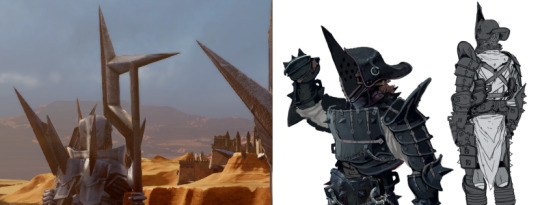
Its weapon also has a strong similarity to the weapon used by Tevinter golems, while its helm has strong similarities with the ones that belong to the Tevinter warriors. One may say that both of them, in fact, are representing the one-spike helm of Andraste.
The unmistakable identification with Andrastian faith is given by the robe: if we see the chest, we will see the pointy half sun on it, which was the main design of the outfit of Elthina and other chantry priests we saw in DA2.
Unknown Style
The Skull with sword
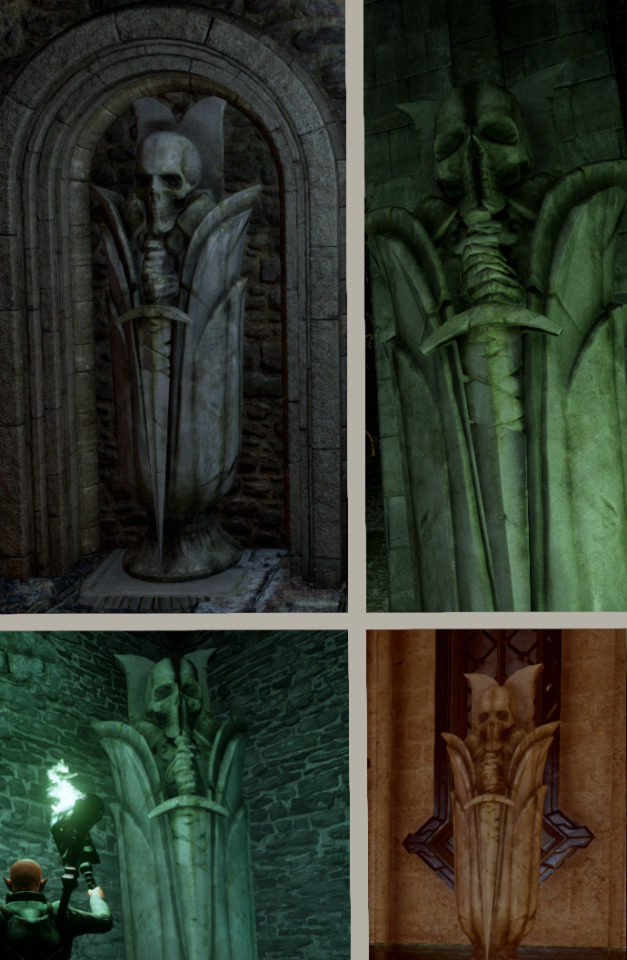
This is the statue that I called Skull bud with sword all over this blog.
The skull is quite long for a regular human. It holds a sword. The body seem to be inside a bud or a shell that may look like a flower bud but also as the shell of an insect/scarab.
This statue has always appeared within Andrastian contexts such as in Frostback Mountains - Haven [the basement], Hinterlands:Dead Ram Grove, or Ferelden: Therinfal Redoubt, but also in places where the Andrastian context is not that strong, but still yet reasonable to appear, for example in Hinterlands: The Unknown Ruin [overtaken by Andrastian faith lately, so far we see in the statues present in this room], or Emerald Graves: Din'an Hanin [which clearly shows how the Ancient Dalish allowed a certain level of assimilation of the Andrastian faith thanks to Andraste’s gift of the Dales]. However, we also find this statue in Western Approach: The Still Ruins, Viridis Walk and Inner Sanctum, which is a pre-blight Tevinter building, so one is inclined to think that this statue may have been Tevinter in origin, and somehow, adopted later by the Andrastian faith. Or maybe it’s just Elvhenan, taken first by Tevinter, and later by the Chantry [as we see this pattern repeats over and over with everything related to Tevinter].
One of the potential interpretations is that this sculpture represents a coffin, or a dead who is put to sleep in this position. The fact that this skull is inside a bud or an insect shell [in addition to the speculation that, like all what comes from Tevinter, was originally elvhenan] brings the possibility of being related to Uthenera and the mysterious codex of Vir Dirthara: A Flowering Imago that I tried to multi-interpret in several ways in Ancient Elven codices; Vir Dirthara.
So far I know, there is no codex associated with it, and we have only speculations about it.
Its style is not strongly similar to all these Andrastian statues, but the fact that it appears mostly within andrastian themed rooms, it’s hard not to bring it into this post.
However, I’m not confident about how to understand this statue and to what culture associated it with.
The Guide


It can be seen in three places only: Emerald Graves: The open pointing more or less towards Elgar’nan’s Bastion, on top of Stone-Bear Hold Avvars - Part 2 pointing out to the sea, and in the Fade, exactly in Flemeth’s Fade: Part 2, pointing the path towards Mythal/Flemeth.
It’s associated with the unreliable landmark called The guide [written by this orlesian scholar who lacks of deep knowledge of elven culture], which identifies it as an elvhen statue, but it has a lot of style similarities to the Blocky bearded humanoid and the pre-divine Andraste as well as to the Skull bud with sword. If we see the back of an Elven Archer statue, we can find line-based similarities too, so it’s hard to decide whether this is truly Elvhen in origin and co-opted by the Andrastian and repurposed later, or it truly belongs to the set of pre-divine statues we spoke above and this amateur scholar misunderstood it as Elvhenan.
The unreliable landmark links it to Falon’Din for the mere fact that it is pointing out a place, so it “guides”. If we overlook this pathetic logic, and we give it a remote chance for it to be elvhen, we should be careful to identify it with Falon’Din. First, Via Solas, we know that Falon’Din was far from guiding people [Check Evanuris], and second, even if we consider this statue to be Falon’Din, we should never forget how Falon’Din and Dirthamen are entangled one another [check Humanoid Dirthamen], so this could also be a statue representing Dirthamen. The shape of the sleeves has some resemblance to the Elven Owl statue [they have long lines along it], but once more, both gods are so indistinguishable one another that it’s hard to say who is who.
Guardians of the Path / The Watcher

This hooded statue was called Humanoid Dirthamen/Falon'Din in this blog.
The hooded statue can be seen in four places: in Emerald Graves: The open, as a watcher of entrances, in the Hinterlands, along the Tyrdda Bright-Axe Path inside the Calenhad’s Foothold; in Exalted Plains: Northern Ramparts and Citadelle du Corbeau, as the main big statue when you step into the Citadelle [again, watching over an entrance] and in Flemeth’s Fade – Part 2, as a statue bleeding profusely with a sword in its back, as an unmistakable symbol of betrayal.

In all these cases, the hooded version of the statue seems to be related to “watch or protect entrances”. Due to its presence in the Fade of Flemeth, we also can associate it with deep betrayal.
Once we see how the pattern unfolds with the statue I called Humanoid Dirthamen/Falon'Din [hodded version] we can understand the Andrastian version “guardian of the path” in similar fashion [he always appears in entrances as well], suspecting it was a re-usage and co-opt of the elvhen hooded statue when the Andrastian forces conquered the Ancient Dalish's lands.

The Guardian of the Path appears twice in game: in Crestwood: surface, at the entrance of the region, similar position as the hooded versions in Emerald Graves, and in the entrance to the region of the Exalted Plains.
#andrastian design#andraste#The Guide#guardian of the path#Skull bud with sword#Man holding bigger head#orlesian design#ferelden design#Humanoid Dirthamen/Falon'Din#andraste statue#hessarian#havard#Maferath#blocky bearded humanoid#Faceless figure holding a crown#the maker#maker#Analysis and speculation of Statues
15 notes
·
View notes
Text
Mythal
Mythal the Protector and the All-Mother, and goddess of love, is the patron of motherhood and justice (the flip side of vengeance). She leads the pantheon with her male counterpart, Elgar'nan.
Dalish Legends
The Dalish believe that Mythal was born of the sea. They tell that when Elgar'nan threw the sun out of the sky in vengeance for burning the earth to ashes, Mythal calmed him and helped him see how his anger had betrayed him. Elgar'nan was convinced to free the sun. On the first night after the sun was released Mythal created the moon, from the glowing earth round its bed, to be placed in the sky as a pale reflection of the sun’s true glory.
In most legends, Mythal and Elgar'nan had five children: Falon'Din, Dirthamen, Andruil, Sylaise and June. However, in some versions the last three of them are not related to Mythal at all.
In most stories, Mythal rights wrongs while exercising motherly kindness. Other paint her as dark, vengeful. Yet all accounts end the same: Mythal was exiled to the Beyond with other gods.
The Dalish invoke Mythal’s name when they require protection.
In Elvhenan
Mythal was one of the Evanuris, mortal mages who enslaved their kin and branded them with their vallaslin. Unlike the other pretender gods, she was a voice of reason and genuinely cared for her people. Mythal was truly the Mother, protective and fierce.
The ancient priests who toiled in Mythal's favor passed their knowledge on through the Well of Sorrows. Their collective will would put anyone who drank from it under a compulsion and bind them forever to Mythal's service.
Elves petitioned Mythal on matters of justice and it is said that those who came to her with clear minds and open hearts were granted judgment and protection; Mythal harried their enemies until the end of their days. Those who tried to manipulate her wrath against those they envied or were being petty over imagined slights were swiftly struck down.
Thus, Mythal did not show favor to the sinner who dared to fly in the shape of the divine. She let Elgar'nan judge him.
On another occasion, when Falon'Din and Elgar'nan found themselves in an argument, Mythal defused the situation by suggesting that they appoint their knights to battle in their stead, thus avoiding a civil war among the gods.
When Falon'Din began wars to amass more worshipers, Mythal rallied the gods against him. Falon'Din only surrendered when they bloodied him in his own temple.
When Andruil had gone mad after hunting in the Void, Mythal took the form of a great serpent and waited for Andruil at the base of a mountain. They fought for three days and nights, until Mythal sapped Andruil's strength with her magic and stole Andruil's knowledge of how to find the Void.
Mythal has struck down the titans and rendered the earth, their demesne, unto the elves. Her statues are found deep underground, often accompanied by statues of Fen'Harel. One statue is overlooking an ancient dwarven tomb. She is described as giving dreams to someone empty and thus filling them up.
Mythal's Well of Sorrows knows the secret greeting from those Fen'Harel trusted, which suggests that Fen'Harel and Mythal were close.
Fate
Mythal was murdered, but not by Fen'Harel. She was betrayed by those who destroyed her temple.
Mythal's fellow elven gods killed her in their lust for power. This act was the final straw that led the Dread Wolf to banish them. However, the first of his people do not die so easily.
Mythal was reduced to a wisp of what she was, and came to Flemeth in her time of need. Thus the famed Witch of the Wilds, who is in fact the possessed form of Mythal, came to be. She seeks justice for what was lost.
In the aftermath of Corypheus' defeat, Solas confronts Flemeth at an eluvian just as Flemeth is seen passing some form of energy through the mirror. After a brief exchange Solas/Fen'Harel appears to absorb Flemeth's power.
Symbols and shrines
Mythal is often depicted as a dragon or a female humanoid figure with dragon head and wings. The constellation “Silentir,” which resembles a dragon in flight, may be related to Mythal.
An altar to Mythal is found atop Sundermount, outside of Kirkwall. A majestic Temple of Mythal guarded by Sentinel elves is located deep in the Arbor Wilds. It was once the center of a temple complex with an entire city around it, and there were multiple such cities. Another Altar of Mythal stands nearby.
1 note
·
View note
Text
Analysis and speculation of Statues: “Humanoid Dirthamen”

Making a small room for speculation, I want to try to analyse who is this? and why is he bleeding profusely? I also analyses the presence of visual statues that may represent Falon’Din and Dirthamen.
[This post belongs to the series “Analysis and speculation of Statues”]
Where do we find this statue in DAI?
There is no similar statue in DAO or DA2. It belongs exclusively to DAI, appearing in several places:

In Citadelle du Corbeau we are told in the landmark called The Raven that this statue seems to be related to him. He is also in the entrance of the city.
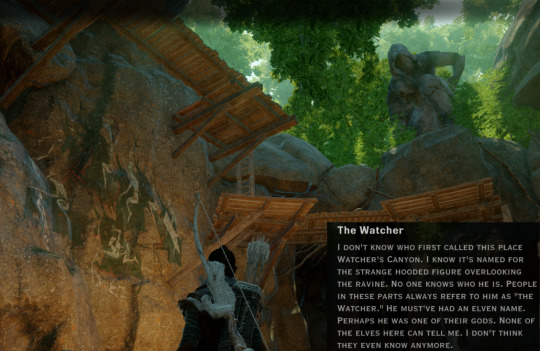
Another landmark we get with this statue is “The Watcher”, written by Fairbanks himself, so clearly it is not reliable at all. The only information he gives us is that nobody knows who this statue is. In fact, this landmark gives us hints to relate it with the sitting Fen’Harel statue inside the cave, as if it were related to him in some way [in a friendly manner to protect the place where the wolf hides, or in a hostile manner, looking for the hidden wolf in its lair]. However, I think this is a red herring, the author of these lines of thoughts is a man who has no idea about Elven or Elvhenan culture.

It has been found in the Hinterlands: Tyrdda Bright-Axe Path, inside an abandoned Fereldan foothold, triggering Tyrdda’s tale. The only interesting aspect of this is that it triggers the part of the tale where we are introduced to Thelm, a greedy man who wanted to force Tyrdda to marry him in order to increase his army and go to the North to the “Golden City”. If anything, we could see that both characters [Thelm and potential Falon’Din] share a power-hunger, greedy aspect [I say Falon’Din because we can’t link Dirthamen to Thelm, since we know next to nothing about this Evanuris, and because Dirthamen and Falon’Din are usually presented as inseparable one another].

Another set of these statues can be found at Andruil’s wall, an encampment of the Inquisition surrounded by a ruined wall, over which four of these look down at the tents.
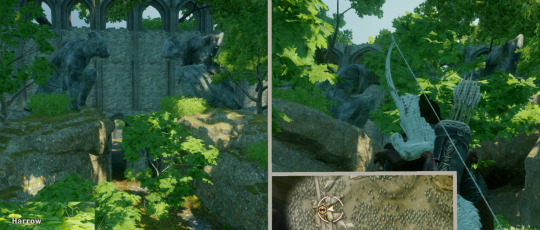
And the last place where we find them is in Harrow, at the entrance to Emerald Grave and the Exalted Plains, where a pair of these statues can see you cross the borders between both regions.
What we can conclude, seeing all these examples, is that it’s a statue that usually is placed in spots of entrance to places:
At the entrance to the big elvhen city that must have been the one built in Exalted Plains,
At he entrance of Watcher’s Reach: an abandoned or forgotten elven ruin where Fen’Harel statue persist without suffering erosion under a waterfall,
At the entrance of the ruin that may have been Andruil’s Wall,
At the entrance of the city itself that existed once, where we find now Citadelle du Corbeau, and
Inside the Ferelden Foothold, which seems to have been placed inside by some noble Fereldan for decorative reasons. We don’t know the original place for this statue.
So, the majority of the cases is a statue related to entrances. Sadly, we can say exactly the same about the other statues of Fen’Harel [howling or sitting version] or Mythal’s. So, the location of these statues provides little for deeper understanding.
Speculation 1: He is Dirthamen.
Design-wise, without any extra context but the few codices we got along the game, this statue in the Fade would speak of Dirthamen because in Citadelle du Corbeau we were told in the landmark called The Raven that this statue seems to be him. Now, the landmark saying this is tremendously unreliable: it’s information given by scholars that cannot recognise that the defence system of the Citadelle du Corbeau is Tevinter-made instead of “elven”. This makes me suspect that they are not so specialised on Elven History as they think so, or their focus is “ancient Dalish” [who are implied in some parts of the game to use Tevinter-made objects] instead of “Elvhenan”. So how much can we trust these people to trust them that this statue is Dirthamen?
On the other hand, there is also little non-dalish knowledge about Dirthamen. The only thing we have is that he disappeared at some point in elvhen history, stopping to communicate with his priests, so they fell in despair [The Lost Temple of Dirthamen].
So far I know, there is nothing, lore-wise, reliable or not, about Dirthamen involved with betrayal, murder, sacrifices, or blood magic [all elements that we can associated with what we see in this configuration in the Fade]. They seem to be elements more related to the High One of The Lost Temple of Dirthamen.
If we read the unreliable Dalish Tales, we can find things hard to consider if they could represent the small grain of truth that they contain or not. For example, Dirthamen’s two ravens are Deceit and Fear. So if this statue appears flanked by two Keepers of Fear, would that mean that Dirthamen used fear as a tool to control his worshippers? [Dirthamen: Keeper of Secrets]. Apparently, the unreliable Dalish knowledge says that the bear is his favoured animal, because it could keep their secret-gift [Bear] and created the Varterral to defend a city in the mountains [Varterral]. None of this gives us much to work with.
The most annoying aspect of understanding Dirthamen for me is that none of these symbols, whether they come from unreliable Dalish tales or from the few codices we obtain from ancient elvhenan temples, are reflected in his own temple: The Lost Temple of Dirthamen - Part 1 / Part 2. There are no bears, there are few owl statues that could be considered representations of his Ravens[but they are also Andruil’s messengers], and the only detail that we can relate to the Varterral is the red mosaic of Ghilan’nain present in his temple; who seems to be responsible for the creation of chimeras and may have helped him or even gifted the Varterral to him. But all this is speculation, there are no codices or trustworthy information that can confirm or refute any of this. And the lack of any kind of confirmation is what makes this analysis so impossible to give some conclusion with a small degree of certainty.
Speculation 2: He is Falon’Din.
We know that Falon’Din was called Dirthamen’s shadow [Unreliable codex from the Temple of Mythal: Twins in Shadow], and was related to “wings of death” [Song to Falon'Din]. So the landmark called The Raven may mix these elements and represent Falon’Din as a creature of shadow/dark wings. After all, Death can be related to darkness and shadows too.
I’ve also been writing in several posts about how Falon’Din’s figure seems to be more present in spaces that are supposed to belong to Dirthamen [The Lost Temple of Dirthamen does not display any mosaic or representation of Dirthamen, instead, we find two mosaics of Falon’Din at the sides of the entrance of the final chamber]. All these details make me suspect that maybe scholars have been mistaking Dirthamen’s figure for Falon’Din’s. So this statue which was perceived as Dirthamen by contemporaneous scholars in The Raven is, in fact, Falon’Din. But again, mere and absolute speculation.
The last detail that, I think, can relate this nonsensical statue in the Fade with Falon’Din is Solas’ words when he was in Mythal’s Temple and he offers us some bits of unknown lore about this Evanuris: Mythal rallied the gods when Falon'Din started to [I understand] kill Mythal’s followers. It was almost late [sadly, Solas doesn’t say in what sense it was late]. Falon'Din surrendered only when the other Evanuris bloodied him in his temple [for more detail, check Temple of Mythal, Part 2].
I’m not sure if this whole space of the Fade is a reflection of Falon’Din’s Temple. There are almost no dead around it. So my trust in this interpretation is quite weak too. However, the statue is certainly bleeding a lot, in a place that we can understand that belongs to Mythal/Flemeth. But again, this requires so much speculation, that I’m not explaining this with the Occam’s razor anymore.
Speculation 3: It is Both.
Probably not the most shocking speculation, but it’s the most straightforward and faithful to the lore surrounding these two: we can never separate one from the other. This concept keeps the two previous speculations at the same time, as well as it preserves the idea that Dirthamen may have been consumed or bound to the will of Falon’Din.
When Solas says about Falon’Din that “The blood of those who couldn't bow low filled lakes as wide as oceans”, one can speculate that Dirthamen did not bow, and Falon’Din made him bleed in this brutal way reflected in the Fade [maybe even some kind of bound-blood magic procedure is involved], causing his disappearance later that threw all his priests into despair. Maybe when we understand this statue as Dirthamen, the symbol of betrayal in his back makes a little more sense than when we understand it as Falon’Din. Probably Dirthamen was betrayed and therefore, disappeared without any warning [if we assume that his disappearance in the Lost Temple of Dirthamen happened long time before the creation of the Veil. Sadly, there is no date to understand in the general timeline when he disappeared exactly, so we can’t be sure it was due to the Veil or an event before it.]
Falon’Din was never betrayed, if we take into consideration all the info from non-dalish codices that we have in Ancient Elven codices, Temple of Mythal, and in Ancient Elven codices; Vir Dirthara. In any circumstance, he was seeing it coming. At the same time, Falon’Din was bloodied in his own Temple when Mythal rallied the gods to stop him. But the sword at his back makes little sense, since it’s a strong symbol to represent Betrayal. Solas claims that Falon’Din was out of control in his mass killings, so he had to be stopped [it was not a matter of loyalty or betrayal anymore], but “it was almost late”. Falon’Din did something terrible that could not be fixed later, apparently.
If we keep this idea that Falon’Din and Dirthamen are one, it seems to explain why there are no figures of Humanoid Falon’Din in DAI. It’s true we have The Guide, which is very, very, very unreliable. Its codex basically says that people relate it to Falon’Din because he “guides” [such a weak argument]. But we know the truth: Falon’Din was more a mass killer than a guide, so this statue makes little sense. Specially if we take into account the author, a wanna-be scholar who became “adventurer”. Besides, the style of the statue resembles more an andrastian figure than an elvhen one [the lines of the robe are exactly the same one that the pre-divine statue of Andrastre, or even the Blocky bearded humanoid.
This argument [that there is no statue of Falon’Din], however, is immensely weak, since we can say the same about the other gods: Ghilan’nain, Andruil, Elgar’nan [potentially it could be represented by The Strange Idol]
Speculation 4: It is a reflection of Mythal’s betrayal.
This option is explained in the post of Flemeth’s Post, part 2.
Conclusion: we are at the same as we started the post. There is no certainty that this figure is one of the Evanuris twins or both.
What about “Falon’Din” statue in DAO?
We can also argue that DAO has “images” of Falon’Din and Dirthamen, but it’s so hard to trust DAO visuals, since as I’ve shown along the DAO posts, there is a constant reuse of assets to mean completely different things: they use statues that represent Andraste, that we see inside andrastian churches, in Dalish camps and name them after the elvhen pantheon [there are many posts showing this nonsense, but one of the wildest is this one]. Besides, it seems that DAI brings back much better statues and symbols from DA2 than from DAO [example of that is the claws of Dumat].

[Original concept art for the Archdemon, next to the statue asset that made it in game. via DAO Game Extracts and the Bioware 25 Anniversary Book.]
The mysterious statue with big wings that we find in several places of DAO [Tower of the Circle of Magi: Basement, Dalish Camp and Dalish Origin, Denerim: Blood Mage quest, and The Architect’s Labs] was confirmed long ago to be an Old God/Archdemon which design was more Cthulhu-based, but due to the animation limitations of the engine, the devs ended up picking a dragon figure for the archdemons.

The statue that Tamnlen recognises in Dalish Origin as Falon’Din [because he apparently saw it in a Keeper’s book] clearly has an intentional resemblance with this Old God. However, it has some crippled wings, only two arms, and lacks of tentacles [to refresh the context, check Dalish Camp and Dalish Origin]. This figure holds a spear, which at this point in DAI triggers a lot of warnings after reading Unreadable Elven Writing from Ancient Elven codices, Temple of Mythal.

In the Architect’s Laboratory we find this configuration where we can see the clear differences and resemblances between the two statues. It seems as if “Falon’Din” is trying to look like this Old God. In this configuration we see “Falon’Din”’s figure “repeated”, so we can suspect that if one of them is Falon’Din, the other has to be Dirthamen. Both look the same because they are “twins”. This would imply that Dirthamen as well as Falon’Din were interested in looking like the same Old God [which seems to be identified as Urthemiel, making total sense for the Architect to have it in his laboratory, even though it’s a bit strange for him to have this statue since he lost his memory as a magister. Unless it’s a pretence. But we are not going to deepen on this topic here.]
Falon’Din/Dirthamen’s chest displays a mark that sadly, due to the limitations of the engine in DAO, is barely visible. Curiously, the only other statue I saw with a mark on their chest was the strange Female Kossith/ Desire demon /Tevinter Warrior. In her chest we see a fancy skeleton of what looks like a dragon or a bird, while on Falon’Din’s chest the mark looks more like a horned head.

For a long while I’ve been trying to understand this bad-quality symbol on the chest of “Falon’Din”. I’ve seen this symbol inside DAO as a symbol of a “horned” head, and tried to find it in many other places:
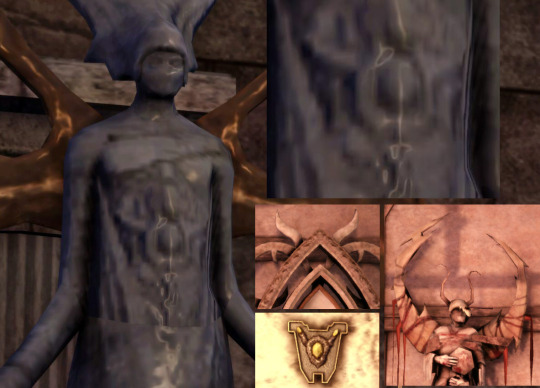
The top of the eluvians, the Darkspawn decoration, small decorative dwarven gem-based objects. Sadly, none of them makes much sense to be related to this statue, lore-wise. Once more, it’s hard to determine how to link things in DAO [only by design] when it’s clear that they did not have the resources to make a different design for each racial group, as they did in DAI.
After thinking too much on these symbols on the chest, I speculated another possibility relate to the (Falond’Din’s / Dirthamen’s) Vallaslin in an attempt to understand the truth using Solas’ own words about these tattoos:
Solas: The Vallaslin. [...] I discovered what those marks mean.
Inquisitor: They honour the elven gods.
Solas: No. They are slave markings, or at least, they were in the time of ancient Arlathan.
Inq: My clan's keeper said they honoured the gods. These are their symbols.
Solas: Yes. That's right. A noble would mark his slaves to honour the god he worshipped. After Arlathan fell, the Dalish forgot. [Solas, romance scene].
Solas words’ can be interpreted in two ways: the generic elvhen nobles that supported the Evanuris system and owned many slaves would mark them with the Evanuris’ brand they supported.
Or, the Evanuris were originally the noble ones, who worshipped ancient gods we have no knowledge about, and used those gods’ symbols to brand their own slaves. I’m inclined by the second one because the game made us question in several codices about “the gods that the gods of the elves worshipped”, an example of it we have the codex The Temple of Mythal, or even conversations with Morrigan also trigger this question. I think there is intention of the game to makes us think in that direction. Morrigan is, after all, an excellent questioning thinker, who already suspected that the elvhen pantheon was just a group of powerful rulers.
So I believe that maybe a mark of the truth and of the Gods that the Evanuris worshipped in the beginning, before claiming godhood for themselves, is through the Vallaslins. If this concept is correct [sadly, no assurances here either], I imagine that the Evanuris took some aspects/ design elements of the ancient gods they worshipped and made them their own when they claimed godhood [typical topic in DA world: continuous and repeated co-opt of symbols and knowledge across the ages and the races]. So, the Vallaslin seems to be a symbol that could give us some clues about the divinity systems and how they co-opted one another as they kept claiming godhood.
If anything, this could be another parallel of what we see with Ancient Tevinter: they took so much from elvhen knowledge and claimed it their own, that I can see the elvhenan doing the same to creatures of ancient times, erasing their existence, as Tevinter did with the presence of elvhenan in their own arcane knowledge when it’s very obvious its influence and almost theft [foci, somniari culture]. There are some clues in the comics that may suggest that the original creators of everything were the great dragons, but this is an hypothesis I will explore when I start the analysis of the comics.

Returning to DAO, there is another appearance of these statues in the Fade: a pair of them are floating in the air when we enter to the Fade of Awakening. They are repeated because, I think, it gives the idea of “Falon’Din and his twin” Dirthamen. In fact, these two statues seem to be doing what all the statues of the hooded figure were doing in DAI: marking the entrance to realms or places that belonged to elvhenan and now are ruins.
But then again, it makes so little sense that Dirthamen and Falon’Din are at the beginning of this place, where the Demon Pride of the Baroness and all the people from the town are trapped here [check The Fade – Awakening: The undying blackmarsh to refresh details]. However, if you check that post, you will see that this Fade shows a lot of tentacles along the land, killing people, hanging dead from the tentacles, etc. The figure of the Old God was the only one with tentacles, so could it be interpreted that this piece of Fade is related to this Old God that the Baroness took over? Hard to tell.
Once more, nothing can be said from these statues, since they were abandoned in DAO and never reincorporated in any other game with additional context. This happens with the majority of the visual content of DAO: it barely holds up to the meaning and detail that DAI shows in terms of using visual elements to give more information. DA2 is a bit better in that sense. I thinks it’s expected, the franchise has suffered a lot of redesigns and retcons during more than a decade to keep up with every detail of its first game.
#Analysis and speculation of Statues#Falon'Din#Dirthamen#High speculation#Humanoid Dirthamen/Falon'Din#vallaslin#Female Kossith/ Desire demon /Tevinter Warrior#Old Gods#urthemiel
21 notes
·
View notes
Text
Hinterlands: Tyrdda Bright-Axe Path

Tyrdda Bright-Axe was a legendary Alamarri chieftain attributed with founding the Avvar.
I personally thought that following the stanza [complete saga here] would point me out to Avvar sculptures. But I had strange results.
Also, the way these stanzas are written are quite difficult for me to understand, so any misinterpretation or mistake pointed out would be appreciated.
Updated December 2022
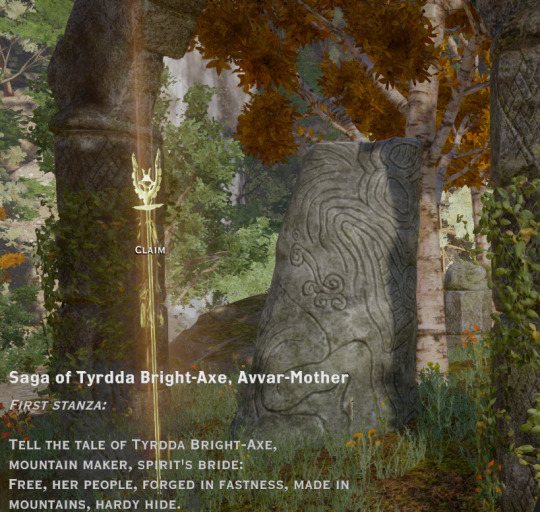
First stanza is given by the wolf/horse statue. It makes sense because it’s an Avvar/Alamarri statue, in the open, surrounded by avvar/alamarri arcs. The first stanza mostly says that Tyrdda was gifted in diplomacy and wisdom, and had a spirit as a lover who had the shape of an elf and it was considered The Lady of the Skies. Here is where the presence of elves among the Avvar shows.
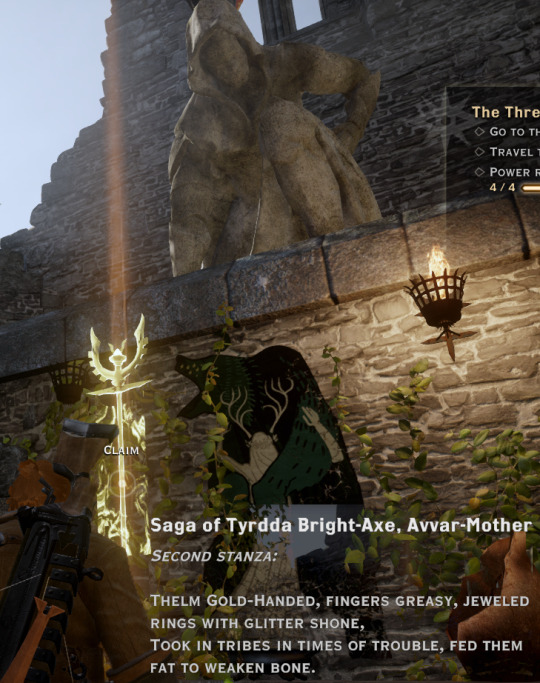

Second stanza… things begin to look very strange. It’s triggered inside the Calenhad’s foothold, which is a recent construction, but we can assume that Tyrdda lived in the zone [close to the Calenhad Lake, after all]. Inside, there are many Ferelden paintings on the walls, and in a corner, we find the statue that triggers this stanza: the one usually considered elven, representing Dirthamen [Or Falon’Din, read the post Exalted Plains: Northern Ramparts and Citadelle du Corbeau for more details on this statue]
This stanza speaks about one of Tyrdda’s suitors: Thelm Gold-Handed, who apparently was a strong warrior; took weak clans, fed them and turned them into his army giving them weapons and armour. Apparently a demon [whispers in his dreams] encouraged him to reach a Golden City in the north. Even though it sounds similar to the Chant of Light, we also have Arlathan which was considered a “golden city in the north” by humans [We know in the Shattered Library that it was blue and more like a sky], so this stanza may mean Arlathan as well as the Golden City for all what we know.
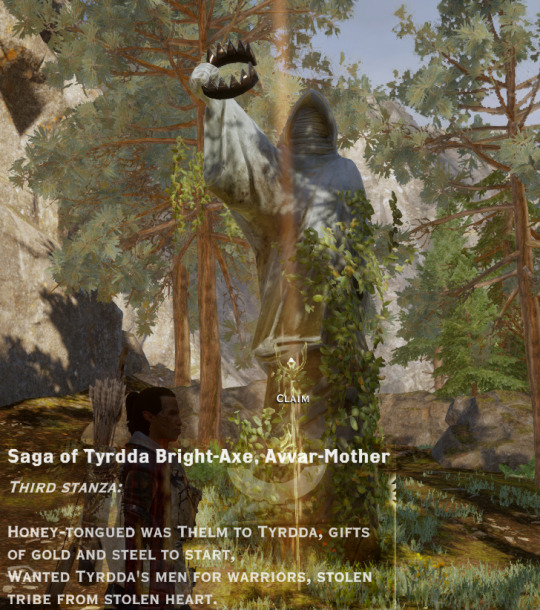

The third one is the mysterious Faceless figure holding a crown. It’s this same statue which allows you to rise an undead, which tomb shows Elvhen funerary lids. Is this statue Elven related? If the executors are an odd elvhen faction, and if that statue is an executor [simply because we can’t see their skin or face], maybe this situation could make a little more sense. So far, to me, makes no sense at all.
Updated December 2022: I finally managed to understand and justify the statue Faceless figure holding a crown. It's andrastian and represents the Maker. The stained glass of Andraste's life represents him as a figure without face with a crown that looks very similar to this one. As The Maker, it makes a lot of more sense for it to appear in the places it does.
The third stanza basically says that Thelm wanted to marry Tyrdda to have her men as part of his army to reach the Golden City. She was tempted, since her tribe was starving due to the hard winter and the promises of food in the Golden city made her hesitate. She looked for the counsel of her elven lover, who saw the lies in Thelm. So that Tyrdda rejected him.
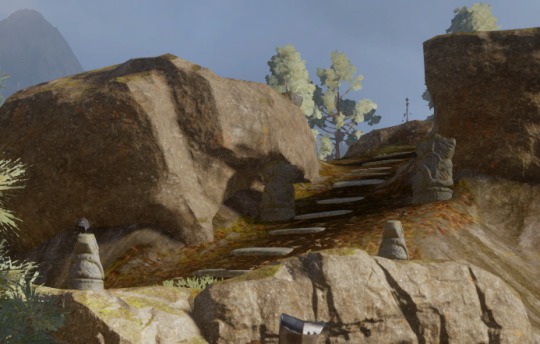

The fourth one is nicely marked on a hill through a path guided by the little guys of long arms and moustache [that I’m fond to consider the avvar representation of Dwarves with long limbs]. On its top, we find this eroded statue that looks like a dragon head [See the post Hinterlands: Statues, paintings, and structures found in the open]
The fourth stanza explains how Thelm did not take the rejection of Tyrdda well and fought her, wearing armour. He damaged her leg, but she killed him by burning him inside his armour, using the staff of her elven lover.
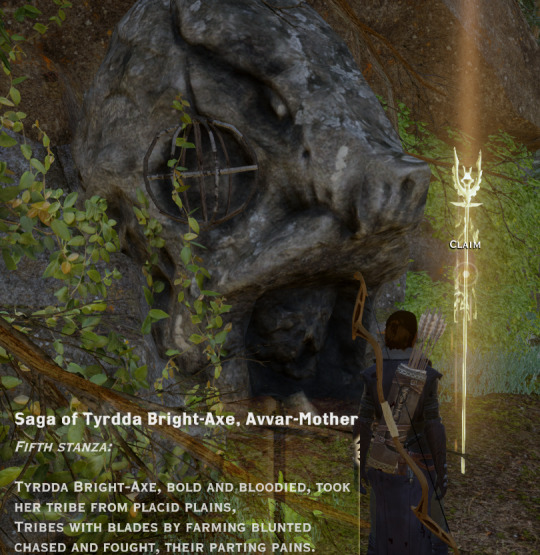
The fifth staza is triggered by a screaming head, one of the Keepers of Fear.
The stanza tells that Tyrdda took her tribe and left the Calenhad lake heading to the Frostback Mountains. They took shelter in a cave where a dragon was found. She asked for help to her elven lover, shouting her: "You I chose above a crown!" and the dragon was struck from the skies, saving the tribe.

The sixth stanza confirms my supposition that this statue is the avvar representation of a dwarf: it tells how after the battle, strong and shaped by the struggles, she went deeper into the cave reaching the Deep Roads, meeting the dwarves for the first time: Hendir’s men. The encounter was tense, ready to attack each other, until Tyrdda’s lover whispered her information to understand these men. She explained her that they were honourable, so Tyrdda chose to trade with them instead of making war.

The seventh stanza is found in the central massive sculpture of crossroads [Hinterlands] that must represent Tyrdda herself. It explains that after spending a night with her elven lover, the elf left her, whispering in her dreams that she needed to have a child in order to continue with the tribe. She had a baby with the dwarf prince Hendir, following the advice of her lover, who told her that one of her line, Morrighan'nan, “will shine in strength”.

The last stanza is found in this place where we can see one of these small sculptures with a dove that I thought were Andrastian. It says that once Tyrdda saw her tribe stable, strong and safe with the alliance with the dwarves, she put her child as chieftain of the tribe and left to the skies to reunite with her elven lover in the afterlife [sky burial].
[Index page of Dragon Age Lore ]
#avvar#avvar design#tyrdda bright-axe#Monolith with swirls#Humanoid Dirthamen/Falon'Din#Faceless figure holding a crown#Dwarf with long limbs#Eroded dragon skull#Keepers of Fear
21 notes
·
View notes
Text
Flemeth’s Fade – Part 2
Quest:The Final Piece
When heading to the room with the eluvian near the Skyhold garden, we meet Leliana who tells us that Morrigan has entered the mirror in pursuit of her son. As the Inquisitor enters the Eluvian, they realise that it leads to the Fade instead of the Crossroad. A part of the Fade that seems to reflect part of the "personal" story of Flemeth.

[This is part of the series “Playing DA like an archaeologist”]
[Index page of Dragon Age Lore]

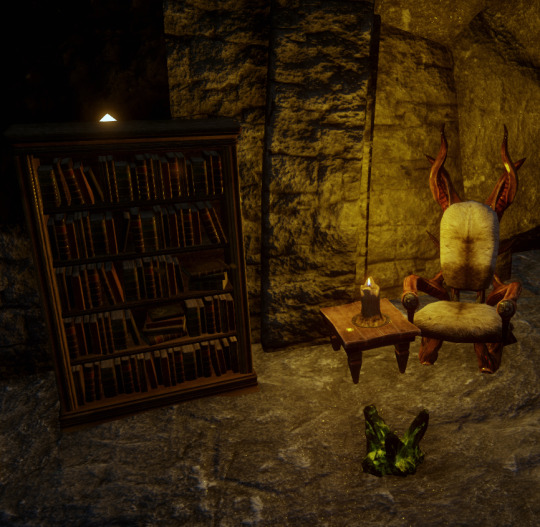
The next corridor has a small library and more Keepers of Fear.

This corridor displays an Avvar version of a Keepers of Fear clipped with a skull, and a battering ram hanging along the corridor. I honestly can’t say all these elements are telling a story, because their configuration in such a lack of context allows them to be interpreted in any way we want to fit our theories, so I will refrain to go there, but this last part of this Fade seems to show elements that are put together to mean something. Problem is, we were not given any context to frame them.


Below the battering ram, there is a rug in a piece of terrain that shows trilobites and shells, in what I think it means “a piece of the past”. The rug is the same one we can see in Skyhold when picked Chasind decoration, so I assume this is a “chasind rug”. Flanking the corridor, we find a pair of Tevinter golems and keepers of fear. I think we can suspect some narration of the kind: Chasind people attacked by Tevinter and Blight alike, based on historical context [Close to the Kocari Wild, this is the story around the construction of Ostagar]. I don’t want to abuse the lack of context to interpret this.

Then, we reach to the end of this part of Fade, finding the most polemical configuration.


The entrance to this clearing is flanked by two keepers of fear, and the statue of what has been speculated as Dirthamen’s humanoid form [which I keep calling Humanoid Dirthamen/Falon'Din] is central in this place. It has a sword in his back, potentially speaking of betrayal, and blood coming from his chest and face.


On the ground there is this typical glyph of the snake eating its own tail. Again, I don’t think we need to overthink this glyph. They are really few in the game [check General glyphs and magical symbols], and they are used in many different ways. They seem to be interpreted only as “magic”, and when they are drawn in red, it is “blood magic”. Going beyond that seems to be an excess.


The blood from the statue falls and soaks an Eroded dragon skull flanked by two clean Ferelden braziers. There are a lot of skulls and ferelden/elven urns below the blood waterfall. For a detailed analysis of this statue, read Analysis and speculation of Statues: “Humanoid Dirthamen”.

Now, I feel that all this interpretation in the linked post makes little justice to the framed scene given in the game: we see Kieran, with Urthemiel inside his body, giving energy to Myhtal, who is kneeling before him.
Scenes like this make me believe that maybe the Old Gods were entities that represented the original Gods of the Evanuris until the Elvhenan discovered the secret of godhood [which is related to the Dragon shape so far we can infer with the Ancient Elven codices, Temple of Mythal]. However, there are only two elements that one can use to sustain this idea that Mythal is respecting an Old God:
Mythal has been shown to be proud and enjoying some manners of respect towards her. Therefore, this gesture of humbleness from her speaks of deep respect for a piece of “what was once”: Urthemiel.
The way Morrigan speaks to Mythal in the Altar of Myhtal, if she drank from the well and did not have Kieran, makes us suspect that Mythal was a servant or follower from a higher entity. She says “From high priest to high priest” when she calls for Mythal, which is something that the Inquisitor doesn’t say if it is them who call for Mythal [for more details read the post about Altar of Mythal]. This could potentially be interpreted that Mythal was a high priest of a higher entity, and Morrigan, who can understand the whispers much better, knows this from them.
However, this interpretation falls apart when you check Gaider’s confirmation that the Elvhenan pantheon predates the cult of the Old Gods, but this could be a red herring too, since Gaider writes this stuff like a “Chantry scholar” and not like a dev. Or it could mean that the Old Gods worshipped by Tevinter are a bound version from the original ancient entities. We don’t know. The hint that a god stops speaking in dreams to other dreamers once it is bound to a physical form has been recently added to the lore with the DLC of Jaws of Hakkon.
The curious thing about this idea is that, if it were true, it would make sense for Flemeth, as Mythal, to kneel in front of a “God” that the Evanuris worshipped before becoming gods themselves.
Flemeth and her daughter Yavana have a particular interest in dragons, and Yavana herself says that “The blood of dragons is the blood of the world.” So, if Yavana knows as much as Flemeth, as it seems to show, it could imply that the original Gods/Creators of Thedas were a higher version of dragons. Flemeth kneeling before Urthemiel’s piece seems to go along with this interpretation. This concept is vastly helped by the lack of real knowledge about the Old Gods in any game, book, or comic. To this day, the Old Gods are a mystery to the player.
Finally, a last interpretation of this scene, based exactly on what we see, it could be simply that Myhtal was betrayed. And Flemeth is what has been left of Mythal. She is adopting the same position than the statue. The statue represents an event similar to what Mythal suffered; she was betrayed and slain as Abelas told us. Her blood was spread on items of Avvar nature, in particular in a statue that looks like an eroded dragon skull.
Still, it’s an odd thing to see this hooded figure in this situation and not Myhtal’s statue, which would make much more sense in order to allow this interpretation.


Anyways. It’s in this place where we find Flemeth and Kieran. Flemeth kneeling before the child, accepting something from Urthemiel or recharging her power. It’s not clear what’s happening here.



As Morrigan wants to stop this, Flemeth commands the one who has drink from the Well to stop her. When she does it, a blue colour appears in her eyes. Similar effect than an activated eluvian. The power she invokes has the same effect that Kieran had in front of her. This makes us suspect that maybe Urthemiel is the piece of an Evanuris, but I find it hard to believe. That would make the Old Gods represent each of the Evanuris [which we have been told is not the case], but at the same time, I don’t think Flemeth would kneel in front of one of her first executioners when she is so filled with rage of revenge now.
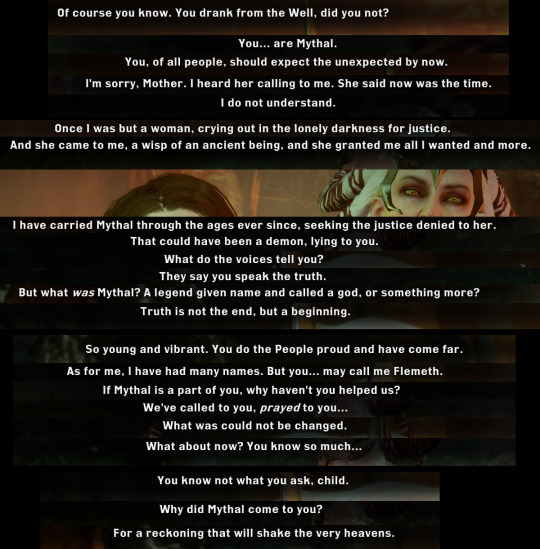

Here some truths are revealed:
Flemeth is Mythal, or at least she has a piece of her. Flemeth and Mythal are something similar to Anders and Justice, so merged that is hard to separate one from the other.
Mythal is something much more complicated than an ancient being for what Flemeth says.
Flemeth can perceive her servants.
The human that was Flemeth was betrayed, and was left alone in the darkness asking for Justice. Mythal came, a wisp of an ancient being, and made her powerful and granted her all what she wanted [Justice?]
Flemeth now seeks justice for Myhtal. One assumes it has to be related to the Evanuris.
An elven Inquisitor can reproach her not to hear them. Flemeth answers that “what was could not be changed” [So far I understand, it implies that the Death of Mythal changed things]. Apparently, asking Mythal now for help is something terrible [”You know not what you ask”, which is an answer that we usually hear from characters that have fallen from grace and their powers are darker. It could also mean that telling the Dalish all the truth about how much they had embraced the symbols of slavery would hurt them more than restore them.]
Mythal came to Flemeth explicitly for Revenge, looking for a “reckoning that will shake the very heavens”. If we remember that elvhen are partially spirit in nature, all these previous comments from Flemeth make me think that Mythal changed her purpose [from motherly justice and discipline to vengeance], or twisted her nature after her death. It could have been because she was reborn and changed [as the Avvar and Solas explain that happens with spirits] or because something twisted and altered her nature [something like the Blight or Red Lyrium]
Part of these cryptic comments are the reason why I wonder if she is not related to the Blight as a way to kill the Evanuris and have her revenge [given their hard-to-kill nature].

By picking options, we find some extra detail: When the inquisitor asks Flemeth is she has an idea what they are fighting against [Corypheus] she answers as if this would have been an old enemy too.

Then, Morrigan and Flemeth speak:
Flemeth seems to keep supporting the idea of preserving the powers of the past. She taught this into Morrigan, but clearly there is an ulterior reason.
“Things happened that were never meant to happen”. This is a strange way to say things, and considering how flexible the elvhenan magic was, I wonder if this kind of wording does not imply that the elvhenan had, at some point, a degree of control over the passage of time, time travel or vision of the future. Rift magic has been proven to stop and delay time, after all. It could also be a mere manner of speech.
Flemeth and Mythal, both betrayed in similar way as the world was betrayed, find each other through the ages to look for revenge.
“So long as the music plays, we dance” [once more, Flemeth keeps using these musical wordings that are not by chance random; we know that in DA world, there are songs in archdemons and darkspawn, inside the elves, and inside the blood of the titans. Which music she refers to is hard to say.
There are several versions of the origin of Flemeth. The inquisitor narrates one of them. Flemeth doesn’t seem to correct it.
Flemeth confirms what we have been seeing in books and games: she intervenes in the history of the humanity to change it, because she has a goal to reach: she saved Manric so he could sire Alistair. Alistair will be a Grey Warden she saves, and later, canonically, will be the king of Ferelden in oder to have “old blood” that will allow awakening Great Dragons [comics]. She also saved our Warden in order to ensure the preservation of Urthemiel or maybe she has other reasons for them [we know now that our surviving Wardens are looking for the cure to the Blight]. She saved Hawke close to Lothering so the war between mages and templars would finally escalate all over Thedas. She has always find a way to keep the darkspwan far away from her hut even when the worst of it was in the Kocari Wilds. She is a mastermind who has been arranging the pieces of a big puzzle and pulling the strings along the ages. This is the main reason why the first thing we see in this Fade is a hand with hanged dead bodies over a table.
She seems to see her servants as something more than slaves. She is surprised of the Inquisitor to ask if they are a servant. Since being bounded to Mythal is not a permission or something forced upon the servants, but something you work for, it seems natural that she doesn’t see this condition as a slave-servant. It seems to be that Mythal’s servants have to earn that position. It’s not only willingly, they have to work hard to get it.
Still, Flemeth seems to imply that she will eventually command the Inquisitor to do things for her.
The only thing that Flemeth wants is Urthemiel’s soul in Kieran. Here we read once more how darkness can be poetically refer to the Blight.

Seeing how much Morrigan loves her son, Flemeth accepts the piece of Urthemiel from Kieran and frees him. At the end of this scene, when Morrigan returns to Skyhold, she explicitly says that this whole situation has been a test of Flemeth. And I think it was a test of Empathy and motherhood that Mythal did on Morrigan to be sure she is the next “adequate” one where the piece of Mythal will jump into. [Dev’s notes]

It’s implied that Kieran was having particular dreams due to the presence of this piece of Urthemiel in him. This is new lore, because so far we know, all the characters that were possessed by spirits had no particular dreams. This may be a specific Old God attribute.
Here, Flemeth says something very valuable lore-wise: a soul is not forced upon the unwilling. If this applies to all spirit-related situations, to the Evanuris, and the Archdemons, this would explain why demons always need to be “accepted” before possessing, or why an Archdemon, when jumping into the blighted body of a Grey Warden who kills it, dies: the grey warden is not accepting the new soul willingly. This also would explain why a fetus is a good receptor for an ancient soul: there is no soul to ask for permission yet, apparently. Or it’s too weak still.


When Flemeth leaves and they return to Skyhold, we learn that
Kieran is now free of that spirit, and feels lonely. This situation with Kieran seems to be what we learnt in Jaws of Hakkon: how a mage kid can be safe if they are possessed by a good spirit that teaches them magic. Clearly Kieran could manage powerful magic to open the eluvian to the Fade thanks to the spirit inside him that may have taught him. But once the spirit is gone, the mage in question feels lonely [reason why Sigrid did not performed the separation with her spirit, read Stone-Bear Hold Avvars - Part 1]
Certainly, we can see here that the Old Gods were more than mere soul-less dragons. They are powerful spiritual entities. Hence my suspicion about them being the original gods that the Evanuris worshipped before they discovered the secret of godhood. Sadly, this contradicts a bit what Gaider explained in forums, even though the format of that text felt more like a in-game scholar speaking than a dev providing us meta-data.
Morrigan insists that the magic of old must be preserved. And she does this because Mythal taught her to.
Morrigan suspects that what happened in the Temple of Mythal was Flemeth’s doing too. And Abelas’ words, if he dies, seem to confirm this suspicion.
#flemeth#Playing DA like an archaeologist#fade#the fade#kieran#Humanoid Dirthamen/Falon'Din#mythal#Tevinter golem
12 notes
·
View notes
Text
Emerald Graves: The open
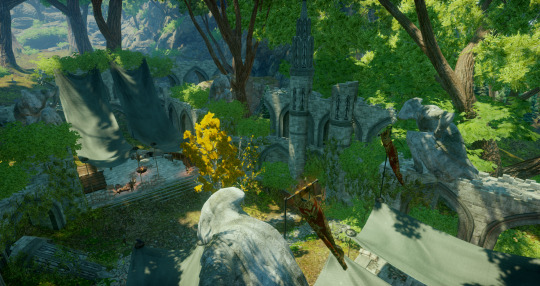
The Emerald Graves is a forested region of the Dales in Orlais. The area is an ancient elven burial ground but has been partly occupied by Orlesians in more recent times.
[This is part of the series “Playing DA like an archaeologist”]

When we enter to the zone for the first time, the camp where we are is in an elven ruin called “Andruil’s wall”. Over it, there are four hooded figures that, in the Exalted Plains, we assumed to be a representation of Humanoid Dirthamen/Falon'Din. This identification is not completely sure, though.

These figures are on the wall, as if they were watching the mortals that walk along them.

We find another pair of these statues in the entrance/exit of this zone towards the Exalted Plains. It’s called Harrow, so I’m not sure how to understand this. If the name is an elven translation or a human name added later [most likely the latter].

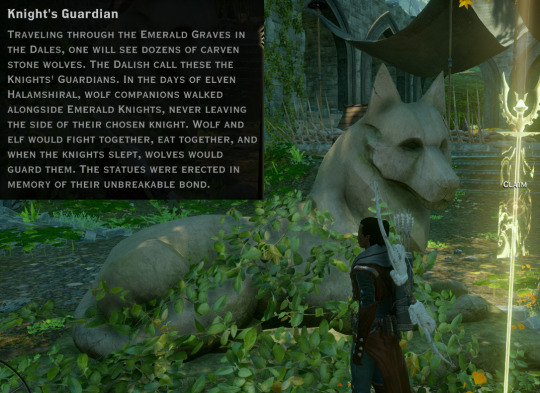
Another camp is made inside an elven ruin, which front has three owl statues and in the middle of the ruin, a single Fen’ Harel statue which triggers the codex: Knight's Guardian.
I would usually not trust Genitivi as a source when it comes to Ancient elves, but this one is about the Elves of the Dales. This period of time was recorded, with its flaws, by the incipient Chantry. We also see in Exalted Plains that there are Fen'Harel statues on tombs all over the place. The Canticles of the Chantry also represent the Shatran's elves [who are pretty close in time to these elves] as wolves.
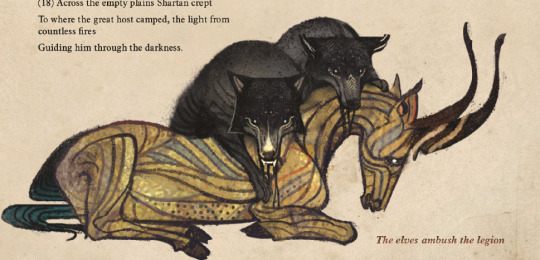
It's easy to see how wolves were seen more benign in this past time by the elves than nowadays by the modern Dalish. So this codex in particular may have some degree of truth, since this concept that the Emerald Knights had wolf companions was, in any case, something that the Chantry could plainly see in their fights against the elves. It's not a matter of interpretation of Elven culture. So, considered within this context, this piece of information is more or less valuable: we see this fact, it's not a mere interpretation from Genitivi.
Another proof of the presence of wolves among these Dalish is present in the epitaph of Sulan in the Vallasdahlen graveyard: Sulan always walked with a wolf at his side.
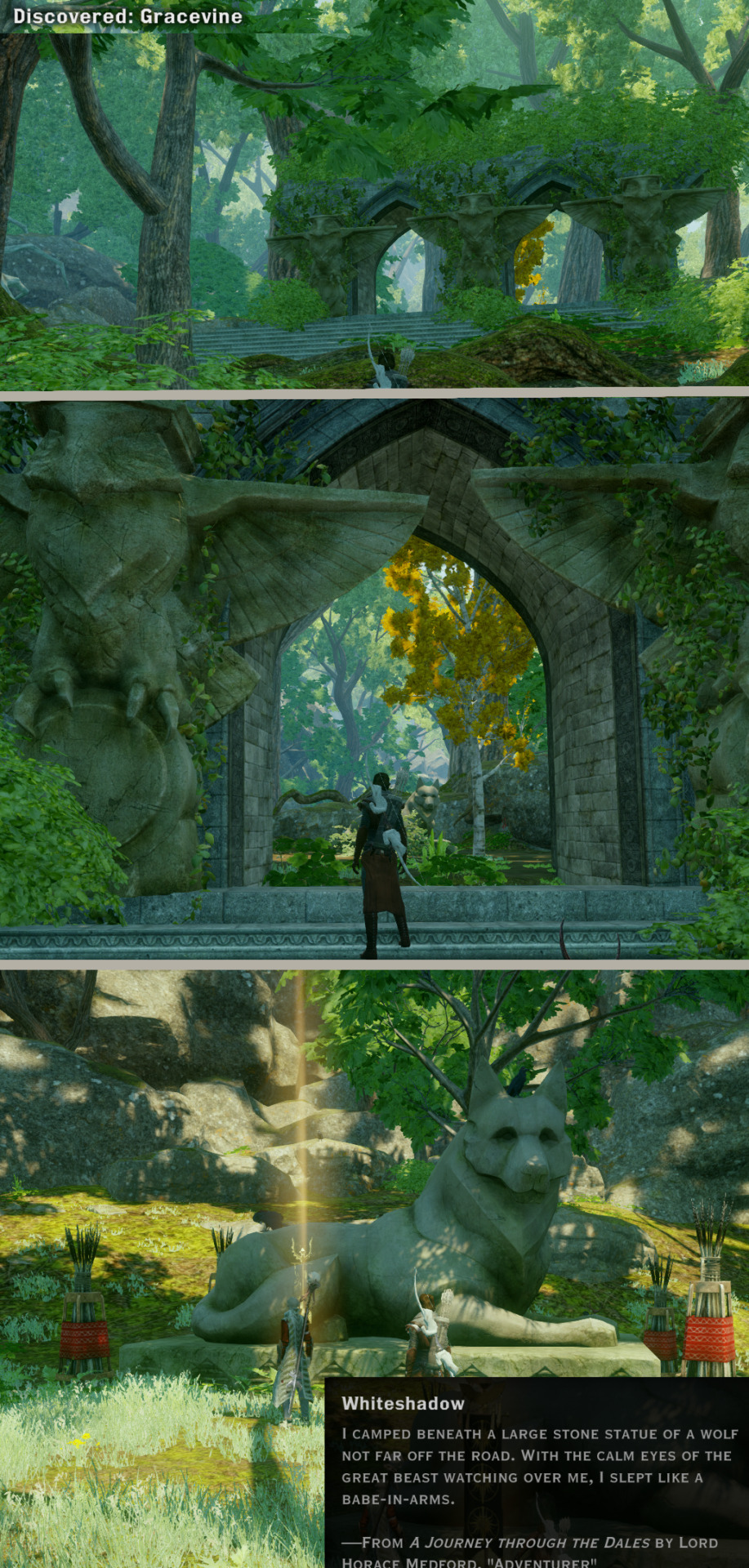
Another camp with similar structure is this one, which triggers the unreliable landmark of Whiteshadow. It’s a “nice” piece of information to “reinforce” the idea that these wolves were protectors for these elves during the time of the second age, but… le’ts be honest, this piece of information, specially coming from this orlesian wanna-be scholar is lame. It’s always about his subjectivity and feelings inspired by each place he visits. His lack of objectivity and procedure enrages me, lol.


Exploring the area we find Veridium Mine, where some freemen and freewomen ended up being captured here. The place clearly is a very old, abandoned, eroded elven ruin: the entrance shows the typical ancient elven patterns one expects in the entrance of any elvhen ruin. Both sides of it are decorated with owl statues [which always has in its talons the golden ring] Some walls have the usual elven paintings: the yellow halla, the elves riding black hallas, the black halla with elves wearing vallaslin, and the armoured figure. More details in Nation Art: Elvhen.

Exploring the map offers strange little corners with not much room for interpretation: The silver falls are a small waterfall which has elven paintings of the “shifting” halla.



Many paths are marked by owls, showing a direction. This is hard to interpret because raven, owls or crows could be symbols of Dirthamen, but we also learnt that Andruil's messenger is also considered an owl [Of course, all this coming from Dalish tales, which accuracy is always problematic]. The game reminds us again this confusion in order to have it quite present: Dorian voices out this confusion. The game doesn't want us to stick an elven name to this owl with 100% confidence. So... these paths were meant to guide people towards a goal related to any of both gods.
However, these paths tend to be quite creepy since they are decorated with elven paintings like the ones seen in Nation Art: Elvhen. If one can assume that these elven paintings represent the creations and alterations of Gihlan'nain, it could be likely that these path are led by Andruil's messenger.


It's hard to identify places with these dense tree canopies. However, we find a place where two hart statues stand out. The enormous stones where they rest have big elven paintings: the yellow halla and the black halla with elves wearing vallaslin.
All over Emerald Graves we find The Diary of Troilus Hertubise in places similar to this one. In this diary, a scholar called Troilus, seems to be studying the Fade rifts, calling them "Menace". Unlike the other scholars, this one seems to be extremely objective. They try to measure all what they can about the rifts: pulsations, sounds, shape, creatures that pours. Their mission was to close the rifts, but they were unsuccessful and died. There is a sketchbook note that one suspect it belonged to the same scholar. It comments about a demon described as a giant, slavering creature with large ears and a snout.



Following a path marked by owls leads us to a small dense forest with many inukisuit. Each of them triggers a landmark, which updates a codex called Vallasdahlen. At the death of a Dalish fighter in the Dales conflict, they buried them with a tree that now grows strong. Each of these “green graves” are marked with a snuckshuk. Important Dalish such as the first of the Emerald Knights are buried here. It looks like during that time, June seemed to have more presence among the Dalish than now, since they revived the ancient arts of Arlathan [or at least, that's what Genitivi says]. A weapon carried by a Hight Priest of June takes an important role in this past: the Evanura, which was lost after the fight of the Dales. Here, we read as well that Sulan constantly had a wolf at his side.

The path to the secret room opened with the solution of all the astrariums is marked and guided by owls as well.

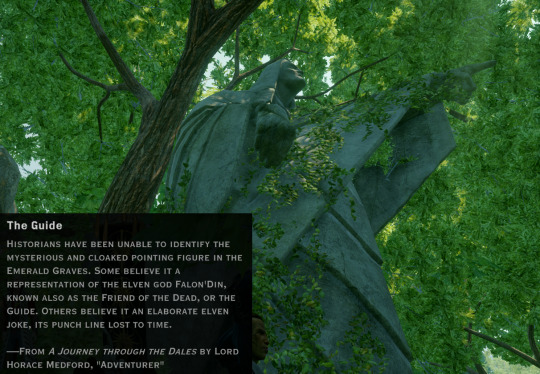
Another statue that stands out in this forest is “the guide”. I’m not sure how much we can trust the note that it triggers: The guide. It’s written by this orlesian scholar who lacks of deep knowledge of elven culture. The only link they do with Falon’Din is that it “guides”. Once more, considering how Falon’Din and Dirthamen are entangled one another, this could also be a statue representing Dirthamen. The shape of the sleeves has some reminiscence to the Owl statue [they have long lines along it], but once more, both gods are so distinguishable one another that it’s hard to say who is who.

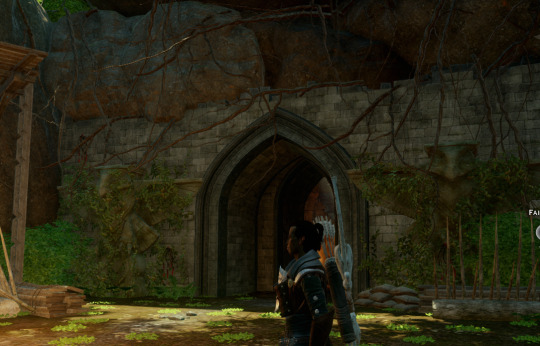

If we follow the paths along the forest we can find Watcher’s Reach. The path has some owls along the way, and the place, once we reach it, has owl statues at the entrance, and elven paintings on the wall. There is also once more that hooded figure, watching down, as it has been doing in many camp places. Here, the triggered landmark is The Watcher, which source is even more unreliable than the orlesian scholars: this is a comment in Fairbank’s journal. The only interesting information, worth trusting, is that no elf knows who this statue is. Which is not of much help.
Here, in Watcher’s reach, we find Fairbanks and there is no much to say in terms of important historical information.
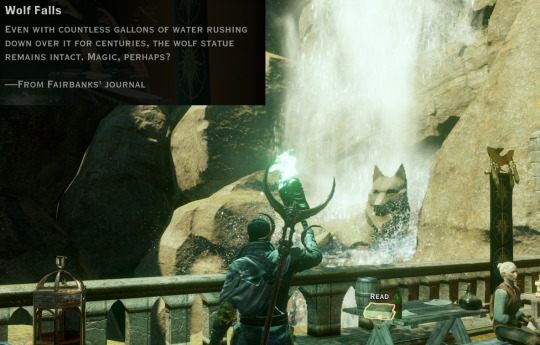
Inside this place we find a waterfall with a Fen'Harel statue under it. The note we obtain makes us notice that it's not eroded at all, assuming the statues have power over the centuries. This reminds me to the Temple of Mythal, where we saw for the first time that those dragon sculptures with swirls and patterns on its body were used as runes to cast energy for defensive purpose. We saw this when one of these statues destroyed Corypheus in a cinematic.



Following yet another path decorated with owls, we reach to a natural "wall” made of stone with elven paintings. Following beyond we find the place where the dragons lays.


This place, now occupied by the dragon, had a particular and important position in the configuration of ruins across the map. It seems to be originally a circular building, not big enough to consider it an arena or ring, though. It's entrance was flanked by Dragon Myhtal statues [they can be seen broken now].
At the cliff, there is a tree called Twisted tree. On its base, a Fen'Harel's statue was erected. This landmark triggers The Twisted Tree from this orlesian scholar that has little knowledge about elves. Again, this information seems extremely unreliable: it's written by the same scholar who called "broken dog" to a Fen’Harel statue in the Exalted Plains; and he is sharing this information here when it is a tale told in a tavern. Awful, lol.


At some point we find Elgar'nan's Bastion, a ruin that looks small on the surface, but it's vast underground. More details in Emerald Graves: Din'an Hanin, Elandrin’s Tomb.
Here, we find the First of the Keeper we met in the Exalted Plains. He informs us about important details of this place: this is Din'an Hanin: a graveyard of the Emerald Knights, who protected the elven borders from human invasion. Most of them fell during the Exalted March of the Dales. There is a tomb sealed since the Second Age [meaning after the Second Blight] where this elf expects to find some bits of contemporary history of the elves. He is speaking about Elandrin's tomb.

All over Emerald Graves we find Andraste statues that trigger the landmarks of Andraste’s Promise, Light, Mercy and Strength. They are related to words of a Chantry sister, with little value to me.
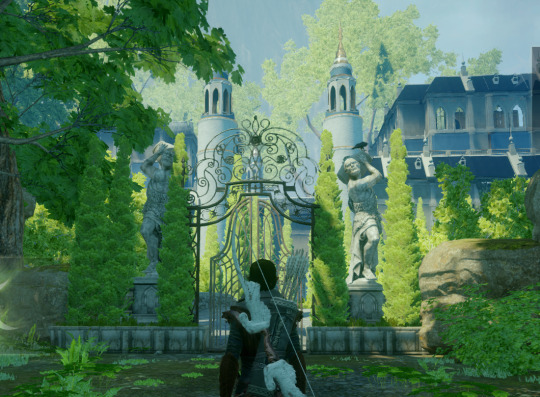
Among orlesian buildings in the middle of this forest, we have the Chateau D’Onterre, Villa Maurel, and Lion’s Pavillon, which Orlesian style stands out in the green forest of the Emerald Graves.

Lion’s Pavilons is a small resting place with some bits of orlesian art and statues, and some information on its boards. We find the landmark, where Genitivi tells us about human, chantry-related figures [which is safe to trust a bit more since he is more careful with that kind of information] highlighting how the emperor Valmont’s skills were far less diplomatic than his contemporaneous descendants [meaning, the empress Celene].


As a detail I found curious: Solas makes this comment when we are close to the Emerald Knight graves; he speaks of “his people” at a time in the game when we already had that conversation about how his people are not the Dalish and how disconnected he is from them. This comment makes me to take more seriously this zone simply because it may have hold a piece of the ancient elvhenan empire. When we walk around the Vallandahlen, Solas confirms that he had been here once. When? We don’t know. Clearly not during the time of the Dalish Empire, since he has been slumbering since the creation of the Veil up to a year before the Inquisition.
[Index page of Dragon Age Lore ]
#Emerald Graves#Playing DA like an archaeologist#Humanoid Dirthamen/Falon'Din#Sitting Fen'Harel statue#Elven Owl statue#Elven hart statue#Elven Archers#Paintings#inuksuit#Red inuksuk#The guide#Andrastian design
9 notes
·
View notes
Text
Emerald Graves: The open
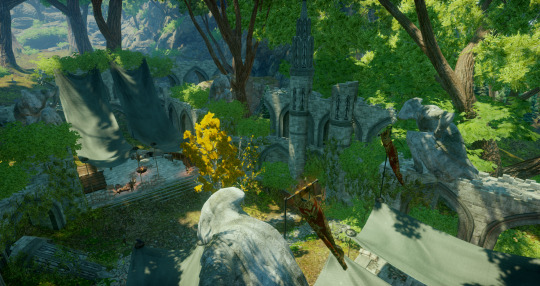
The Emerald Graves is a forested region of the Dales in Orlais. The area is an ancient elven burial ground but has been partly occupied by Orlesians in more recent times.
[This is part of the series “Playing DA like an archaeologist”]
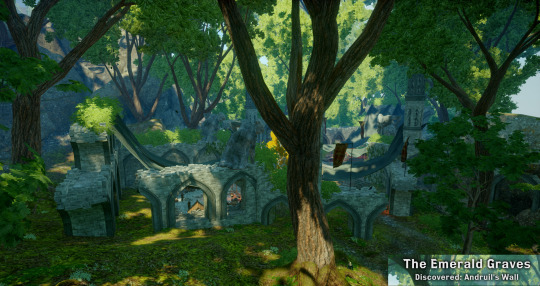
When we enter to the zone for the first time, the camp where we are is in an elven ruin called “Andruil’s wall”. Over it, there are four hooded figures that, in the Exalted Plains, we assumed to be a representation of Humanoid Dirthamen/Falon'Din. This identification is not completely sure, though.
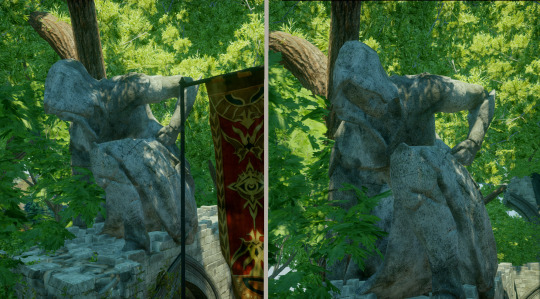
These figures are on the wall, as if they were watching the mortals that walk along them.

We find another pair of these statues in the entrance/exit of this zone towards the Exalted Plains. It’s called Harrow, so I’m not sure how to understand this. If the name is an elven translation or a human name added later [most likely the latter].
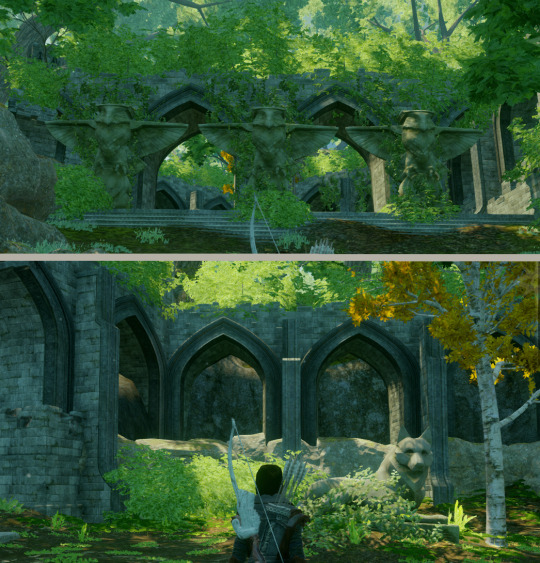

Another camp is made inside an elven ruin, which front has three owl statues and in the middle of the ruin, a single Fen’ Harel statue which triggers the codex: Knight's Guardian.
I would usually not trust Genitivi as a source when it comes to Ancient elves, but this one is about the Elves of the Dales. This period of time was recorded, with its flaws, by the incipient Chantry. We also see in Exalted Plains that there are Fen'Harel statues on tombs all over the place. The Canticles of the Chantry also represent the Shatran's elves [who are pretty close in time to these elves] as wolves.
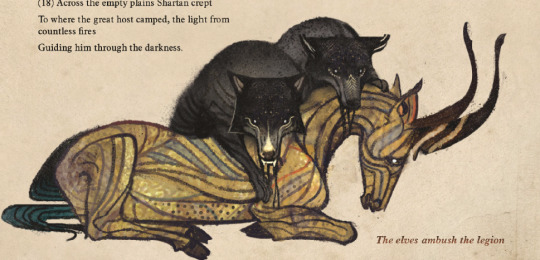
It's easy to see how wolves were seen more benign in this past time by the elves than nowadays by the modern Dalish. So this codex in particular may have some degree of truth, since this concept that the Emerald Knights had wolf companions was, in any case, something that the Chantry could plainly see in their fights against the elves. It's not a matter of interpretation of Elven culture. So, considered within this context, this piece of information is more or less valuable: we see this fact, it's not a mere interpretation from Genitivi.
Another proof of the presence of wolves among these Dalish is present in the epitaph of Sulan in the Vallasdahlen graveyard: Sulan always walked with a wolf at his side.

Another camp with similar structure is this one, which triggers the unreliable landmark of Whiteshadow. It’s a “nice” piece of information to “reinforce” the idea that these wolves were protectors for these elves during the time of the second age, but… le’ts be honest, this piece of information, specially coming from this orlesian wanna-be scholar is lame. It’s always about his subjectivity and feelings inspired by each place he visits. His lack of objectivity and procedure enrages me, lol.
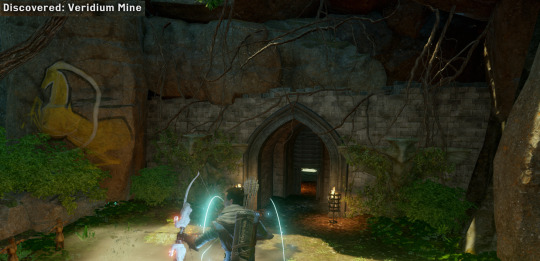

Exploring the area we find Veridium Mine, where some freemen and freewomen ended up being captured here. The place clearly is a very old, abandoned, eroded elven ruin: the entrance shows the typical ancient elven patterns one expects in the entrance of any elvhen ruin. Both sides of it are decorated with owl statues [which always has in its talons the golden ring] Some walls have the usual elven paintings: the yellow halla, the elves riding black hallas, the black halla with elves wearing vallaslin, and the armoured figure. More details in Nation Art: Elvhen.

Exploring the map offers strange little corners with not much room for interpretation: The silver falls are a small waterfall which has elven paintings of the “shifting” halla.


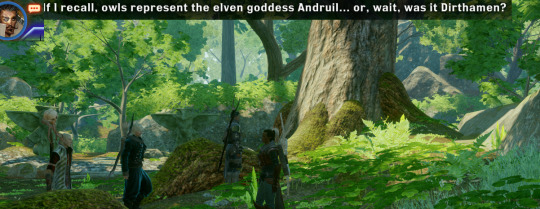
Many paths are marked by owls, showing a direction. This is hard to interpret because raven, owls or crows could be symbols of Dirthamen, but we also learnt that Andruil's messenger is also considered an owl [Of course, all this coming from Dalish tales, which accuracy is always problematic]. The game reminds us again this confusion in order to have it quite present: Dorian voices out this confusion. The game doesn't want us to stick an elven name to this owl with 100% confidence. So... these paths were meant to guide people towards a goal related to any of both gods.
However, these paths tend to be quite creepy since they are decorated with elven paintings like the ones seen in Nation Art: Elvhen. If one can assume that these elven paintings represent the creations and alterations of Gihlan'nain, it could be likely that these path are led by Andruil's messenger.


It's hard to identify places with these dense tree canopies. However, we find a place where two hart statues stand out. The enormous stones where they rest have big elven paintings: the yellow halla and the black halla with elves wearing vallaslin.
All over Emerald Graves we find The Diary of Troilus Hertubise in places similar to this one. In this diary, a scholar called Troilus, seems to be studying the Fade rifts, calling them "Menace". Unlike the other scholars, this one seems to be extremely objective. They try to measure all what they can about the rifts: pulsations, sounds, shape, creatures that pours. Their mission was to close the rifts, but they were unsuccessful and died. There is a sketchbook note that one suspect it belonged to the same scholar. It comments about a demon described as a giant, slavering creature with large ears and a snout.
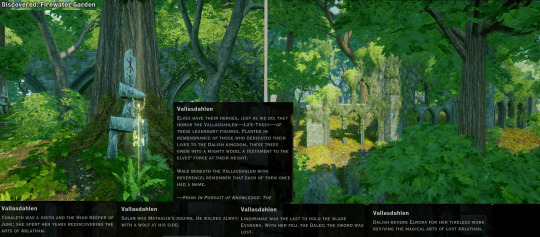


Following a path marked by owls leads us to a small dense forest with many inukisuit. Each of them triggers a landmark, which updates a codex called Vallasdahlen. At the death of a Dalish fighter in the Dales conflict, they buried them with a tree that now grows strong. Each of these “green graves” are marked with a snuckshuk. Important Dalish such as the first of the Emerald Knights are buried here. It looks like during that time, June seemed to have more presence among the Dalish than now, since they revived the ancient arts of Arlathan [or at least, that's what Genitivi says]. A weapon carried by a Hight Priest of June takes an important role in this past: the Evanura, which was lost after the fight of the Dales. Here, we read as well that Sulan constantly had a wolf at his side.

The path to the secret room opened with the solution of all the astrariums is marked and guided by owls as well.


Another statue that stands out in this forest is “the guide”. I’m not sure how much we can trust the note that it triggers: The guide. It’s written by this orlesian scholar who lacks of deep knowledge of elven culture. The only link they do with Falon’Din is that it “guides”. Once more, considering how Falon’Din and Dirthamen are entangled one another, this could also be a statue representing Dirthamen. The shape of the sleeves has some reminiscence to the Owl statue [they have long lines along it], but once more, both gods are so distinguishable one another that it’s hard to say who is who.



If we follow the paths along the forest we can find Watcher’s Reach. The path has some owls along the way, and the place, once we reach it, has owl statues at the entrance, and elven paintings on the wall. There is also once more that hooded figure, watching down, as it has been doing in many camp places. Here, the triggered landmark is The Watcher, which source is even more unreliable than the orlesian scholars: this is a comment in Fairbank’s journal. The only interesting information, worth trusting, is that no elf knows who this statue is. Which is not of much help.
Here, in Watcher’s reach, we find Fairbanks and there is no much to say in terms of important historical information.

Inside this place we find a waterfall with a Fen'Harel statue under it. The note we obtain makes us notice that it's not eroded at all, assuming the statues have power over the centuries. This reminds me to the Temple of Mythal, where we saw for the first time that those dragon sculptures with swirls and patterns on its body were used as runes to cast energy for defensive purpose. We saw this when one of these statues destroyed Corypheus in a cinematic.



Following yet another path decorated with owls, we reach to a natural "wall” made of stone with elven paintings. Following beyond we find the place where the dragons lays.


This place, now occupied by the dragon, had a particular and important position in the configuration of ruins across the map. It seems to be originally a circular building, not big enough to consider it an arena or ring, though. It's entrance was flanked by Dragon Myhtal statues [they can be seen broken now].
At the cliff, there is a tree called Twisted tree. On its base, a Fen'Harel's statue was erected. This landmark triggers The Twisted Tree from this orlesian scholar that has little knowledge about elves. Again, this information seems extremely unreliable: it's written by the same scholar who called "broken dog" to a Fen’Harel statue in the Exalted Plains; and he is sharing this information here when it is a tale told in a tavern. Awful, lol.
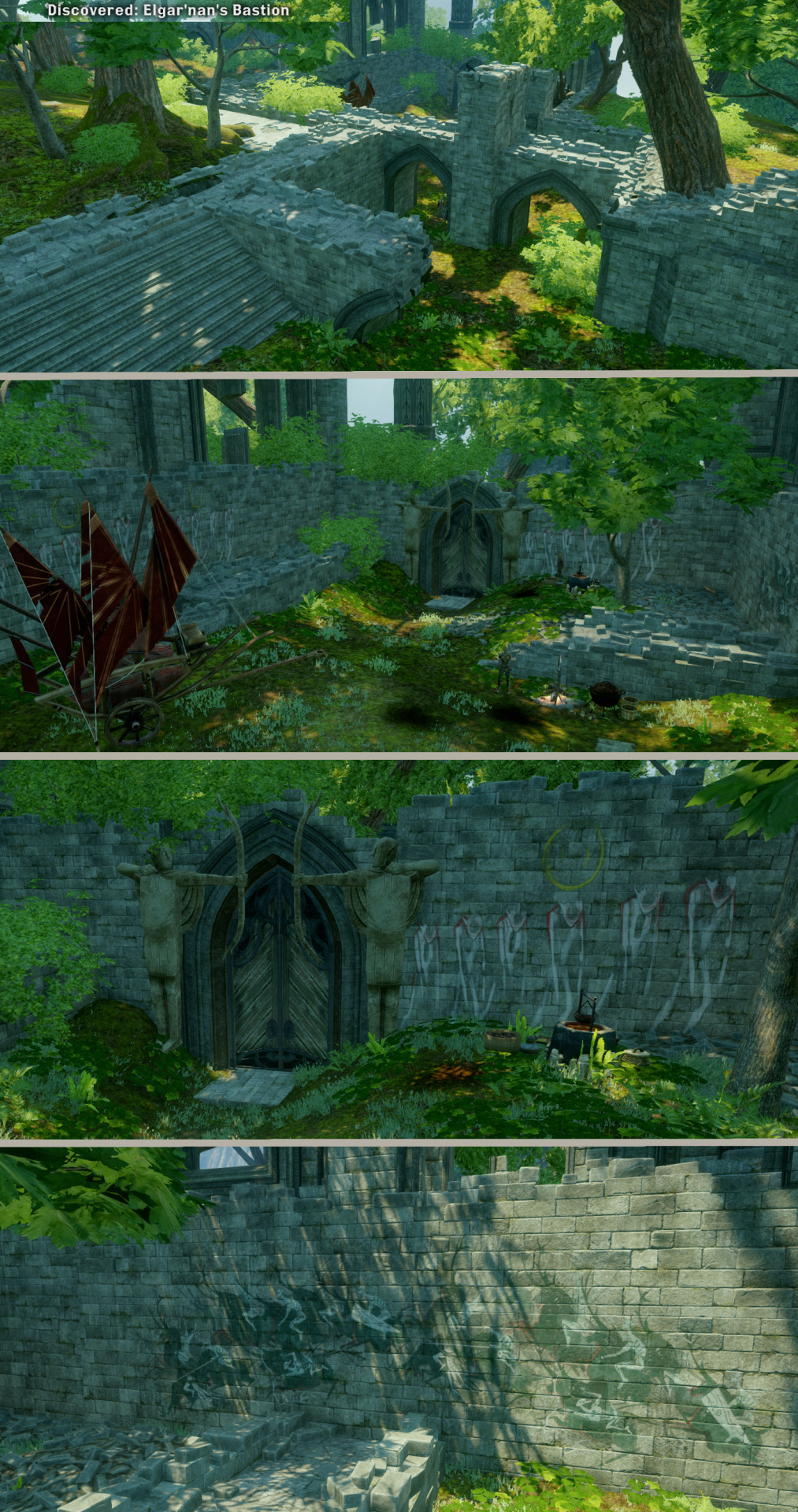

At some point we find Elgar'nan's Bastion, a ruin that looks small on the surface, but it's vast underground. More details in Emerald Graves: Din'an Hanin, Elandrin’s Tomb.
Here, we find the First of the Keeper we met in the Exalted Plains. He informs us about important details of this place: this is Din'an Hanin: a graveyard of the Emerald Knights, who protected the elven borders from human invasion. Most of them fell during the Exalted March of the Dales. There is a tomb sealed since the Second Age [meaning after the Second Blight] where this elf expects to find some bits of contemporary history of the elves. He is speaking about Elandrin's tomb.

All over Emerald Graves we find Andraste statues that trigger the landmarks of Andraste’s Promise, Light, Mercy and Strength. They are related to words of a Chantry sister, with little value to me.

Among orlesian buildings in the middle of this forest, we have the Chateau D’Onterre, Villa Maurel, and Lion’s Pavillon, which Orlesian style stands out in the green forest of the Emerald Graves.

Lion’s Pavilons is a small resting place with some bits of orlesian art and statues, and some information on its boards. We find the landmark, where Genitivi tells us about human, chantry-related figures [which is safe to trust a bit more since he is more careful with that kind of information] highlighting how the emperor Valmont’s skills were far less diplomatic than his contemporaneous descendants [meaning, the empress Celene].


As a detail I found curious: Solas makes this comment when we are close to the Emerald Knight graves; he speaks of “his people” at a time in the game when we already had that conversation about how his people are not the Dalish and how disconnected he is from them. This comment makes me to take more seriously this zone simply because it may have hold a piece of the ancient elvhenan empire. When we walk around the Vallandahlen, Solas confirms that he had been here once. When? We don’t know. Clearly not during the time of the Dalish Empire, since he has been slumbering since the creation of the Veil up to a year before the Inquisition.
[Index page of Dragon Age Lore ]
#Emerald Graves#Playing DA like an archaeologist#Humanoid Dirthamen/Falon'Din#Sitting Fen'Harel statue#Elven Owl statue#Elven hart statue#Elven Archers#Paintings#inuksuit#Red inuksuk#The guide#Andrastian design
6 notes
·
View notes
Text
Exalted Plains: Northern Ramparts and Citadelle du Corbeau
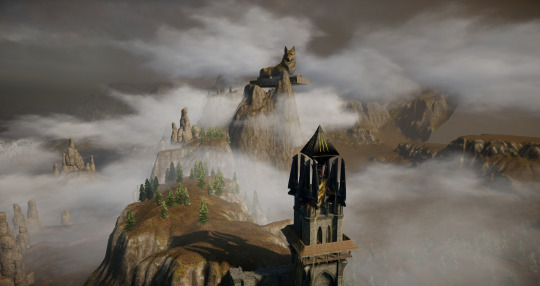
The large fortress known as Citadelle du Corbeau was claimed after the second Exalted March. Originally an elven keep, the Orlesians who seized it never discovered its true name, although they did find the magical wards the elves set in place. Mages of the Orlesian Circle spent years studying these defenses, but the occupiers never fully understood them.
[This is part of the series “Playing DA like an archaeologist”]
From afar we can see in the horizon the big statue of Fen’Harel towering over the strange pointy tower some kilometres away from it.

When you approach to see it in detail, the tower looks unmistakably Tevinter. It was done stacking and pilling up Tevinter objects, like the diapason-like or claw-like artefact and a Tevinter pyramid. This structure is built on an elven ruin, and it’s directed to a city below: Citadelle du Corbeau.

The tower has a complete cover of the Citadelle. This zoom in allows us to understand that, despite what we are going to read in codices or what the Orlesians will tell us, this tower in particular is not Elven. It’s made with Tevinter assets.


To access to the citadelle, we have to cross the bridge which is decorated with a big pair of statues of Andraste.
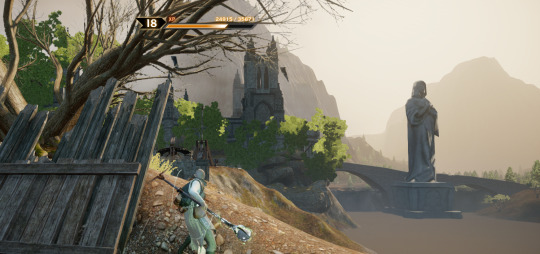
From afar, we see another bridge, but it is impossible to reach in game. We also see another statue of Andraste in the middle of the river.

This part previous to reaching the entrance of the Citadelle, where we have to deal with all the undead in the rampart, is quite boring and has not much to offer than previous ramparts didn’t do already. So move on.
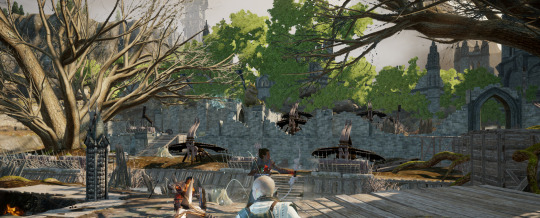
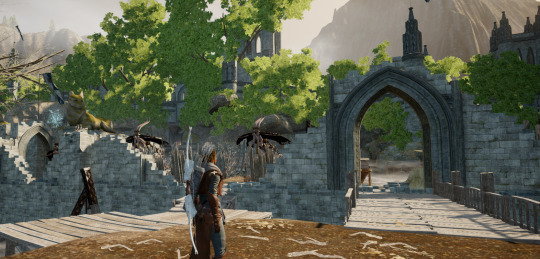
It’s easy to identify the remnants of the elven ruin. There are big tree that feels like vhenadahl, and many Strange Skull-Dragon totems which keep rising the dead.

As we approach the entrance, we find four Fen’Harel statues protecting it. From the main gate we see the impressive appearance of a revenant which will drop eventually an items called Rendor's Blade, suggesting that this item belonged to a Ferelden hero/Knight who liked ambushing Orlesians, and now his body has been possessed by the demons of this place.
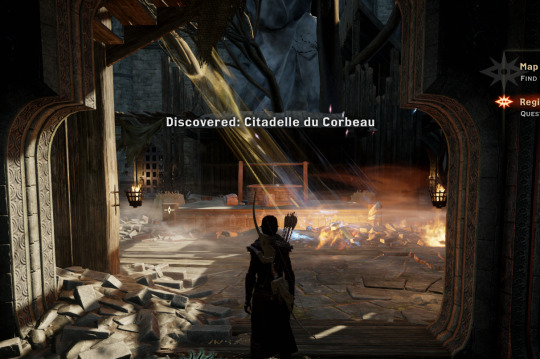

We finally reach the Citadelle du Corbeau [meaning, the citadel of the crow]. Immediately close to the entrance we see a statue of a squatted hooded figure we have seen in the Emerald Dreams. It's a bit hidden since a big tree [another vhenadahl?] has grown around it. It triggers the landmark called The Raven. This information seems to be provided by humans trying to understand elven ruins that have been modified with Tevinter elements, and they can't see the difference between the styles. So, I'm not so sure how much we can trust in this note. We know that Dirthamen may be related to raven, crows or owls due to the elven glyph information we collect along the game. But since his image is so fused with Falon'Din, who may have the same animals as his representations or even as his companions, it's almost impossible to spot with accuracy what truly represents Dirthamen in a unambiguous way. Hence I call this statue: Humanoid Dirthamen/Falon'Din

Personal speculation: I'm not very convinced this statue represents Dirthamen, because as this landmark explains, it seems to have some magical property that makes its shadow look like dark wings. We know via Mythal's Temple’s codices, that Falon'Din was related with dark/death wings, commanded by Elgar'nan. On the other hand, Dirthamen was called Falon'Din reflection [according to an Orlesian scholar who had shown a more sceptical approach to all elven ruins offering second interpretations that seem to be more rich and, sometimes, even accurate in contrast with the ancient elven scripts we find in elvhenan temples] and Falon'Din was called Dirthamen's shadow. If what we see in this statue's shadow is a pair of dark wings, it means that we are seeing Falondin's shadows. So, playing with the same words we were given, the statue is Dirthamen’s reflection?. Since both twins are incredibly and horribly intertwined in any piece of information we find, it’s always impossible to know who is who. Therefore, this statue may be Falon’Din’s as well as Dirthamen’s in my opinion. It also would make sense if we consider that maybe both of them, as Evanuris, were one. In the Shattered Library we read information that may suggest them as one possessing the other, or two souls merged, like Flemeth and Mythal.
The next thing we see in this city is that a deadly ray of energy is all over the city, killing anyone who tries to walk in the open.
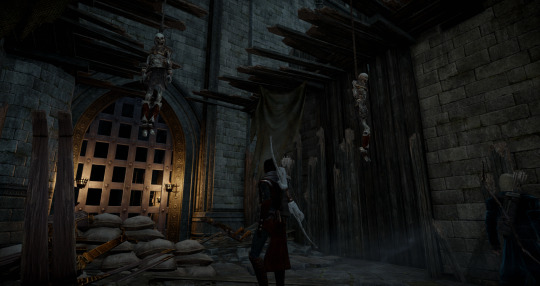
As we explore the citadelle, we can find the elvhen ruins mixed with orlesian's precarious buildings that may have been built during the Exalted March or now during the War of the Lions, I don’t know . We find some wounded people who tell us that there are more orlesian troops trapped in the city.
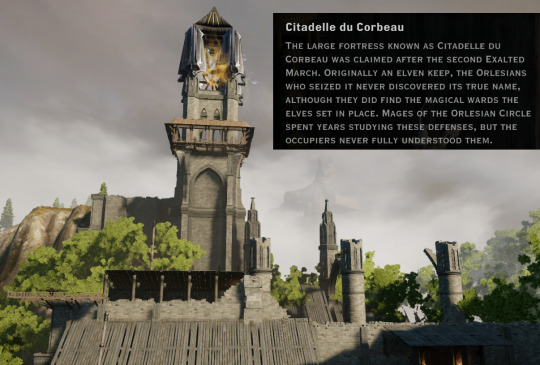
I believe this note is one of the most interesting ones. On one side, it says that the original elven keep has not a known name, and was called Citadelle du cobeau by the orlesians. The humans could not learn its original name but they found the magical wards "that elves set in place". Orlesian circle mages studied them but they could not figure them out.
I'm not sure how much to believe that "elves set these wards in place". On the other side, these Dales elves were able to put Andraste statues in their elven temples, so there is some possibility that they may have tanken tevinter magical devices to fight during the Exalted March.
There are two possibilities:
The Tevinter device was here before the Dales elves took the keep to fight against the Exalted march. They figured it out how to make it work and humans believed the Dales elves placed them there.
The Tevinter devices were installed by Dales elves in a desperate attempt to fight the Exalted march.
I don't have a preference. It's hard for me to decide. What is clear is that, unlike the other regions in the map, The Dales seem to be quite free from Tevinter ruins or influence: the only ones we find are the astrarium in the Emerald Graves. Exalted Plains has no Tevinter presence at all, not even the astrarium. In this whole region, only this defence device and the strange tower in the ramparts decorated with Razikale Ceremony lid and the Horned warrior holding a sword are the only elements suggesting Tevinter presence. I'm a bit inclined to think that maybe the Elves of the Dales took and co-opted Tevinter devices. A bit of this can be seen in the DLC with Ameridan, who used the devices of Razikale Reach to keep Hakkon at bay, and he not only knew how it worked, that he also added Andrastian passages to its mechanism.
Maybe the humans that had said this mechanism was implemented by the elves were telling the true.


This citadelle is quite big and intricate to walk around. Along the chaos, there are some elven statues scattered through the streets.

When we finally deactivate the defences and find the trapped orlesians, we are informed that they, in an attempt to desperately fight the undead, activated the ward but then they could not turn it off. They hid inside a chamber, holding until reinforces could come. Many died trapped outside.
[Index page of Dragon Age Lore ]
#Exalted Plains#playing DA like an archaeologist#Sitting Fen'Harel statue#Tevinter objects#Andrastian design#elven design#Humanoid Dirthamen/Falon'Din
6 notes
·
View notes
Text
Emerald Graves: Din'an Hanin

Din'an Hanin is a large elven ruin found in the southeastern region of Orlais, in Elgar’nan’s Bastion. It is the final resting place of the Emerald Knights. Since the end of the Exalted March of the Dales and the fall of elven Halamshiral, Din'an Hanin has remained abandoned and largely forgotten.
It’s important to notice this is not exactly an “ancient elvhen” ruin. It’s an Elvhenan building taken by Ancient Dalish and turned into a ruin after the Exalted March of the Dales. This is very important to highlight to understand the iconography we are going to see here.
[This is part of the series “Playing DA like an archaeologist”]

In my opinion, the clarification of the time in which Halamshiral shone is key to understand this ruin. This tomb will reflect exactly the same spirit that Ameridan showed in the Frostback Mountains, DLC of Jaws of Hakkon.

As we enter Din'an Hanin, we see a stair surrounded by the undeniable shape of elven buildings with statues: we find a broken Humanoid Mythal’s statue on the ground, and two howling Fen’Harel. Mythal statue triggers fragments of the codex The Emerald Knights. The first fragment we have here seems to be a warning to me: Curse the past where lies were born. There is also another detail in this fragment: they call Andraste as “Lady”. There is respect to her. If contemporary history is to be believed; we know she helped the Dalish to have these lands, so it seems reasonable for them to respect her.

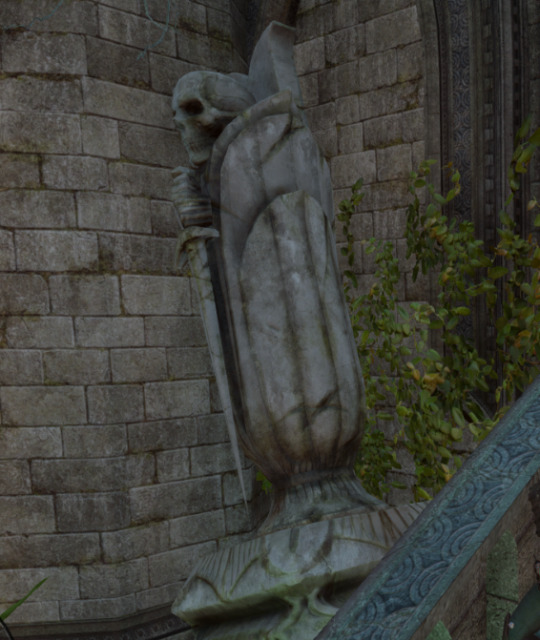
On the other side of the stair, we find one of the most strange statues to see in elven ruins: The cursed Skull bud with sword.
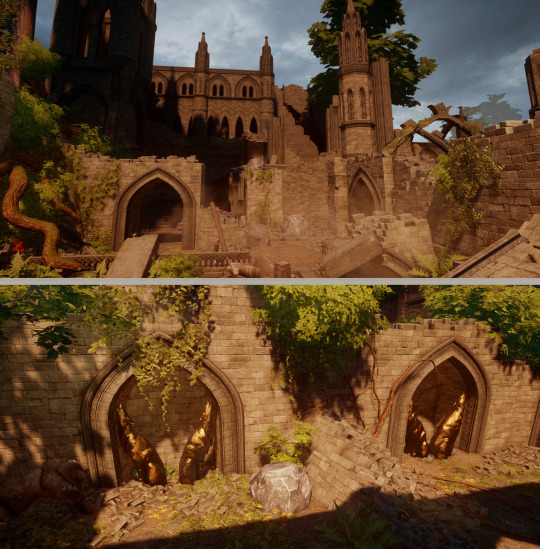
As we continue going ahead, we see more parts of the place that was attacked during the Exalted March, the rubble sinks deep enough in the terrain to assume it’s old destruction.
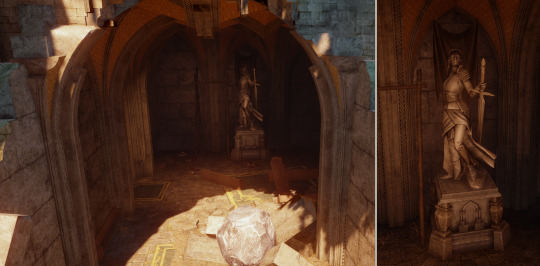
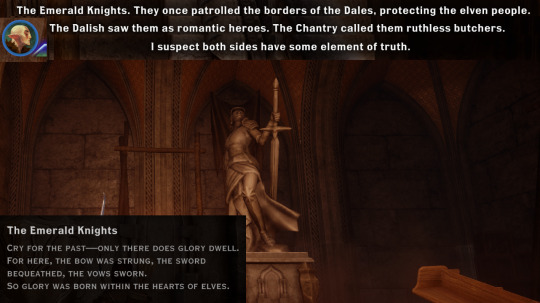
When we are reaching the entrance of the building, we meet another strange statue. We know with total certainty that these statues are Andraste, in her shape of a warrior. We have seen them everywhere in the game, and specially in Val Royeaux, triggering codices and notes about her. So, this is speaking to us that in a ruin of the time of Halamshiral, Andraste was honoured among the Dalish. She triggers another part of the codex The Emerald Knights.
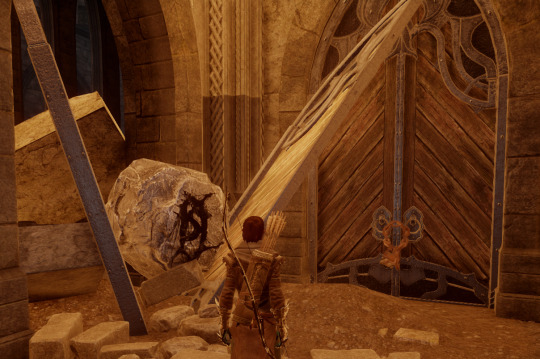
We see more attacks of those days, collapsing parts of the ruin and making it inaccessible. This rock is likely to be from an Orlesian attack.


In the Hall of the Knights, we see ceilings that speak of ancient elven ruins, and statues of Owls which triggers the codex of Arlathan: Part One, an unreliable tale of Gisharel. Curiously, there is another statue hidden among the shadows: The Strange Idol‘s face. It’s repeated in most of the arcs.
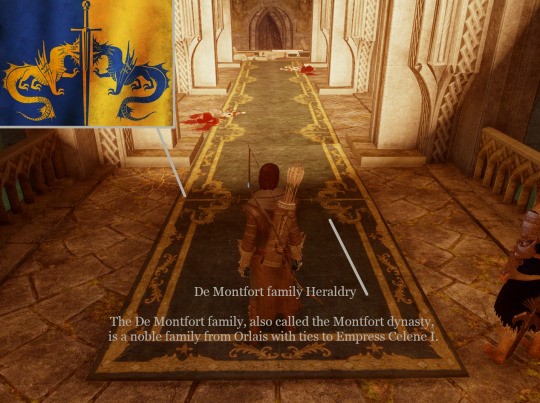
Continuing the path towards the tombs, we reach the corridor of the first floor, finding another strange element that speaks about how these elves were Dalish and not Elvhenan: the rugs in these parts display the symbol of the family of Celene’s mother: De Montfort.
This is very curious because this family begins to raise in prominence around the time of the Fourth Blight, while these Emerald Knights of the Exalted March were alive around the Second Blight. That this rug is here could mean that this place was explored before, or this family has very old ties with elves, specially during the time it was not an important family. With the context we were given about the Dales and the interracial examples of relationships, it’s not strange to assume that maybe this family is elf-blooded. But this goes into the speculation field. The only fact we see is that this rug with the De Montfort symbol is here, during a time [around the Second Blight] in which the family was not prominent.
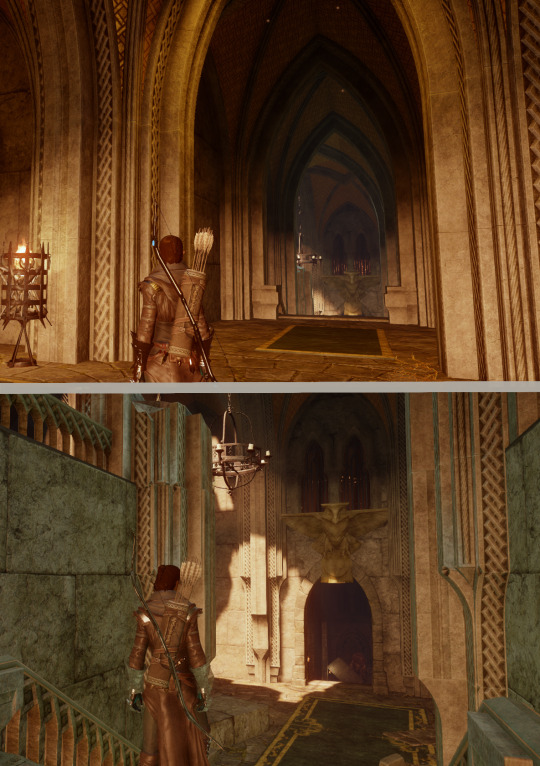
At the end of the corridor, we begin to walk downstairs to head into the tombs. We see the strong elements of the elvhen decorations and the Orlesian rug.

We make our way to the Hollowed Tombs. I think this name explains a bit the structure we will see inside. The entrance welcomes you with howling Fen’Harel statues at the sides.
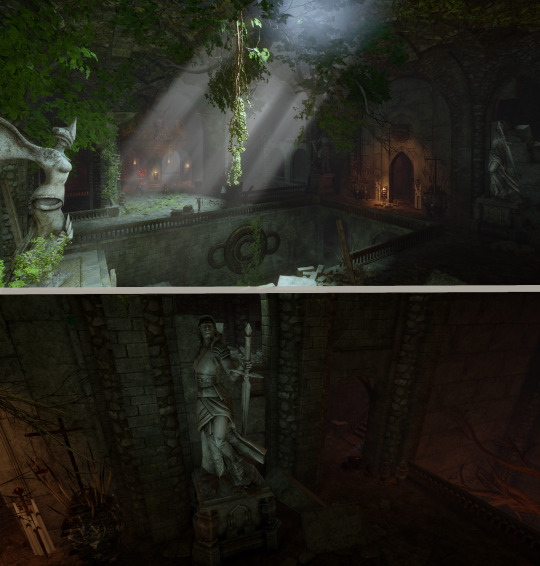
The place is already underground. It shows a mixture of Dalish, Elvhenan, and Chantry elements. Exactly the same kind of amalgamation of cultures we saw in Ameridan during the DLC Jaws of Hakkon. These elves were less radical with their culture as the current Dalish are, and they allowed the Chantry to permeate their elven temples to the point of placing statues of Andraste in them.
This brings a natural question: if they did this centuries ago, how much were their tales changed when they added Andrastian flavour in them? The culture that the modern Dalish want to preserve has been altered centuries ago by their own people too, not only Tevinter. The Dalish cultural process and attempts to recover their culture is an incredible tragedy and irony at the same time.
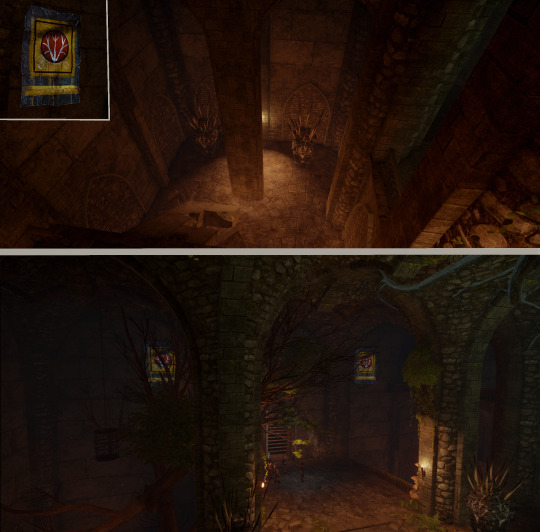
Going on with the exploration: at the sides of the entrance there are some pits interconnected with corridors. They show the inuksuit we always see related to funerary places. High up, close to the ceiling, we see Dalish banners.

This is the object that says this place of elvhenan origin has been taken by Dalish at some point.
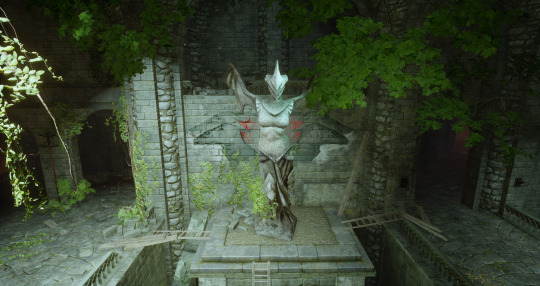
The central figure of this temple is Mythal, no doubt. The pit surrounds her, and her statue stands out among the others. Behind her, there is one of the typical paintings of ancient elves, this one I call “the shifting” halla or the bounded halla [for details read Nation Art: Elvhen].

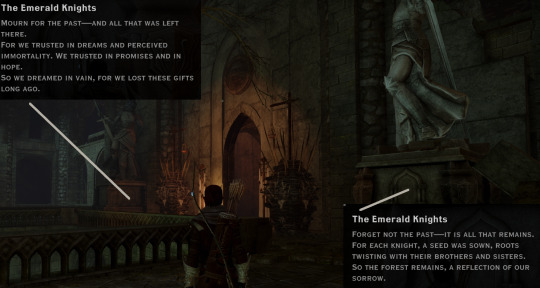
Exactly in front of this Mythal statue we find an entrance with the face of The Strange Idol on its top, flanked by two statues of Andraste that trigger more fragments of the codex The Emerald Knights. This entrance is blocked with rubble, but if you cross it with the fly cam and follow the path of the stairs, you reach exactly to the entrance of Elandrin’s tomb, where The Strange Idol is.


At the left side of the statue of Mythal, we find columns decorated with elven owls, and beyond them, a vandalised figure of Mythal. This is quite strange to me. It’s the statue of humanoid Mythal, with a skull on her head. The only detail I remember seeing in similar fashion in the series was in the Fade of DAO, where a statue of Andraste had her head replaced with a skull.
I can only find two potential reasons for this:
The ancient one: I imagine that so many iconography with broken statues of Dragon Mythal along the game, and this vandalism of her statue may be related to the hatred that she earned from the other Evanuris. We know that after all, she ended up being assassinated by them. And unlike the Temple of Mythal, where there are really few statues of broken Dragon Mythal, the rest of the elvhen ruins depict a lot her dragon figure without her head.

The modern one: maybe these Old Dalish elves related Andraste to a representation of Mythal, and her death [which happened before the complete fall of Halamshiral] was represented by them this way.
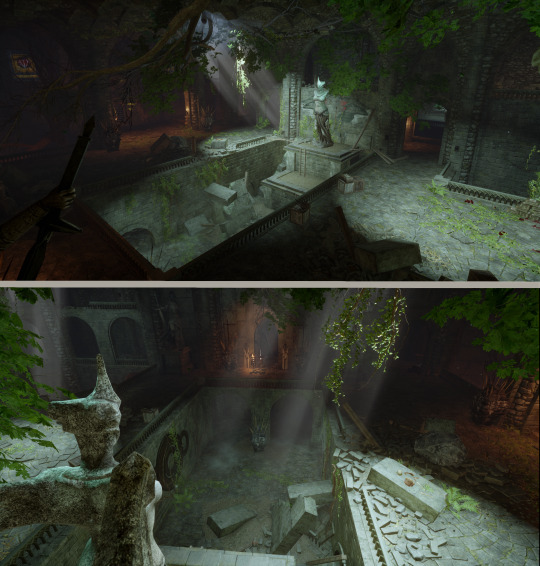
The configuration of this place is similar to the one we will see in Elandrin’s tomb: the main figure, [in this case Mythal] is in front of a pit. If the pit were filled with supplicants, they would be seeing her from a very low place. Unlike the Elandrin’s tomb, this pit doesn’t seem to have a system to raise the lower platforms. It must have been destroyed with the collapse of the place or simply it never had it.
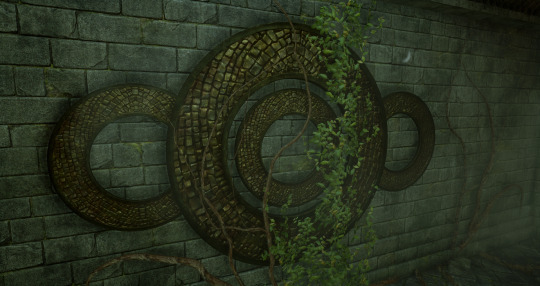
What’s most intriguing is the symbol on a side of one of the pit walls: these golden rings are Elvhenan. We saw them in the Shattered Library. The Elvhenan statue of the owl always has one of these on its talons.
In here, there are three rings of the same size, all aligned, and one bigger and thicker, surrounding and containing the middle one.
As potential links, we can have a quick reading of the many codices in the Shattered Library where concentric spheres are overlapped, or world in spheres are created. There is also a link with the red lyrium idol: the main figure has an arm crossing the same kind of ring than these. This figure has several links, specially if we take into account the murals of the series [For more details check: Red Lyrium Idol and Nation Art: Elvhen. It’s safe to assume that this is a symbol that belonged to the Elvhenan, and can’t be a representation of the creation of the Veil. When Solas created it, all the temples and tombs of the elvhenan had already been built, depicting this ring in their monuments or murals [More details in Nation Art: Elvhen].

If we explore the pit below and see what its corridors have to offer, we can see that at our left, the corridor is quickly blocked. It’s filled with funerary inuksuit...


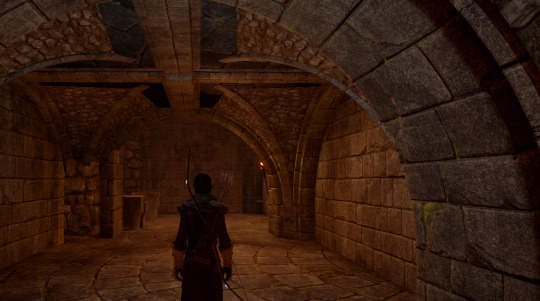
...while the corridor at our right side allows us to explore many other rooms. We see in these pits a lot of arcs that were filled with bricks before. When you destroy them, you have access to new rooms. This is curious, but given the name of this chamber [hollowed tombs], it seems to be a characteristic of this place: hollowed rooms are sealed with bricks containing mostly urns and/or special runes and veilfire messages of mourning.

Some of these pits have stairs that allow you to leave these corridors, but they have a strange feeling when you see the ancient paintings of slaved elves on its walls. If this is a tomb and we are right in assuming that Falon’Din was meant to guide the dead, but also this was a misunderstanding of his vanity that caused the death of many just for his whims, I wonder if these pits had an “elvhenan” function related to the slaves. What I mean is that maybe the Ancient Dalish used this ruin to give sepulchre to their warriors or honour Andraste, but this is an ancient elvhen ruin which must have had a different function long time ago.


Anyways, returning to the main statue of Mythal, we see the painting detail on the back, and if we see the rooms behind this wall, we find more elvhenan paintings and sealed rooms of dead. We see the painting of the dark armoured figure and breached walls [which I think it’s safe to assume it must have been the Venatori we find inside.] On a table, we see a book that triggers the Arlathan: Part Two, again an unreliable tale by Gisharel.

In the sealed rooms, we find dead, urns, paintings, and bones. Occasionally some of these structures trigger codices or notes about fallen Emerald Knights.

Sometimes these rooms are just locked but have no much difference with the others funerary rooms.

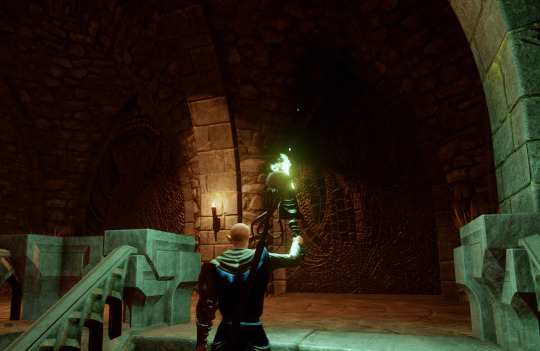
Close to the Andraste’s statues in the main chamber of Hollowed Tombs, there is a stair that allows you to reach the highest level of this tomb.

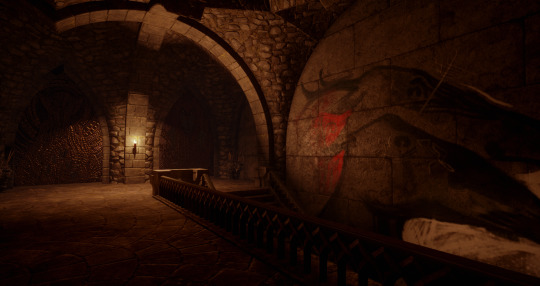
As we walk upstairs, we find the typical mosaics of the Evanuris: Dirthamen and Falon’Din, one beside the other, and a painting of a “shifted” / bounded halla along the stairs [Read The Lost Temple of Dirthamen - Part 1 to understand my supposition of how this halla could also represent “bounding process” specially when it is related to Dirthamen and Falon’Din].
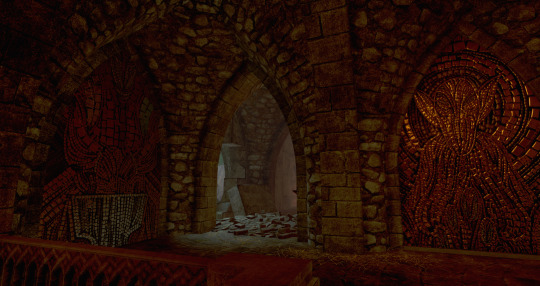
Around this place we find more mosaics: June with his anvil and Mythal with her babies.
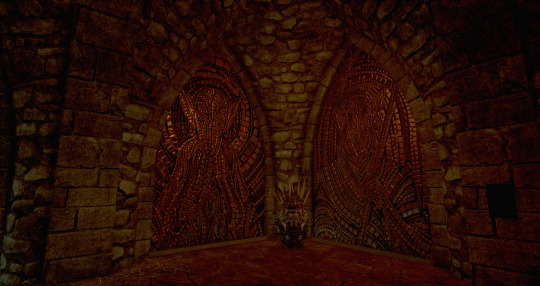
Mythal and Falon’din, which we know they had a confrontation [Solas’ words in the Temple of Mythal]. All these mosaics are normal ones in terms of colours [meaning, there is none red or weird so far I noticed].
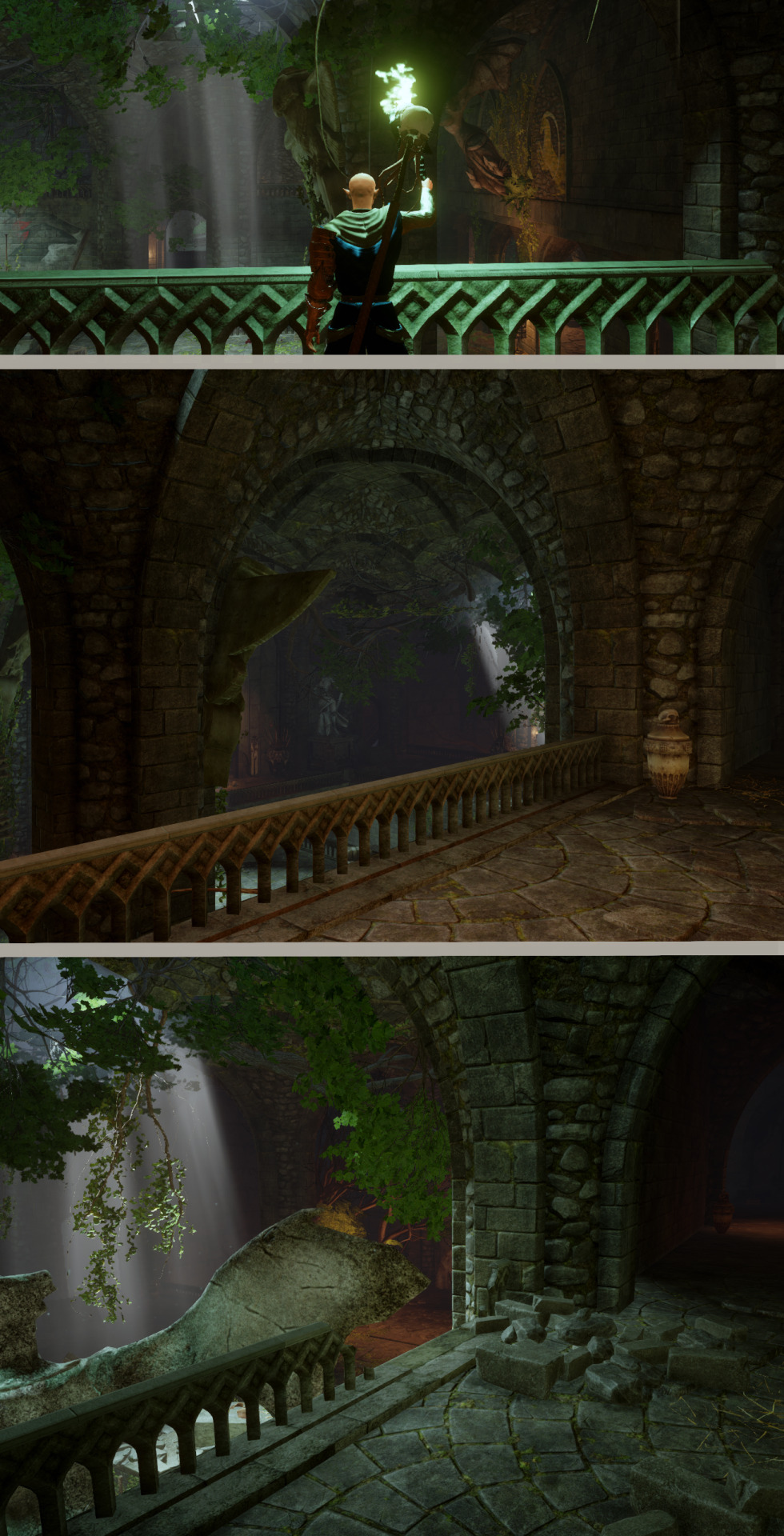
From the highest level, we can see the main statues and the pits. It gives the impression that this is a place where high priests could oversee all the rituals below, but since it has fences, it also seems to be a place for observation instead of imparting rituals. If we compare it with the Temple of Mythal, where the highest places were big, high stages for the priests to impart their blessing on the petitioners. This one here seems more like a mere overseer level.
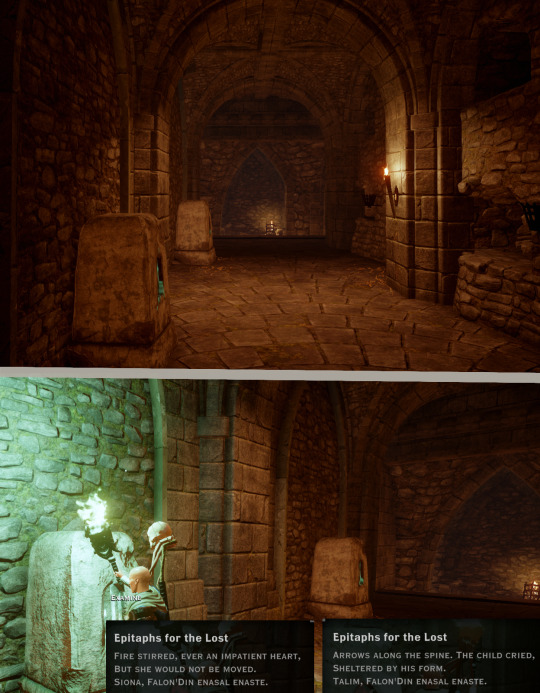
Along these corridors in the highest level we find more of these objects that trigger Dalish epitaphs.
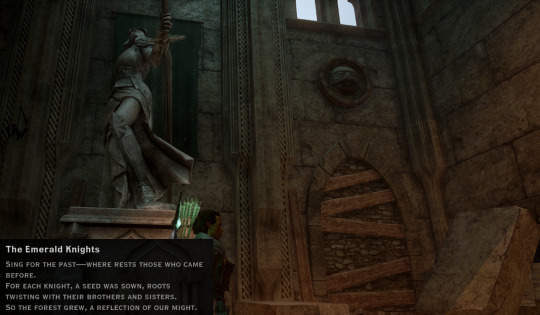
The last statue that triggers the final part of the codex is beside a corner that seemed to head to Elandrin’s tomb, as the face of the strange idol on the top may indicate. Once more, we see these entrances sealed, likely as part of the tradition: seal the rooms of the dead.
[Index page of Dragon Age Lore ]
#paintings#Howling Fen'Harel statue#Skull bud with sword#Humanoid Mythal statue#Elven Owl statue#The Strange Idol#De Montfort Symbol#Golden ring#inuksuit#Evanuris Mosaics#Andrastian design#dirthamen#Falon'Din#mythal#june#Playing DA like an archaeologist
22 notes
·
View notes
Text
Arbor Wilds: Temple of Mythal - Part 3
Main Quest: What Pride Had Wrought
The Temple of Mythal was a place of justice, where petitioners walked religious rites of passage in order to have their pleas for justice heard by Mythal. According to some, it is also the site of some mysterious religious artefact called the vir'abelasan.

This post contains the following sections
Entrance to the Temple
The Rituals
Ancient Crypts: Red Templar's way
[This is part of the series “Playing DA like an archaeologist”]
[Index page of Dragon Age Lore]
Entrance to the Temple

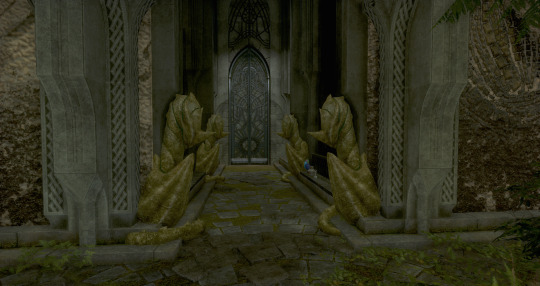
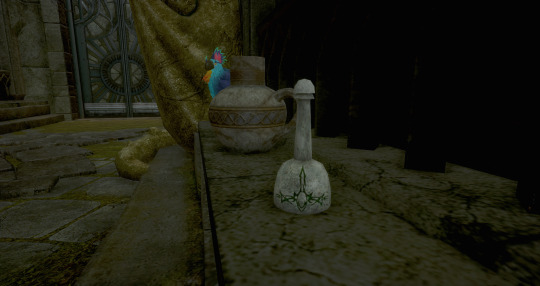
The entrance to the temple is enormous. Its door is waiting for activation via the rituals/puzzles. At its sides there are two gigantic, decayed mosaics of Mythal. In the small corridor of the door, there are four Dragon Myhtal statues. In the corridor, we find this curious vallaslin ink object that we had only seen it before in the The Lost Temple of Dirthamen.
The Rituals [Puzzles]
In this post, Diirthata-ma shows the name of the game files [I’m unable to have access to these by myself] which represent the puzzles. I thought it could potentially give us some hints about the statues used in them. So, the name of these ritual I use here were given by the game files.
Elgar'nan Ritual

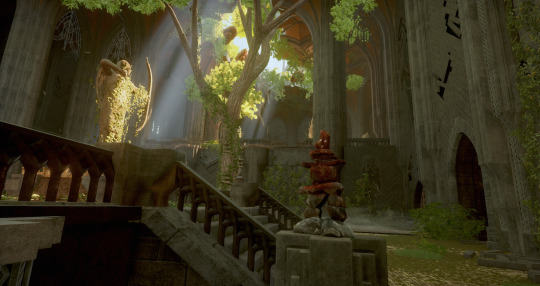
The first puzzle, the easiest and shortest one, is named Elgar'nan ritual. It's decorated with archer statues [that by now I suspect we can consider them as Shadow Sentinels], and on a rail of one of the stairs that lead to the puzzle, we find a small Red inuksuk. So far, I still keep the interpretation that these objects are related to sacrifice and blood.
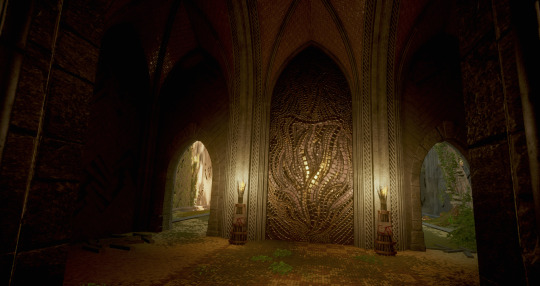
The entryway to this puzzle is decorated with a Sylaise's golden mosaic. I feel this is very fitting, since Elgar'nan is fury of great power [read the codices in the Temple of Mythal and in Vir Dirthara related to him] while Sylaise is as brutal as him considering the only non-Dalish codex we have: Song to Sylaise. Both figures are entities of fury, fire, and wrath in some degree. Sylaise seems to be a bit envious or competitive even.
Fen'Harel's ritual
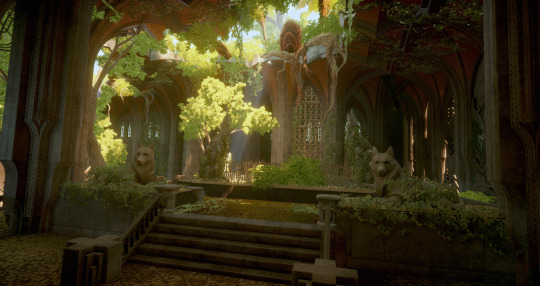
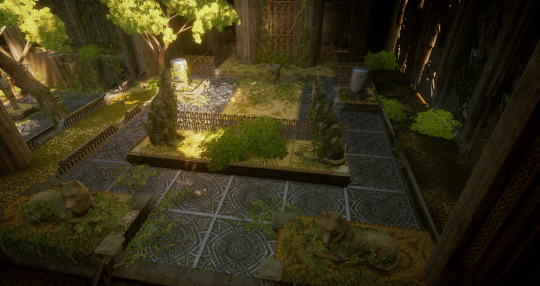

The second puzzle, with a lever, is Fen'Harel's ritual. It’s a puzzle with two potential interpretations: One, ironically, is that this puzzle needs you to be trapped in order to solve it [as a meaning to represent how he sealed the others gods, including himself (Cole says the wold chew his own leg to escape), to save the world], probably a poetic twist implemented by the Devs than something that the original Elvehan would have considered in the creation of this ritual. Another interpretation [more in-game and more “Evanuris”] is that this is the trickiest puzzle because the lever, and thus it represents Fen’Harel in the sense that you need cunning to solve it. [Unlike what wiki says, you don’t need to fail first to solve it. It has several different ways to be solved without failing it, it’s just a matter of tricks.]
To no one's surprise, it has several statues of Fen'Harel, in sitting and howling position.
Dirthamen's ritual
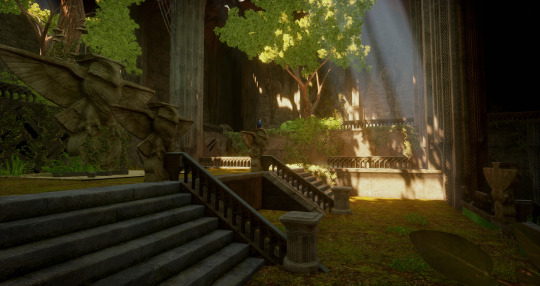
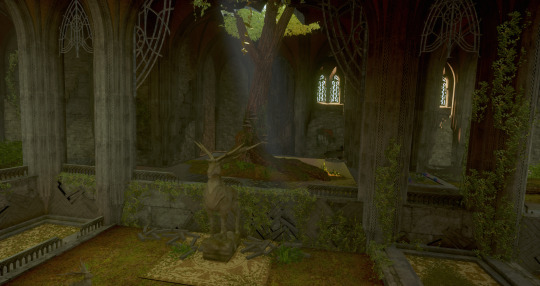

This is the longest one, which needs you to jump across different levels of the puzzle. It starts in the part of the chamber decorated with Elven Owl statues, and finishes in the one decorated with Elven hart statues. Due to the fact this is a puzzle that represents Dirthamen, gods of knowledge and secrets, it seems to present a duality [owl and hart] as usually Dirthamen/Falon’Din seem to exist in the iconography.
That the owl is present here, seems to have some reason: we have read in the game a codex saying that the owl could be considered the messenger animal of Dirthamen [as well of Andruil], but the hart seems to be a curious association. We know that the unreliable Dalish Tales relate hart figures with Ghilan’nain [for example, Ameridan did it in the DLC], and in the The Lost Temple of Dirthamen (Part 2), we find a red mosaic of Ghilan’nain [this association a bit more trustworthy]. In the codex Ancient Elven Writing [detailed and analysed in Ancient Elven codices, Temple of Mythal], there is a subtle relationship between Ghilan’nain and a servant of Dirthamen.
Therefore, Dirthamen and Ghilan’nain may have had some particular kind of relationship which is not clear to define with the information we have in game. It could have been an alliance or a rivalry of some kind. Honestly, considering Dirthamen’s dual existence with Falon’Din, I would have expected this puzzle to have more visuals of Falon’Din, as all things related to Dirthamen have and vice-versa.
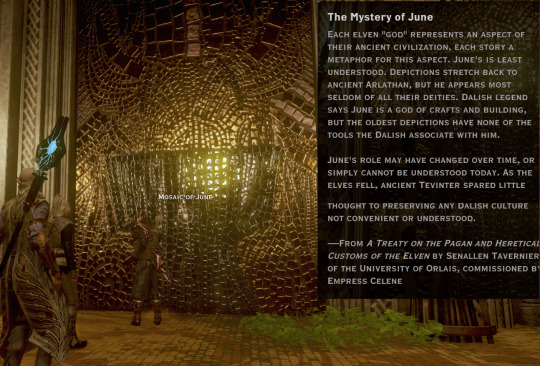
The entryway to Dirthamen’s puzzle is decorated with June's golden mosaic, which triggers the codex The Mystery of June, detailed and analysed in Ancient Elven codices, Temple of Mythal.
The only reason I can find to explain why two of these puzzles have entryways with mosaics of June and Sylaise, is because both of them have a portfolio of crafting in common. In the codices Vir Dirthara: Raising the Sonallium and in Song to Sylaise [detailed in Ancient Elven codices; Vir Dirthara and in Ancient Elven codices, Temple of Mythal] we can see that Sylaise is also dedicated to some aspect of the arts of crafting or related to architecture. Both of them may have been responsible of the construction of many of these buildings, in my opinion.

Once the puzzles are finished, the main door to the temple glows in blue and we are granted the access to the Petitioning Chamber.
Ancient Crypts: Red Templar's way

If we follow the hole on the ground left by the Red Templars, we have access to something that the game names “Ancient Crypts”. When we ask Morrigan’s opinion on this place, she says that it looks more like a fortress than a Temple.



The crypts present the most creepy murals from the post Nation Art: Elvhen

This place has decorations and structures similar to Dirthamen’s Temple or in general, similar to any elvhen crypt [like Dinan’Hanin]. As all elvhenan crypts, they are made with rough stones, and less decorated door frames and arcs.


The walls have these typical paintings. The only one I didn’t find is the Armoured figure from Nation Art: Elvhen. We even find these reptilian drawings in the Temple of Mythal. This repetition in so many elvhen places makes me consider this as part of a lore we don’t understand yet, and not just a Bioware joke about krogans.



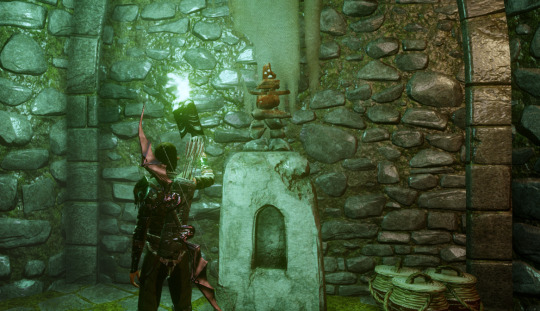
From dozen and dozen of screenshots we see most of the object we have seen in crypt-like scenarios like the Lost Temple of Dirthamen: different inuksuit, urns, Elvhen funerary lid, generic dead bodies, and some Red inuksuk [I kept this cute one, so small].

It’s in the crypts where we find Untranslatable Elven Writing which is Abelas’ confession about how he and his people at the temple endure their duty. Details in the post Ancient Elven codices, Temple of Mythal.

Ahead, we find another: Unreadable Elven Writing, which narrates about a unique and brutal weapon developed by Andruil, a golden spear. It’s not clear if this is like a codex that represents the main rival of Mythal. We can imagine that Andruil may have had a lot of resentment towards Mythal since they both fought and Mythal erased her memory of how to access to the Void [codex Elven God Andruil, detailed in Ancient Elven codices, Temple of Mythal].
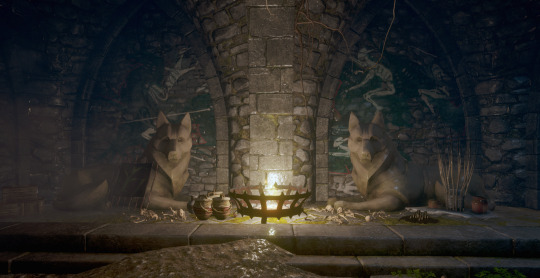
One of the many chambers of this crypt has a pair of Fen’Harel statues with the painting of the elves in battle. This makes me strengthen the idea that this mural painting represents a Rebellion more than a battle.


Next chamber, we find a broken Dragon Myhtal statue, with the painting of the dragon on the wall [which in several other situations seems to be a dragon that guides the painting of the elves ridding into battle] and in another section of the wall, we find the slaved elves, without face and heart. There are more snuksuit and more paintings of elves with vallaslin.


In one of the darkest chambers, we find an isolated statue of a hart.
Arbor Wilds: Temple of Myhtal - Part 1, Part 2, Part 3, Part 4, Part 5
#main quest#playing DA like an archaeologist#temple of mythal#Elven Archers#Elven Owl statue#Elven hart statue#red inuksuk#Inuksuit#Sitting Fen'Harel statue#Elvhen funerary lid#june#sylaise#andruil#Falon'Din#Dirthamen#Elgar'nan#elven pantheon#elven design#Howling Fen'Harel statue#Humanoid Mythal statue#dalish ink#vallaslin ink#elvhen mosaic#Evanuris Mosaics#Dragon Mythal statue
12 notes
·
View notes
Text
Arbor Wilds: Temple of Mythal in detail
The Temple of Mythal was a place of justice, where petitioners walked religious rites of passage in order to have their pleas for justice heard by Mythal. According to some, it is also the site of some mysterious religious artefact called the vir'abelasan.

This post is similar to Arbor Wilds: Temple of Mythal - Part 4, but it is not analysed within the context of the main quest. This is a more detailed exploration and analysis of the chambers.
[This is part of the series “Playing DA like an archaeologist”]
[Index page of Dragon Age Lore]
Petitioning Chamber
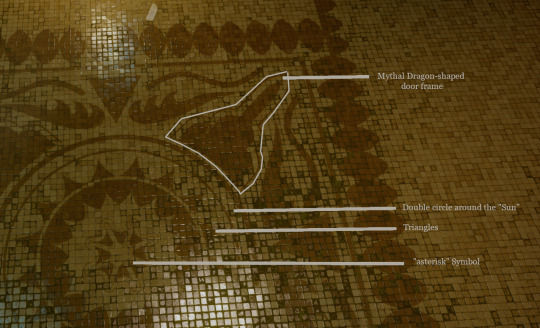
The ground mosaic in the petitioning chamber is the standard one used in most elvhen ruins. What I always highlight in it is the asterisk symbol that we have seen in elvhen murals to represent orbs or titan’s heart. It is inside a structure of circles and triangles that may suggest a sun inside a double circle. At the corner, we find a figure which outline looks like the shape of Dragon Mythal’s frame doors.
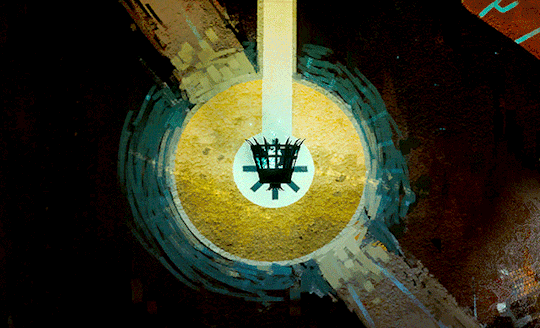
It’s very interesting that the brazier in most of the rooms of the temple are placed on the very centre of this mosaic, on the “asterisk” symbol. Similar detail happens in some elven murals, where the braziers of Veilfire are placed on the circles with the asterisk symbol on it. When there is no brazier or fire, the idea is to place a person on the asterisk symbol which gathers all the focus of the room, as it seems to work in the petitioning chamber or in the Fen’Harel rooms along the Temple.

The entrance of the chamber shows a disposition of statues and mosaics.
Mythal statues everywhere doesn’t seem odd considering this is her temple; she is the entity that will impart justice in this chamber [or her high priest]. What is curious are the details around the chamber:
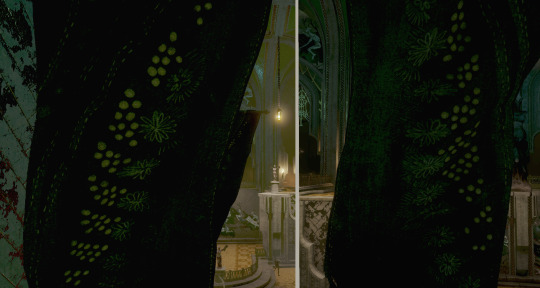
There are unique banners hanging from the sides of this chamber. I didn’t see them before in game. Probably this is related to Mythal or Elvhenan symbology. It’s a flower of many petals, and many many dots to a side. The other side of the flower seems to have just lines. Once more, Flowering Imago from Ancient Elven codices; Vir Dirthara comes to mind, the idea of several wills [dots] feeding flower.


At the sides of the platform where Abelas speaks there are two mosaics: Falon’Din’s and June’s.
This is very curious. They are not central, so it’s hard to see them when you have just stepped into this chamber, but they are more easy to see as you approach the main platform.
There are two small stages aside the main platform, with a long brown rug decorated with spherical trees. Each stage is closer to one of the mosaics. Imparting justice in this place may have had results that would lead to Falon’Din’s path or June’s. A path or judgement to Death (?), or one of… reuse? to be crafted anew? June is a mystery so far. We know he is related to the art of crafting in some ways, but we also know it’s not exactly in the ways Dalish think so.
On the other hand, giving followers to Falon’Din in judgements seems to be a terrible idea if we take into account what Solas told us in Part 2. But this temple may have been worked in this way before that event. Things may have been different until Falon’Din killed some of Mythal’s servants.
Each of these mosaics is beside a door. I think it seems reasonable to assume that those that were judged in a way or another, got a result that was associated with Falon’Din’s field [I suppose related to death] would leave the chamber through that door. In game, it’s blocked and goes nowhere if you cross it with fly-camera.
Now, the door beside June’s mosaic leads us to the Inner Sactum. Is this mosaic a representation of what June crafted in this Temple? Did June build the Vir’abelasan? Or this journey along Inner Sanctum grants a transformation of the persona that seems like a being “crafted” anew?
Remember that in the Courtyard, June and Sylase were in the entryways of the ritual-puzzles, giving the impression that this was a “sign” of their work, those mosaics were there to denote they were the ones responsible of crafting them. Maybe the same can be applied here. Even though it’s a bit more obscure since the opposite wall displays Falon’Din’s mosaic. All these questions and assumptions seem to be too much for my taste. There is so little we can use to infer with some degree of certainty.
The mural paintings of elves riding towards a battle can’t be overlooked [these murals are analysed a bit in Nation Art: Elvhen]. They are everywhere in this chamber and in the last part of the temple. It could represent the battle against the different Evanuris, probably using troops made of their own followers, but also it seems to be related to the battle for rebellion, since it has appeared in the ancient Crypts in a small chamber with sitting Fen’Harel statues. It could also be related to the battle against the Titans. It’s hard to know because the game has never ever gave us a lead to how understand that painting.

There are two ways to enter the Inner Sanctum: Forced [red line in the map] or Allowed [blue line in the map]. When we are allowed to enter, you have to follow an Elvhen Guide who grants you access to a unique chamber that, otherwise, you wouldn’t see [where most of the codices of the Temple of Mythal are placed]. The Guide opens secret doors and makes us avoid the combat against the red templars. Some rooms are separated just by a fence, which allows us to see what’s going on at the other side of the chamber. The Forced path is the one less rich in terms of details. It’s mostly rooms with minimal decoration and sentinel fighters.
Allowed Path [Blue]
Chamber M
The name of the rooms refer to the map of the beginning of this post.

The immediate chamber we are introduced, as we follow the Guide, is a small room with a golden statue and mosaic of Mythal. Here is where we can trigger the codex “The Judgment of Mythal” analysed in Ancient Elven codices, Temple of Mythal. [Note on the asterisk symbol of the ground mosaic: Mythal statue is placed on the asterisk. There is another asterisk without anything on it.]
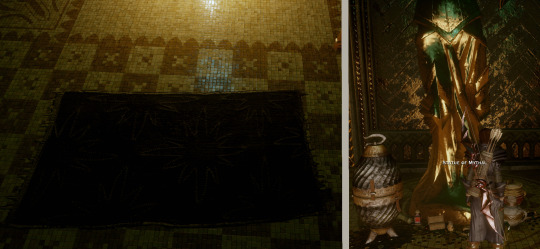
In front of the mosaic there is a rug with a pattern that looks like stars. I guess it may be used by the followers to sit and pray in front of her mosaic. The statue has the detail to be named “Statue of Mythal”, so there is no way we can question this.
Chamber D
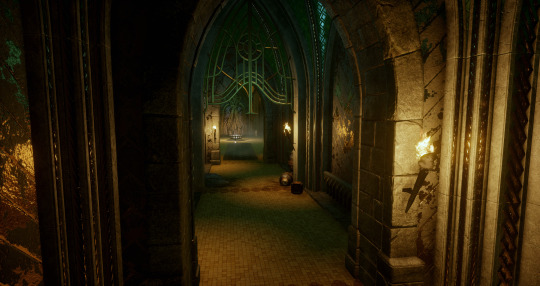
We continue towards the Chamber D using a corridor. From afar we see that at the end of the next room there is a Mosaic of Dirthamen.

We reach to a unique chamber that we can’t have access to if we antagonise Abelas.
Here, there are four mosaics that trigger some codices, and a rune, on a wall that the screenshot does not show, because it is opposite to Dirthamen’s mosaic. [Note on the asterisk symbol of the ground mosaic: there is a brazier on it]
The mosaics are Elgar’nan’s, which triggers “Song to Elgar'nan”; Ghilan’nain’s, which triggers “The Ascension of Ghilan'nain”; Dirthamen’s, which triggers the very suspicious and unreliable “Twins in Shadow” [I would love to hear a dev to tell us that this codex here is a mistake. What is this scholar doing here? Abelas and his sentinels would have never allowed a human to do anything to their gods’ mosaics. The author of this codex, a contemporaneous scholar, makes no sense to be found on this mosaic. This is painful to me]. Fen’Harel’s mosaic does not trigger anything.
The rune on the opposite wall triggers “Unreadable Elven Writing”. This same codex can be found in the Ancient Crypts if we skip the rituals to enter the Temple, but since we are following the path of the Guide, it’s obvious that we solved the rituals and didn’t explored the Crypts. This means that the devs considered this codex so important for the player that they made sure they would read it no matter what path you follow.
It’s curious that in Inner Sanctum, we cannot find any mosaic of Andruil. The only reference to her is this rune [there are also the owl statues that could be her messengers, or the hart statues, but both animals are not unequivocal representation of her]. This rune speaks about the construction of a weapon, a golden spear, which use will be catastrophic. [For more details, Ancient Elven codices, Temple of Mythal] I think there is more meaning for this to appear as a rune and not as a mosaic. The lack of an explicit mosaic of Andruil seems to speak of an enmity with Mythal. At the same time, a veilfire rune, which preserves memories and information much better than a mosaic which can fall apart over time, may imply that the people writing this wanted the message to exist even despite the worse conditions. However, Andruil has a place in Mythal’s temple: outside, in the ritual garden, inside a room that looked like a golden cage. One for her, another for Falon’Din [maybe the most problematic Evanuris for Mythal?].
Each of the mosaics have a rug in front of them. Since this chamber follows the room M, focused only on Mythal, and it’s protected by the activation of the secret paths by the Guide, one could suspect this is a room where Mythal’s allies are represented.
Fen’Harel has always been a good friend of Mythal. There are many proofs from Solas, defending her memory, but the most important one for me is Flemeth in the last seconds of the game, calling him Old Friend. Fen’Harel has always been her friend, and Fen’Harel has always respected Mythal, considering her the best of all the Evanuris.
Elgar’nan may not have been a friend, but his trust in her is undeniable. He gave Mythal the ability to impart justice so his fury would not go out of control for every argument [codex: The Judgment of Mythal]. He also trusted her wisdom when Falon’Din tried to start a war against him [codex: Duel of a Hundred Years].
There is no information about the relationship between Mythal and Ghilan’nain, but given the fact that there are two mosaics of allies in this room one can suspect that she belongs to allies too. Or at least, she was an ally in the beginning.
We know there is a relationship between Dirthamen and Ghilan’nain [Red mosaic of Ghilan’nain in The Lost Temple of Dirthamen, and her involvement in suggesting one of the servants of Dirthamen to take Divine shape, codex: Ancient Elven Writing in the Ancient Crypts of Temple of Mythal ] that may have been extended to Mythal, whoever of them had a deeper link with her.
I suppose Dirthamen had a relationship with Mythal since in Flemeth’s Fade we see a statue that the game has unreliably suggested to represent Dirthamen, stabbed and bleeding. But due to his duality nature with Falon’Din, it could be him, being bled as Solas told us that Mythal had to do with the rest of the Evanuris to stop Falon’Din. It’s always a problem to understand anything with those two involved.
I suppose that the Veilfire rune present in this room, in this particular context, can be interpreted as a Warning for the supposed allies of Mythal. After all, the rune speaks of a terrible weapon made by Andruil.
F’H Room

[Note on the asterisk symbol of the ground mosaic: there is a brazier on it]

The next room has two sitting Fen’Harel statues and a rug in between. It’s not clear if this is a place to pray for him since the rug is in front of a wall without a mosaic [of we follow the pattern in most rooms], but it could also be prayed at the statues, I guess. There are some broken funerary lids in the southern corner of this room.
Sy Room
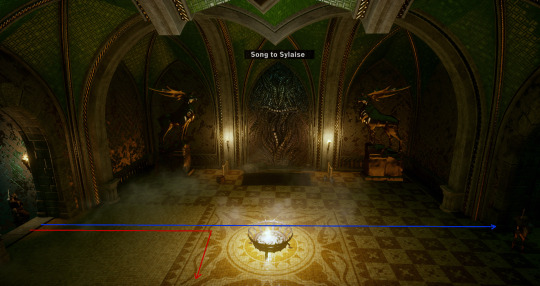
Next room is Sylaise’s. [Note on the asterisk symbol of the ground mosaic: there is a brazier on it].
She has one full room for her in Mythal’s Temple. This is very curious to me. There is a mosaic of her that triggers the “Song to Sylaise”, which is the only real codex we have about her non-based on Dalish legends. In front of it there is a rug to pray in front of her, and two elven hart statues, which are rare objects to find here. We know little about the true Sylaise [the one which is not based on Dalish Tales], and so far I know, we connect the hart symbol with Andruil or Ghilan’nain. That these harts are positioned as guardians around her mosaic, may have similar meaning to those located around Dirthamen’s mosaic? Is the Hart a shared favoured animal between Sylaise and Andruil? Or this is a symbol to show that Andruil and Sylaise were allies? If that were case, would Mythal allow a single room for praying to her? Tons of questions, none answer.
Corridor with Archers
The Allowed path lets us explore a broad over-flood corridor. There are no mosaics here, but only two archers that point nothing. Similar configuration was found in The Lost Temple of Dirthamen - Part 2, in the Path of Secrets.

I’m not sure if this could be understood as something related to Andruil or The People. There is no much to conclude here.
Room 3
This is the room where both path, Forced [red] and Allowed [blue], gather once more.
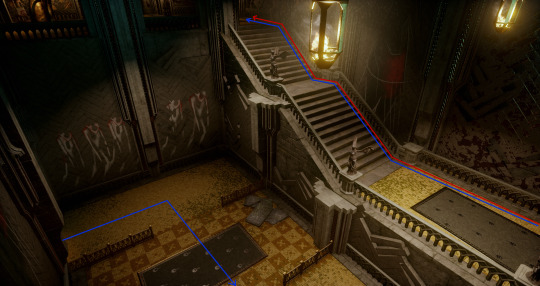
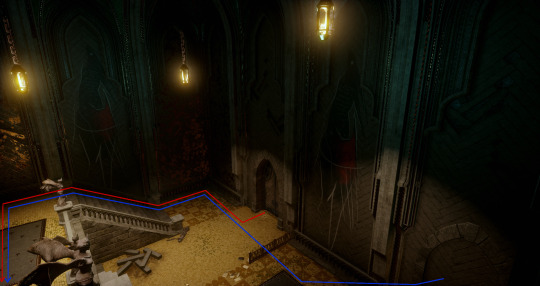

From the corridor with Archers, we open a sealed door and have access to this room where we see a stair with a painting of the black dragon [Nation Art: Elvhen] on the walls heading up, inviting the walker to go upstairs. I suppose this will imply a meaning of ascension [we are getting close to the Vir’abelasan], while on the ground level’s wall we see the “zombie” elves.
The stair rails are decorate with many small Mythal statues. There are no imposing statues of her outside the petitioning chamber and the M room. And even in those rooms the statues are rather medium.
F’H Golden Halla
At the top of the stairs we find what I called “F’H Golden Halla”
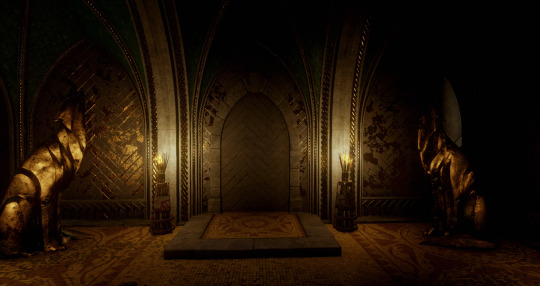
[Note on the asterisk symbol of the ground mosaic: the place is free for the person who would contemplate the hidden room could stand on it.]
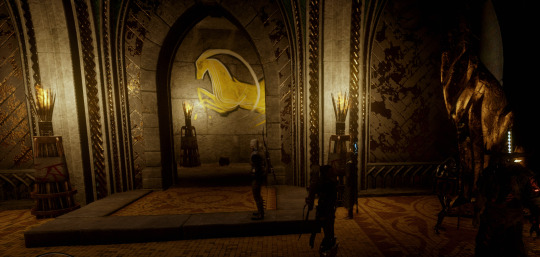
Howling Fen’Harel statues guard a secret room where there is only a golden halla painting [Nation Art: Elvhen] and some minor loot. This small room can’t be seen by those who forced their entrance, since it’s our Guide who opens it. It seems to be a secret messenger to those who are friend to Mythal.
Or maybe this whole configuration means that Fen’Harel [Howling wolf] is guarding “the people” [represented in the Golden Halla, a Halla that is valuable because it’s golden like all the golden statues and mosaics in the temple that only represent Evanuris].
It could also mean a small tribute to Fen’Harel’s work: if the halla represents The People, Fen’Harel statues at the sides of what looks like a small, humble chapel would suggest that the real entity that should be worshipped is The People? So many holes in the many, many elvhen symbols we have in the game.
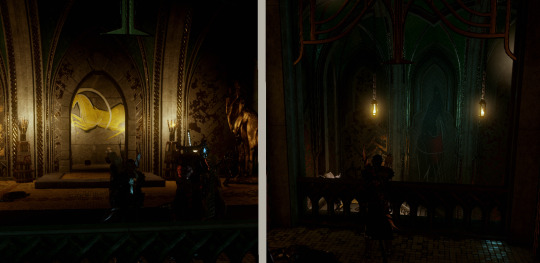
The Halla faces, bellow and across the room, directly to the ascending dragon. Both images are very well framed in the configuration of the room. Not sure if it means anything, but it’s a detail that stands out if you spin in this place.
Rooms 4
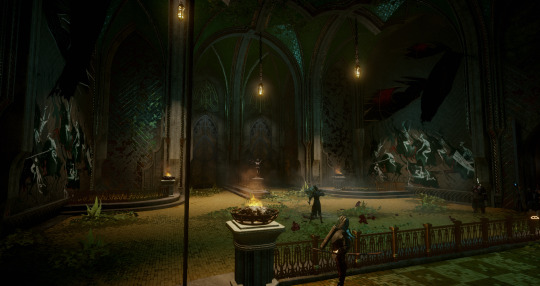


In this part, we see the last fighters of the elvhen, killing Red Templars. There are more mural paintings of the battle elves and the dragon from the room 3. If we see the connotation, it is as if this dragon were guiding the zombie elves from the previous room, at the ground level, into battle: now they became these elves that fight guided by the dragon. It’s hard to know when these murals were done, if they were always part of the Temple since the construction of it or were decorations made after, during the last times of the Evanuris. If we could know this, it would allow us to develop many different interpretations.
By walking past a small figure of Mythal, we leave the room heading into the garden where we find the Vir’abelasan.
Once more, Mythal appears in non-imposing sizes. She is always small, decorative, while what’s truly imposing and overwhelming is the mural of the battle.
Forced Path [Red]
The only two rooms we don’t see if we go through the Allowed path are Mu Room and Room 2
Mu Room


The only particularity that this room has is that it has four mural paintings: two standing elves on a side and two in fighting position with a shield, on the opposite wall.
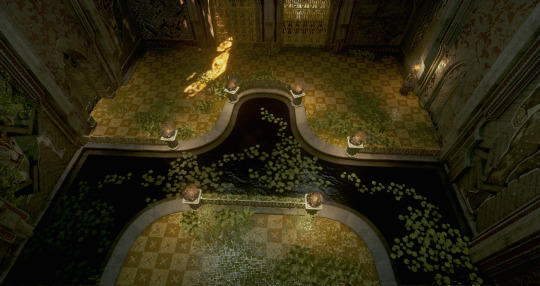
It also has a small decorative pool.

From here we can see the superior rooms: Room 2 and 4.

One would suspect these murals are as old as the temple, and were intended to be part of it, simply because the walls where they are painted on are not “old golden”. It seems to be meant that these drawings would be part of these walls from the construction of the temple. They do not look like “graffiti”.
Room 2
This room has nothing to add. It has a squared pool too, less pretty than the one below.


These three rooms [Mu Room, Room 2, and 4], can be seen at the same time since they are placed in the same space but at different levels. [Note on the asterisk symbol of the ground mosaic: none of these rooms have this ground mosaic.]
#temple of mythal#andruil#Falon'Din#Dirthamen#mythal#fen'harel#Ghilan’nain#Elgar'nan#Evanuris Mosaics#High speculation#Humanoid Mythal statue#Elven Owl statue#Elven Archers#Elven hart statue#elvhen design#elvhenan design#elven pantheon#Elvhen funerary lid#golden halla#elven design#Howling Fen'Harel statue#Sitting Fen'Harel statue#Playing DA like an archaeologist
15 notes
·
View notes
Text
Arbor Wilds: Temple of Mythal - Part 4
Main Quest: What Pride Had Wrought
The Temple of Mythal was a place of justice, where petitioners walked religious rites of passage in order to have their pleas for justice heard by Mythal. According to some, it is also the site of some mysterious religious artefact called the vir'abelasan.
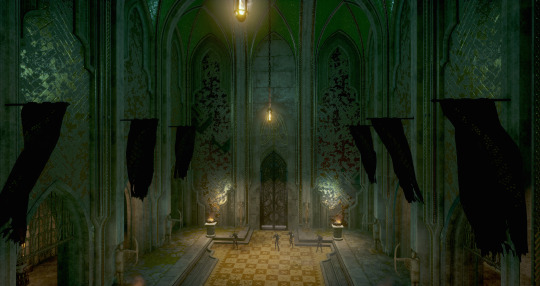
This post contains the following sections
The Petitioning Chamber
Inner Sanctum
[This is part of the series “Playing DA like an archaeologist”]
[Index page of Dragon Age Lore]
[An analysis of this Temple without the context of the Quest can be read in Arbor Wilds: Temple of Mythal in detail]
The Petitioning Chamber

This chamber is enormous. It’s covered with a typical elvhenan mosaic of brown and yellow colour on the ground, depicting a sun and inside it, an asterisk.

The columns, walls, and door frames show the typical patterns of elven design: the semicircles, the rectangles, the circular flowers, and the scratchy sun. There are also helichoidal lines in gold along columns.

The main chamber is decorated with six Elven Archers, reinforcing the idea of being like the elves that are at the Inquisitor’s back: Shadow Sentinels.

The petition chamber has a central, high platform that can’t be reached from this room. It shows two sections with a long brown carpet along it and walls decorated with the painting of elves riding hallas into battle. This painting even reaches the highest part of this chamber.


At the sides of the central platform, there are two enormous mosaics: one of June at the left and another of Falon’Din at the right.

The sections with the rug are flanked by two Humanoid Mythal statues, and the rug displays the typical spherical tree on it.

If we put ourselves in Abelas’ position, we can see the power projected from the platform onto the petitioning chamber. The hierarchy difference between petitioner and priest is clear and exaggerated. It’s curious this configuration and yet the statues of Mythal are not that big.

All the archers that appear behind the group, if made a zoom-in, wear Mythal Vallaslin. Some of these Vallaslins are made in red or green [or blue?] colour. I think that most of the servants of Mythal have yellow eyes [in one of my screenshots I see some with blue eyes, but it may be a trick of the light]. The rogue fighters in the Inner Sanctum [without a hood] seem to have dark eyes. And the last fighters we see at the end of the temple have yellow eyes too. No matter the gender, all elvhenan are bald and a bit bigger and bulkier than the modern elf.

Abelas has the typical outfit that most Sentinels have. Details can be seen in this post about Solas’ outfit. What always caught my attention of this outfit is the decorative “flowers” at the inner part of the trousers that look like the symbol in Solas’ tarot card, and the face [Mythal?] on knee protectors and shoulders.

Whether the group reaches the main chamber via the rituals or the crypt, we find the same place, and the cinematic with Abelas is triggered.
This scene has several variations: if you respected the puzzles/rituals, whether you enter by the main door or the crypt, you are not attacked. If you enter via the crypt without doing the puzzles, the elvhenan will attack immediately after Abelas says you disrespected the Temple.
In the richest case, which is when you perform the puzzles, Abelas gives some information:
Dalish elves are not Elvhen, even though they have the same features.
Fen’Harel’s energy in the anchor is familiar to him.
Abelas speaks of having been in slumber, not Uthenera. At the end of the quest, we have the concept that Uthenera is truly a final end.
Abelas and the others are “sentinels”, who protect this temple from those who trespass.
They only awake to fight, diminishing over time even though they still reproduce [so far we can understand from his confession in Untranslatable Elven Writing, in Ancient Elven codices, Temple of Mythal]
The Well of Sorrow’s real name is Vir’abelasan [vir= path, abelas=sorrow, -an=place] Morrigan understands this as “the place of the Way of Sorrows”.
Arlathan was not destroyed by Tevinter but by Elvhen. Elvhen warred each other.
Every time they awake [to fight and defend this temple] they seem to take some time for exploration and understanding of how this world is changing. He claims that it changes in ways that are more and more alien to them. Imagine how much of a shock it could have been for Solas, who went to slumber after creating the Veil and awoke a year before the Inquisition. This world for them is meaningless, so they endure its decay. They only exist to perform the duty of protecting the well of Sorrows
He explains what’s the Well: a path for those who work hard for Myhtal
Solas’ comment here is quite self-explanatory: Abelas clings to all what’s left of his world because he can’t change it. Solas, by the end of the game, will not cling onto nothing, because he can change it.

Abelas seems to be the High Priest of Mythal here, and he imparts his judgement in this high place, time ago decorated in golden, flanked by Mythal’s humanoid figures.


Abelas, same as Solas, do not recognise their own people among the Dalish or city elves. For them, they are “shadows”. Here we can see that Solas recognises these elvhen as “his people”, he is worried about the Inquisitor’s reaction that could cause the death of all these sentinels, which I imagine, triggers his personal fear: to be the last one of his kind.

Whether we force our entrance or Abelas allows it, we can explore the rest of the temple: The inner Sactum.
The Inner Sanctum


We follow a series of chambers decorated very ritualistically, with a brown carpet along the corridors, walking through arcs with the shape of humanoid Mythal and Fen’Harel statues. The walls have some mural paintings as well, all the figures [with the exception of the armoured one] have been seen in Nation Art: Elvhen. For a more detailed tour along these chambers, check Arbor Wilds: Temple of Mythal in detail.
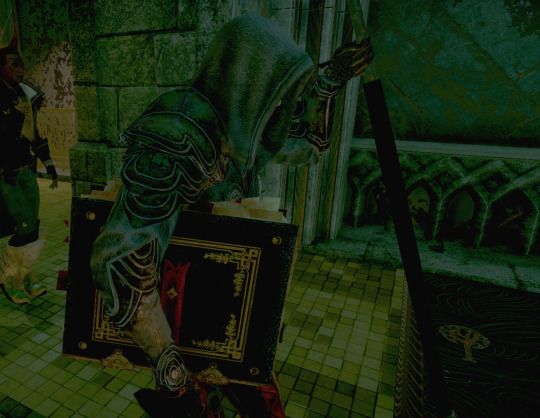

Solas translates some bits of the Guide NPC we have if we are in good terms with Abelas. She is carrying a big book, and guides us along the chambers, opening secret passages.

The ceilings of the Elvhen ruins are very typical of the elvhen construction. Different chambers show different combination of elements. Due to the excess of golden decorations in each, I assume each chamber is a bit of a “chapel” for each god. Chamber of Sylaise mosaic is flanked by Elven hart statues

The chamber with Dirthamen’s mosaic is flanked by owls. The owls flank mainly Dirthamen, but at the other two side walls of this front, we find a mosaic of Ghilan’nain, Fen’Harel in wolf shape, and another of Elgar’nan. Here there is a rune in Veilfire about Andruil’s terrible weapon.
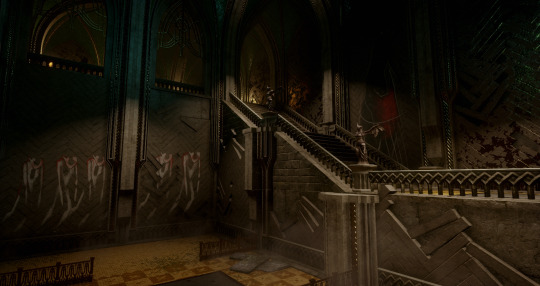
By the end of the temple, there is a long stair decorated with Mythal statues and several mural paintings.

In the upper part of the stairs, the last chamber presents a tricky place to praise Fen’Harel, I guess. Two Howling Fen'Harel statues flank a blocked entrance. In most of the previous cases, the deities had their own golden mosaic flanked by statues. In this case, his statues flank a room that, once opened by our Guide, shows a golden Halla painting.
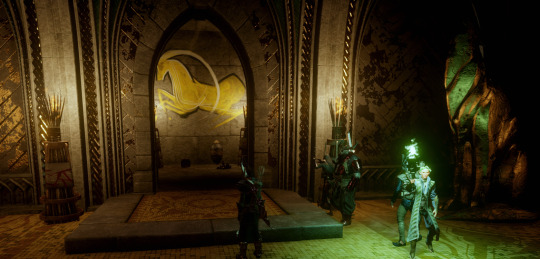
It’s hard to understands if this could mean that Fen’Harel ask for no devotion or adoration, but he prefers that energy to be directed to the “golden halla”, a representation of the “people”. More details in Arbor Wilds: Temple of Mythal in detail.

This last chamber shows a combination of mural paintings which are the elves in battle and the black dragon as if it were guiding them. It has been seen before in the ancient elven ruins in Tresspasser. Sometimes in direction to the battle, other times against it.

We finally reach the last chamber before going to the inner garden.
A more detailed analysis of this Temple and its chambers with the codices presented in Ancient Elven codices, Temple of Mythal has been done in “Arbor Wilds: Temple of Mythal in detail”.
Arbor Wilds: Temple of Myhtal - Part 1, Part 2, Part 3, Part 4, Part 5
#main quest#temple of mythal#playing DA like an archaeologist#asterisk symbol#Humanoid Mythal statue#Evanuris Mosaics#june#Falon'Din#mythal#abelas#Elven Archers#elvhenan#elven design#Howling Fen'Harel statue#Sitting Fen'Harel statue#Elven hart statue#Elven Owl statue#Dirthamen#falon’din#Ghilan’nain#Elgar'nan#sylaise#fen'harel#Andruil#Dragon Mythal statue
6 notes
·
View notes
Text
Exalted Plains

The Exalted Plains, also known as Dirthavaren ("the promise") in elvish, is a grassland region of the Dales in Orlais. Centuries ago, the Dalish kingdom met its end here, the holdouts of the elven army making their last stand, refusing to surrender against the champions of Andraste: the templar, the sister, and the nobleman patron. The champions' cause was just, and their faith led them to victory. The plains were henceforth called "Exalted". After the elves' defeat and the dissolution of their kingdom, Ville Montevelan became the first human settlement in the Dales, presided over by Revered Mother Amity, Champion of the Exalted March.
Currently, the region is a contested battlefield during the War of the Lions until Empress Empress Celene and Gaspard de Chalons's armies agreed to cease hostilities.
[This is part of the series “Playing DA like an archaeologist”]

When entering this zone, Solas explains that this place has a thin Veil product of the battles that happened long time ago: the Exalted March of Dales. So we know we are going to see a mixture of elven ruins and human settlements.
Scout Harding will inform us that in the area there is a group of rebels who are tired of the War of the Lions, and wants the Dales for themselves.
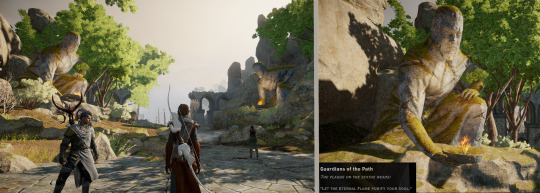
The first thing we see when we enter this zone are these statues that, design-wise, they are very, very close to the Humanoid Dirthamen/Falon'Din. Humanoid Dirthamen/Falon'Din is a squatted hooded figure, who doesn’t have any object in his hand. This one holds a plate which works as a brazier. In fact, the elven statues are placed in this entrance, but on the Emerald Graves side:

They are called Guardians of the Path, and by the note they trigger, they are Andrastian. Still the striking similarity between these statues and the one we associate with Dirthamen makes me suspect that, once conquered, the Orlesians repurposed the native statues.

The first ruin we find, which surrounds the camp, is an elven one, with a dragon painting on one of its columns.
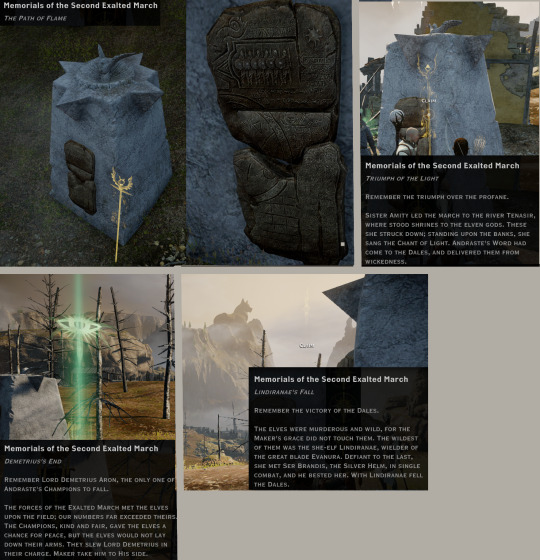
Besides the path there is a rectangle statue which on its top has a star-shaped fountain with a dove. On a side there is a reused elven/dwarven relic tablet that will trigger the codex Memorials of the Second Exalted March which will be updated as we read all these stones spread in the region. They explain how the “battle” against the elves was happening, mixing Andrastre’s tale with probably bits of History. It’s very curious how this piece of information depicts the elves as proud and murderous, far away from the Maker and Andraste, which is clearly a lie when we analyse Di’nan Hanin; these Dalish, unlike modern Dalish, had fused Andraste cult into their elven pantheon, not without reason: It had been some decades since they had recovered these lands thanks to Andraste’s promise.
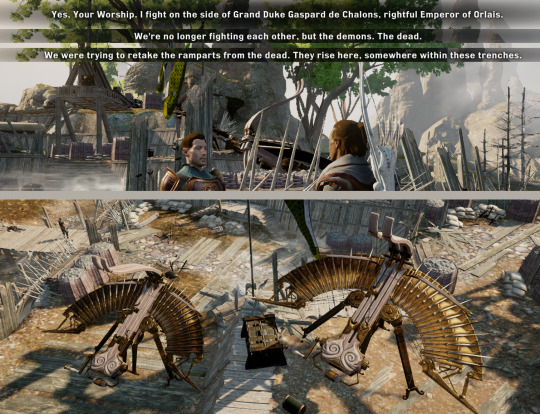
The zone has several ramparts where the imperial army [either side] is trying to retake control from the undead and the demons. Recovering each of these is quite a repetitive task all over the place.

The only important comment about these ramparts is that they give us some idea to understand the function of these Strange Skull-Dragon totem : They seem to hold barriers around pits that allow the dead to rise, and also as columns surrounding zones with many undead or demons. They seem to be related to summoning rituals.
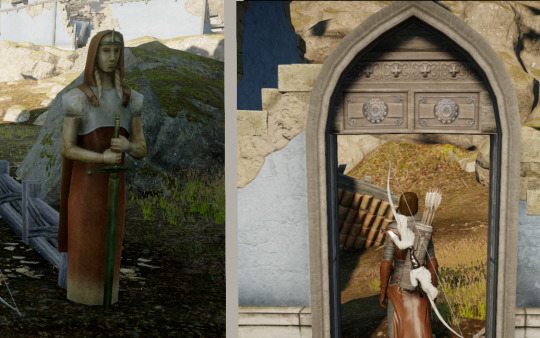
Along the region we find several Andrastian statues and the typical orlesian style in the remnants of the houses that still stand.


Fort Revasan shows the standard elven patterns of any elven ruin. The Orlesian occupation built extra, less durable additions with chess-like floors and decorated wooden elements.

Close to Fort Revasan there is a sealed entrance that requires a war table operation to be solved in order to open. It shows a Fen’Harel statue, guarding the entrance. It’s a nice detail to see that the base of his statue shows an eluvian-like pattern worth to keep present.

Very far away in the North, over the mountains that surround this region, we see a big Fen’Harel statue observing the Exalted Plains. It’s hard to guess what this zone represented in the time of the Elvhenan [not the Dalish kingdom]. This place has 3 main elvhen ruins: the one in the North Rampart, the Ghilan’nair’s grove, and the Graveyard Var Bellanaris. There are more than these, but they are too destroyed or small. It’s hard to ponder if all of them date of the same time.
At some kilometres of distance from the Fen’Harel’s statue, we see a tower of radical different style. At a single glance, we can see it’s Tevinter. More details of this in the Post about Exalted Plains: Citadelle du Corbeau.

Riverside Garrison is another elven ruin which patterns make it look like Elvhen: flower pattern, square pattern and swirl pattern.
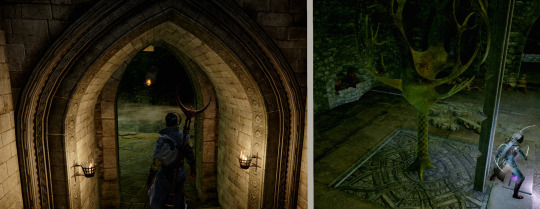
Inside, we find more elements that allows us to suspect this is Elvehan from the time when the Veil did not exist. There is an elaborated tile that we will see in puzzles in the Temple of Mythal, and one of those rounded trees, growing out of it.
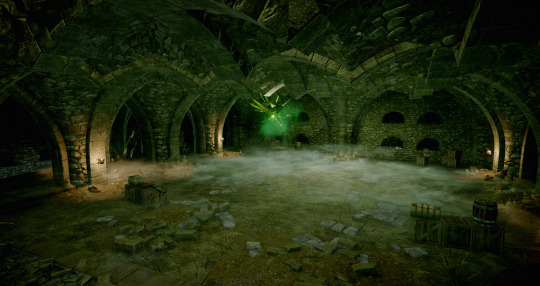

With the exception of the rounded tree, the decoration looks like an elvehnan crypt; its style is the same one we found in the crypts of the Temple of Mythal. There are bodies, skeletons and urns everywhere. Of course, DAI has several bodies and skeletons that they use for everything dead, so I won’t focus on the armour or the details of these objects. They are always the same no matter what kind of dead you are looking at: an avvar body, an elven body or a dwarven body.

Close to Revasan Fort, there is a collapsed bridge decorated with a statue of Andraste and a landmark called Pont Agur. It explains with dubious accuracy that after the Exalted March of the Dales some villagers drown trying to cross the river, so the mayor built this bridge and dedicated it to humans and elves too. This started a rumour about the mayor having elven blood, and had to step down. I think this shows how complex was this land after the March; these things [elves and humans in relationships] have been happening since long time ago, as the Tomb of Elandrin shows us with the incident of Red Crossing. For more details read Emerald Graves: Din’an Hanin, Tomb of Elandrin.

Beside Port Agur we find villa Montevelan, where this story of the mayor happened. This was the first human settlement after the Exalted March of the Dales. It’s all destroyed now.

Inside some ramparts we can see big trees that got my attention: I don’t know if they can be considered the original vhenadahl, the trees that the city elves try to grow as a memory of their Dalish roots. These trees can be found in ramparts as well as in the Citadelle du Corbeau. In many times, they show bodies hanging from its branches, so they inspire some murderous sentiment to such an elven symbol [if these tree are supposed to be vhenadahl, I’m just guessing since these can’t be found in other elven ruins, so they seem to be more Dalish than Elvish to me.]

In this rampart in particular, we find a difference in comparison with the rest of the ramparts in the area: there is a small tower which construction date is hard to guess. It could have been built during the Exalted March or a bit earlier. The entrance is decorated with these enigmatic tablets, depicting the Razikale Ceremony and the Horned warrior holding a sword. We have established they were Tevinter due to their presence in Coracavus and The Still Ruins. Inside the tower we find a Tevinter inspector, Tevinter containers, and minor, decorative Tevinter elements. Inside this tower there is a codex about Legend of the Three Sisters: Book 3, which makes the player aware of how stories change depending on factors such as historical-political situation, countries or censorship. This is yet another call out that the game does to us, players, to not take every single story we read as 100% true.
It seems that Tevinter mages were present in the Exalted Plains at some point in History and performed some magic or experiments. Considering the Strange Skull-Dragon totem and the undead all over the place, I would be inclined to think that some faction during the Exalted March invited Tevinter mages to provide efforts in the battle. Which is a very odd concept if we remember that it was a war between Elves [many of them coming from families who had fought Tevinter by Andraste’s side to recover their freedom] and the Chantry of that time [which always had some frictions with Tevinter].
I thought in a possibility to explain this Tevinter presence: since many of the elves that fought in the Exalted March belonged to families that had been former slaves of Tevinter mages, some of them could have developed a vast knowledge of Tevinter arcane magic. I have the impression this is more or less proven in the Citadelle du Corbeau, where elves may have installed a Tevinter defence system in an elven ruin. Because of this last fact, I’m a bit inclined to think this is the reason why we find Tevinter elements in this region. However, that doesn’t add up that we find these tablets, which are more related to Tevinter gods and ceremonies than Elven ones. I can imagine elves resorting to Tevinter devices against the Chantry, but hardly performing rituals to Tevinter gods.
As a conclusion I don’t think we can make a decent explanation of why we find so many Tevinter objects in the ramparts and elven ruin when there is no Tevinter building in the whole region.
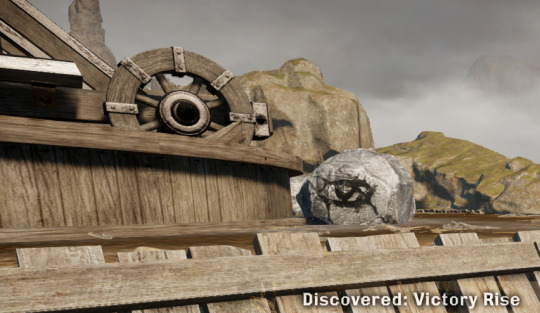
We see this rock with an eye in many places of Exalted Plains, usually, but not exclusively, representing the attack of Orlesians [at least in the context of Exalted Plains and Emerald green]. During the main quest, in the attack to Adamant Fortress, it was the Inquisition who used these stones. Clearly a reused asset with little meaning, so I will skip it.
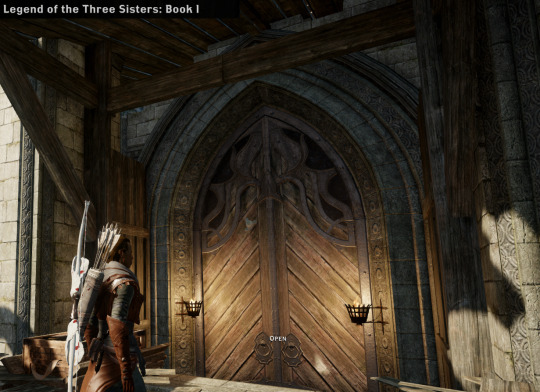
In Victory Rise we find more Elven ruins: we can see the elven patterns of swirls and flowers around this door. In this place we find the codex of Legend of the Three Sisters: Book 1.
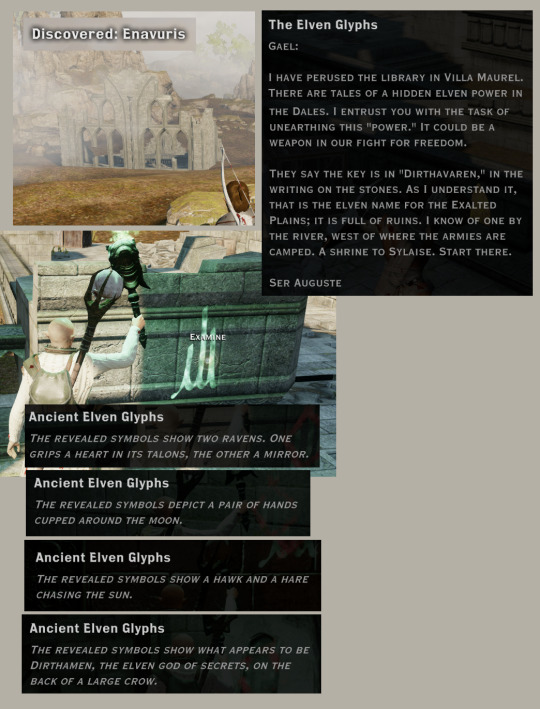
In Enavuris [such a name to confuse it so easily with Evanuris] we find a ruin that, after inspection, allows you to follow a quest to look for ancient elven glyphs. The power that the note The Elven Glyphs talks about ends up being the “Dirthamen’s wisdom”, a strange shield that can be found at the end of the exploration of the Lost Temple of Dirthamen which has an oddly Tevinter look. [See the post related to the Lost Temple of Dirthamen]. It’s hard to understand what each of these symbols that appear in the glyphs mean. Clearly, all of them are secrets, such it is the nature of Dirthamen. A brief, potential analysis can be found in the post of the Lost Temple of Dirthamen.

In Halin’sulahn we find a very small Dalish clan. They are placed close to a rock which shows the usual painting of a yellow halla, and the one that looks like a battle with many elves on hallas. There is also a statue of a hart. After talking with the Keeper of this clan we are informed about several elven-issues that the War of the Lions has caused.

The encampment shows the typical Dalish symbols: these fences with ragged hides and tree branches paint in red or green on them.

I always like to highlight that the Aravels keep these undulating lines that make me remember the undulating patterns in many, if not all, murals found in DAI. It is also worth remembering that the aravels were prison-ships filled with slaves that sent elves to dwarven cities [check The Horror of Hormak].


In search for those ancient elven glyphs, we explore a zone called Ancient Baths. By its name it seems to be an elven building which allowed baths in the river. Its entrance is decorated with two archer statues, and two wall paintings: the yellow halla, and the black twisted halla with white elves wearing vallaslin [the Dalish “remember” that golden hallas guided The people to places where they needed to be, specially in desperate times. The truth behind that probable is more twisted]. Every time I see these paintings I suspect that this building was meant to be used by slaves.
As we proceed, we find a point where we need to jump off. This chamber, in its configuration [not grandeur], looks like the Temple of Mythal's main chamber where the priest stays in a high place, inaccessible to reach [no stairs in this chamber], looking from above down to the petitioner.
This section has ancient elven decorative elements: two inuksuit decorated with red swirls and a central squared stone, both elements used for the elven dead. More than half of the ruin has fallen apart but it seems to give an idea that this building was meant to be used to see baths in the river.

As it can be seen, the decoration is ancient elvhen.

As we explore the map, we find this statue which triggers Andruil's Messenger, a codex that produces more confusion than understanding of who is the god behind the owl symbol. There is a painting of a yellow halla beside the statue. Since it is an information given by Gisharel, it may be extremely wrong. The tale almost hides a command: the people, aka the slaved elves, will follow Andruil, she will tell them when to hunt, when to raise hallas, and when to settle down. And for that, she will use an owl. Since we do not truly have better sources confirming that the owl, crow, or raven are Dirthamen’s sacred animal, it’s hard to suspect how much of this tale has been twisted along the Dalish history.

In the open we see more of these four painting together: The row of slaved elves, The Armoured Figure, The Vallaslin shifting halla, and the black halla with elves wearing vallaslin. All these paintings together seem to speak about elves being capture, alienated [ they have no face nor heart] under the control of a symbol we have seen a lot: the golden ring, and these slaves are related to vallaslin and deformed hallas that shift. For more detail, see the post Nation Art: Elvhen.

Several times in the open we can find these owl statues or the archers. Sometimes even marking a path, as if they were guiding us to some places. Sometimes they are accompanied with the paintings.
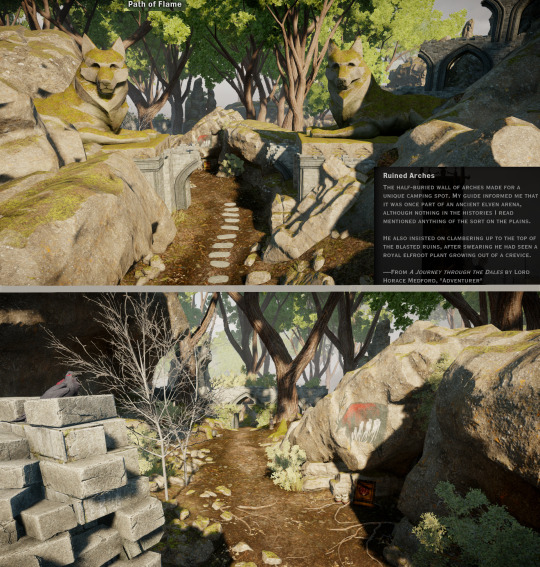
The Path of flame, a name designated by the Chantry to this part, looks like the entrance of a bigger elven ruin, which is protected by two big Fen’Harel statues. The landmark we trigger around this area, extremely unreliable, suggests that this place was an elven arena. I hardly believe it, but certainly there is something about gathering many elves and forcing them to walk certain paths [aka, a path to mark slaves? considering the paintings]. The truth is, that the game has showed us two elvhen arenas already: In Emprise du Lion, called currently by orlesians names since the original ones were lost to the ages: Etienne’s Ring and Leontine’s Ring, which are now used by dragons. So, I have to say that despite not trusting this source in the slightest, the Ruined Arches of Exalted Plains have a similar look to those we see in Emprise du Lion. So maybe elves had rings after all but the purpose of them is completely unknown.

In this zone, we find a solitary statue of Fen’Harel on the waterfall.
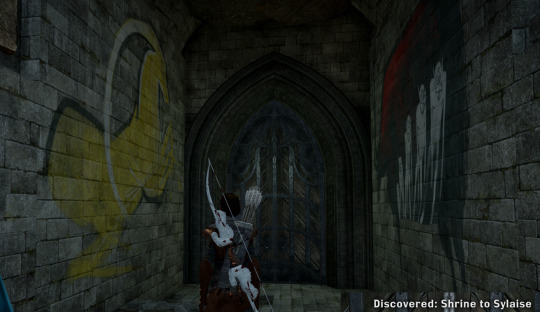

Some meters away from it, there is a Shrine to Sylaise, which entrance is decorated in the same fashion than the Ancient Baths: two archers indicating the entrance, and two paintings depicting a yellow halla and a black halla wtih elves wearing vallaslin.

When we enter the temple, we only find crypt-related elements: inuksuit and urns, and a codex of Sylaise is triggered: Sylaise: the Hearthkeeper, which is the usual one we find in DAO, and extremely unreliable.

Inside the temple there is a small corner covered with a barrier, where a body can be found. This body has a valuable historical talisman of the Dales elves, and an ancient elven robe. It's not clear to me how to understand the situation in which we find it.
This talisman belonged to an historical warrior of the Dales, and since we find a Robe that looks like the same one than the Keeper of the Clan we met, I assume this body was an ancient Keeper who wanted to protect that talisman from the shemlen, and made a barrier with themselves inside, or they activated some trap of the small shrine and got caught in it..
[Index page of Dragon Age Lore ]
#Exalted Plains#elven design#Andrastian design#guardian of the path#paintings#Strange Skull-Dragon totem#Sitting Fen'Harel statue#Razikale Ceremony#Horned warrior holding a sword#Tevinter objects#aravel#dalish design#elvhen design#Elven Owl statue#Elven hart statue#Elven Archers#playing DA like an archaeologist
37 notes
·
View notes
Text
The Lost Temple of Dirthamen - Part 2

The Lost Temple of Dirthamen is an ancient temple dedicated to the elven god Dirthamen. It is located in the northeastern Orlais, off the northern coast of the Waking Sea. Along the years many treasure hunters went after the wealth inside it, but they never returned.
[This is part of the series “Playing DA like an archaeologist”]
Sanctuary

The Sanctuary is a big chamber of the similar dimensions than the petitioning chamber in the Temple of Mythal.
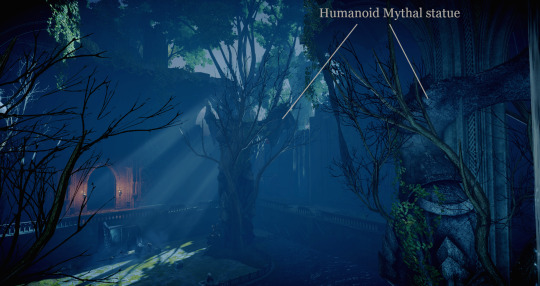

When we enter we see four Humanoid Mythal statue in the centre. The walls at the sides of the entrance display different enigmatic details: a winged, insectoid halla; an elvhen warrior, a lizardman, and two mosaics: a dual mosaic of Falon'Din in a usual green colour, and Ghilan'nain's mosaic in RED.
The Sanctuary is made of two levels, as most elven temples are: on the lower level there is a pool with elven owl statues, where several altars are arranged in a semi circle. The first floor is collapsed and falling apart, impossible to access to.
Let's see each of these walls and the information they contain:
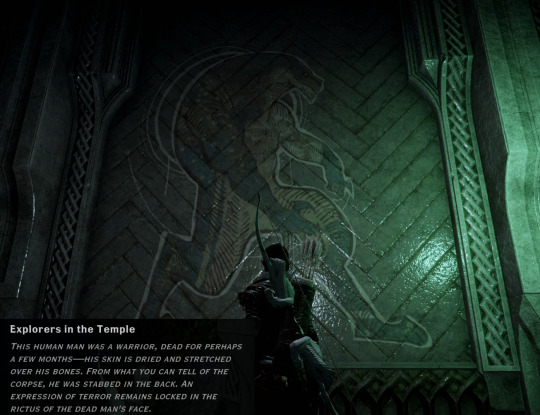
The lizard man painting shows the note of the dead mercenary that I already spoke about.


The wall beside the lizard displays a red mosaic. This mosaic was such a pain in the neck for me. I could not see it in my game due to the darkness of this Temple, and the screenshots were also too dark. Until I realised the reason of its darkness was because the colour itself: unlike the other mosaics which appear in light green, this one is dark red. I had to take a screenshot blindly and then break its saturation and brightness to make it visible at least. That's the reason of the bad quality image above. On the second image, I overlapped the Ghilan’nain's mosaic, to be sure there were no alterations hidden with the darkness. And as it can be seen, there are none, the only odd thing is that the mosaic is too cut off to frame properly the halla.
Behind this mosaic we find the Path of Secrets, where we find another painting of a lizardman marked by an elven owl statue. The implications that Ghilan’nain is hiding a secret of arcane nature, keeps bringing a lot of connections with The Horror of Hormak.
Along the temple we collect pieces of the codex The Lost Temple of Dirthamen, which explains how a small group of disciples of Dirthamen were informed by their High Priest that Dirthamen was gone. They fear their secrets can be extracted from them, so they despair. Their High Priest tries to comfort them, telling them they are safe as well as their secrets, but they [as disciples of the arts of secrets] can see his deception: apparently, the High Priest wants to perform a ritual using the blood of the disciples to trap them all in this temple [it's our blood he seeks, a sacrifice dark and unholy, a prison of evil to keep us in and all else out]. The next stanza seems to mean that the ritual was meant to remove the secrets that the disciples knew, but they rebelled, performing a counter-ritual in which they dismembered their High Priest and bounded him with them into the dark silence of this temple.
What I like to highlight here is that there is a repetition of the bounding process all over the game DAI:
It's quite clear that the High Priest and disciples of Dirthamen have a deep knowledge in bounding rituals. They seem to be made out of blood magic as well.
In the context of DAI, we are presented with another bounding process: the one that the Grey Warden perform via blood magic to raise an army of demons. This knowledge was shared by Corypheus.
That Corypheus knew about it means that he potentially learnt it from elven magic [as we know a lot of Tevinter magical knowledge ended up being a co-opt from elvhen knowledge when the empire was falling apart]
Recently, in Tevinter Nights: The Horror of Hormak, we have access to information that allows us to speculate that Ghilan’nain was responsible for the magic that transformed creatures into chimeras and bounded creatures with different souls to one body. Therefore, her mosaic in this Temple could potential imply that she also knew the secret of some powerful magic related to a bounding process.
All this means that, potentially, the elvhenan may have always known means to bound people, spirits, and bodies.
So, with all these bits of information and speculations, I like to interpret that, this temple, showing us a dual mosaic of Falon'Din at the entrance of the main chamber where "Dirthamen's wisdom" is hidden could potentially mean that Falon'Din bounded Dirthamen to his own will. This would explain why Dirthamen's favoured animals are blurred with Falon'Din's and why their tales always blend one another.
Sadly we don't know when this event in the Lost Temple of Dirthamen happened. We know this tragedy was triggered by the disappearance of Dirthamen, which is not clear if it was caused by Solas with the creation of the Veil or before that time. If that were the case, it could also justify the hypothesis that Dirthamen had been bounded to Falon'Din's will long time ago. Why would Falon'Din do that to Dirthamen? Solas told us that Falon'Din’s vanity was enormous, and it was implied that he would take any measure to increase the amount of worshippers [even to challenge Elgar’nan, according to old codices], so maybe acquiring the secrets of Dirthamen could have helped him in that endeavour. However, all this falls in the field of speculation.
Rooms accessible from Sanctuary
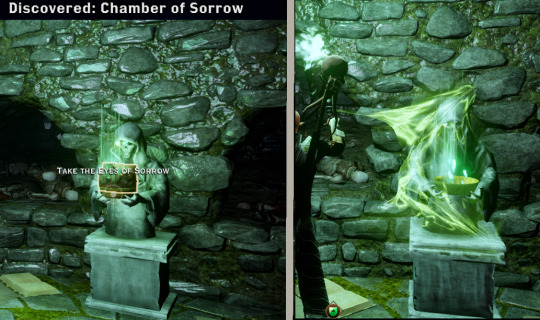
Through the Sanctuary we have access to more chambers where we keep collecting the pieces of the High Priest of Dirthamen. Each time we take a piece, we see a Fade-rift effect.
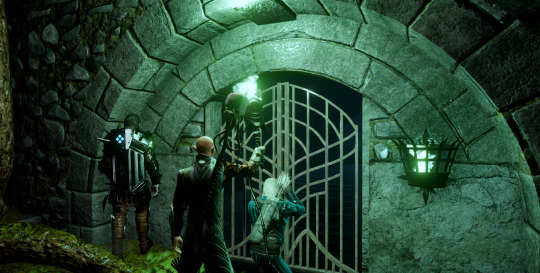
In these extra rooms and corridors, we have access to more chambers that have little difference to all what we have been seeing so far: all funerary, crypt-like chambers behind locked gates.
There are only 2 rooms that have some interesting content, one beside the other:

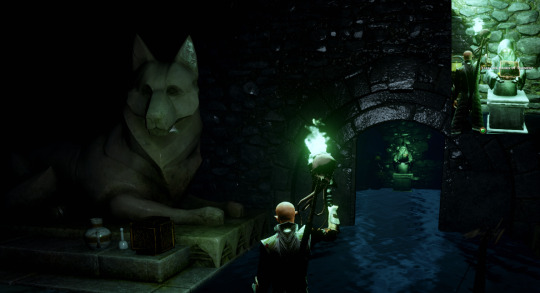
One of these rooms, called the chamber of torment, is guarded by two sitting Fen’Harel. At their base they have books, an elvhen box, and these white objects with a wing-shaped symbol on it that are presumed to be Vallaslin ink.
The other room is marked with the elven owl statue, where we find the Path of Secrets.
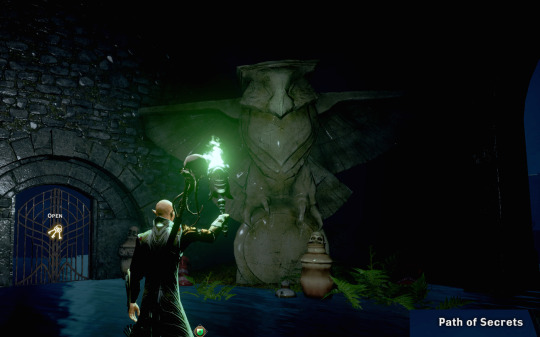
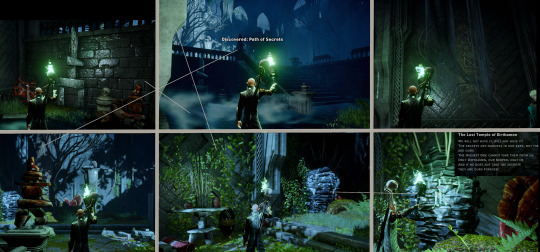
This path is behind the red mosaic: the path of secrets. It’s marked with an elven owl statue. The wall at our right displays the painting of a lizardman. In front of it, there are inuksuit, including the Red inuksuk. We also see ragged Dalish hide and urns.
If we climb up the stairs, we find another Red inuksuk on the handrail, the Archer statue, and more inuksuit that keep updating the codex of the Lost Temple of Dirthamen. Usually the Archers keep pointing out a place where to go, but in this case they only mark a veilfire brazier.
Complete the Ritual

Once all the parts of the body are collected we can go to the Sanctuary and place them on the altars.

When we approach the main desk in this ritual configuration, we notice that the desk is made of a dark metal, and has a picture of a pointy tower. Both elements look more like Tevinter style than Elvhen.
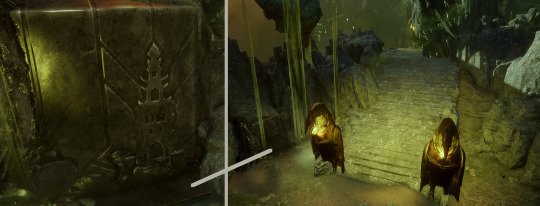
The same object can be found in the Fade, at the sides of the eagles which gives us access to a place with many claws of Dumat and Tevinter objects [For more detail, see the post related to Fade].
Finally, here we have the last part of Explorers in the Temple (stained notes). It explains that the mercenaries saw Gretien running away from the Temple at night. They assumed it was because the nightmares caused by the “voices”. The same ones he used to dismiss, according to previous notes. Not wanting to waste months of works, the mercenaries attempt to finish the ritual and get money from the treasures in this place. As the codex continues: these mercenaries deciphered Lord Gretien's notes and performed the ritual without him. They also comment that the scholar reached to the conclusion that this ritual was a way to "reassemble" the High Priest. This mercenary clearly is not a specialist in Elven culture, we can agree on that, yet he finds it unsettling that the elves would dismember their own priest. We are seeing a side of ancient elven culture that, curiously, looks like very Tevinter.
Since these notes have dried blood, it is clearly that they performed the ritual, summoned the demons, and got wounded. By the body found beside the entrance to the Sanctuary, we can be sure that most of them perished or escaped to never come back.


Once the ritual is completed, we see a rift appear, summoning the Highest One, who is now a despair demon. I assume the rest of the demons that come with him are the disciples. They mutually bounded themselves to this Temple.

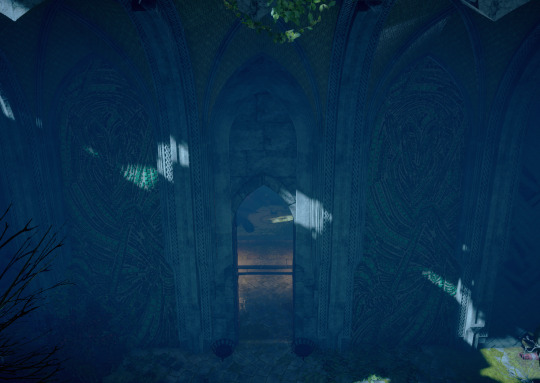
Anyway, once we kill the demons, we have access to the main chamber of this place [the main door is decorated with two Falon'Din's mosaics].




This room shows the elements of an Elvhen Temple that I was expecting: golden elvhen patterns on the door frames and walls, beige mosaics, gigantic imposing golden statues, in this case of a pair of Howling Fen'Harel [I had to modify the brightness of some images to make them a little more visible at the expense of making them look uglier]. There are more inuksuit around [which makes sense if we think in what Solas told us about Falon'Din: He would massacre a lot of people in wars to increase his worshippers out of vanity, so his Temple may look more like crypts. At this point I keep wondering why this temple is called "of Dirthamen". Nothing here makes reference to him, but everything seems related to Falon’Din.

These statues are made of gold. It's strange that the main chamber of the Temple of Dirthamen [or Falon'Din] has central figures of wolves. Would that mean that there are more wolves in the elvhen pantheon than Fen'Harel?
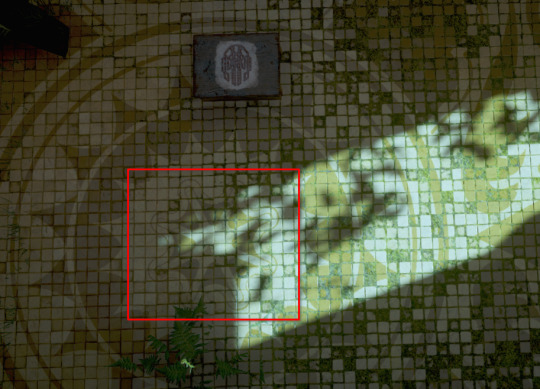

Where the loot lays there is a bigger mosaic on the floor, displaying a sun, surrounded by circles and its centre has a similar asterik-shape to that one found in the Mural of the titans. As if this were the representation of an elven-orb or a titan's heart.
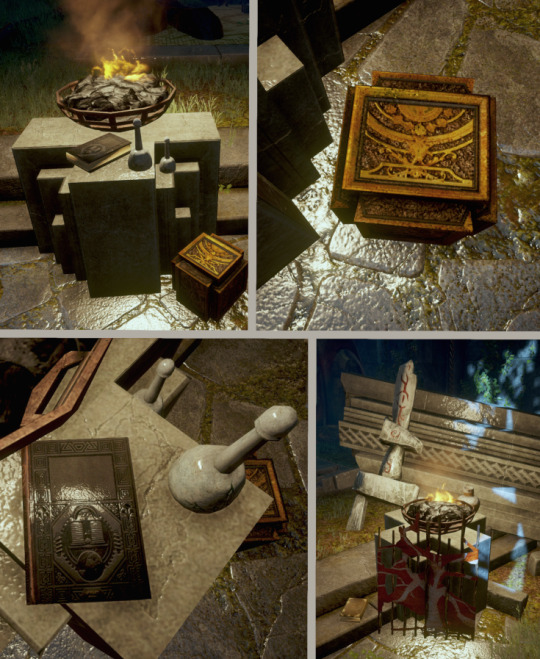
In a corner we find a book with a cover I don't think has much of interest. We find an elvhen box and that strange white item that apparently it's ink, according to the game files. We also find some Dalish elements [the fence made of hide] that may have belonged to some ancient Dalish explorers.

The loot is a shield called Dirthamen's Wisdom, what the scholar Gretien was looking for. It has a very Tevinter style, and its description says that the power contained in this shield is so great that prevented the item and the temple from falling apart due to decay. This implies that the Temple will fall soon after we remove this item from here.

The loot is a box with a symbol we had seen in the elven funerary lid.
The Lost Temple of Dirthamen: Part 1 - Part 2
[Index page of Dragon Age Lore ]
#elvhen design#elven design#inuksuit#paintings#red mosaic#Ghilan’nain#Humanoid Mythal statue#Sitting Fen'Harel statue#falon’din#Dalish ink#Red inuksuk#Elven Owl statue#Tevinter objects#glyphs#Elvhen funerary lid#asterisk symbol#Playing DA like an archaeologist#pointy tower
10 notes
·
View notes
Text
Crestwood: surface

Crestwood is a grasslands region located north of Lake Calenhad in Ferelden. It is introduced in the game when Varric tells the Inquisitor that he has a friend [Hawke] who killed Corypheus once and has a contact among the Grey Wardens, so they may help the Inquisition against the ancient Tevinter Magister.
[This is part of the series “Playing DA like an archaeologist”]

Scout Harding tells us that the zone was flooded 10 years ago during the Blight, and since the appearance of the Breach, corpses had been walking out of the lake.

Along the main path to the town of Crestwood there is a statue that has no codex or explanation attached to it. It’s a crouched bearded man, holding a bowl. Same statue can be found in Exalted Plains, where it is called “Guardians of the Path”. He seems to be related to Andraste symbolism, and in the Exalted Plains, his plate has a flame that should be eternal. This is not the case for the one found in Crestwood. It’s also interesting to highlight that this statue has some resemblance to the elven statue that represents Humanoid Dirthamen/Falon'Din in the Exalted Plains.


The region is filled with Ferelden and some remaining Avvar statues: we find many depiction of mabaris as decorative statues or in torches, general urns, and the avvar statue of the Dwarf with long limbs.

There is an interesting altar that we only find in Hinterlands: a metallic dark table decorated with spiky wolves, and many skulls on it. Nearby, a stone with the Ferelden drawing of a goat. More details about these paintings in the post Nation Art: Ferelden.



In many parts of the region we find statues that are over hills or small mountains, making them look down over the terrain. There are Masferaths with banners, horses, Dwarf with long limbs, and columns with a hole and a rope, all andrastian, Ferelden or avvar designs.

Below Crestwood there are several caves made of a similar stone than the one used by Avvars to sculpt some variations of their Keepers of Fear.
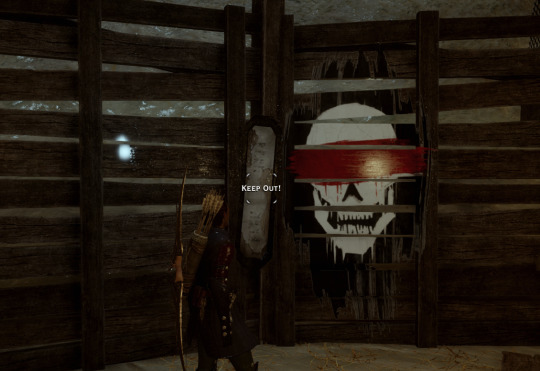
There are hideouts marked with this symbol which has been used in DA2 to represent the Riders of the Waking Sea. However, in DAI they are presented as the “Blind Men”, explaining that they are smugglers that sell slaves to Tevinter. Where there is smuggling activity in DAI, we see this symbol.



The Village of Crestwood is filled with different kinds of mabari statues, torches and braziers. The difference between mabari and wolf is not clear in my opinion, as it’s never too clear which of this art is purely Alamarri or Avvar or Ferelden. Their houses have different Ferelden paintings as decorations. For more details, see Nation Art: Ferelden.


The inside of the houses have standard, humble Ferelden decoration: there are rustic rugs that depict mabaris or wolves, there is a candelabra out of an antler, pamphlets, and their walls tend to have some art related to a the Canticle of Light that narrates Andraste’s life.

At the highest point in the village the Chantry shows up with a banner.
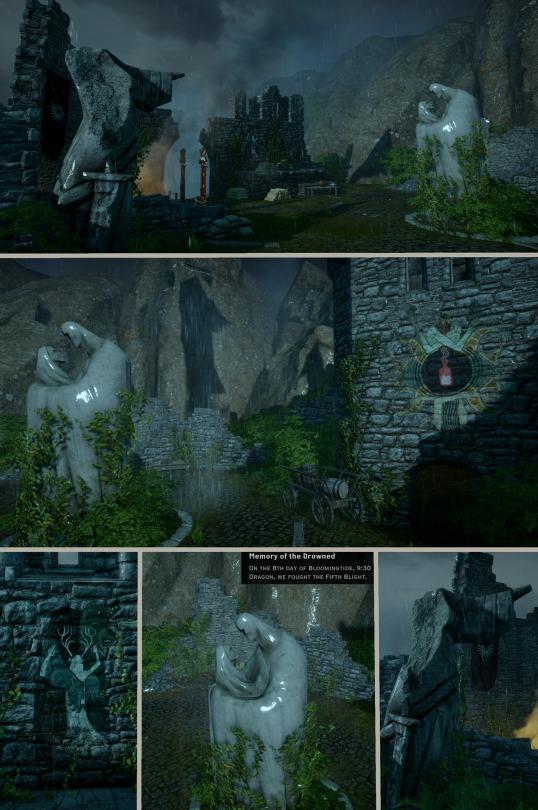
In this zone we find the strangest paintings from the post Nation Art: Ferelden: an eye-like thing made of two humanoids of long arms and another of a bear and a humanoid with deer/branch horns. There is a statue of a couple in the middle of this place which triggers a note implying it’s a statue in honour to the memory of the drown in Crestwood.
After talking to the Mayor, he informs us that the village has been flooded ten years ago by the darkspwan. Later we will know it was the Mayor himself who did it to avoid spreading the Blight since the refugee from the South of Ferelden were already infected.
Since the Inquisition needs to close the breach in the middle of the Lake, it’s needed to drain that water using the dam. This cannot be done until the Inquisitor conquers the Keep Caer Bronach nearby which has been taken by highwaymen.
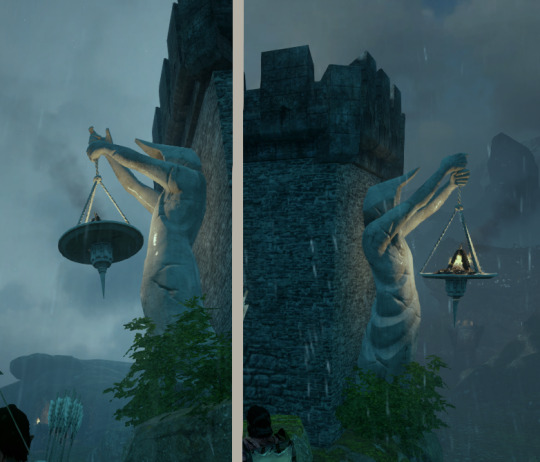
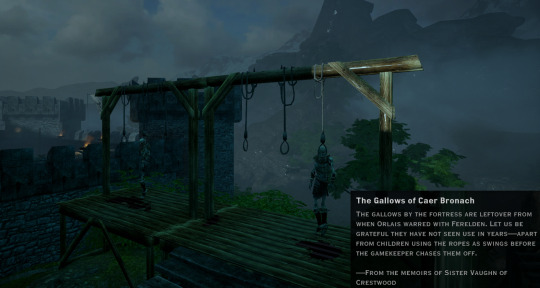


Once the bandits are expelled, we can explore the Keep which will trigger codices such as Caer Bronach, where they explain the King Brandel erected this Keep before the Fifth Blight to keep the Orlesian invaders at bay. The village took the name of the fort’s first captain who challenged each chevalier officer of the Orlesian army. He was defeated after he killed the ninth due to the blood loss and his wounds. Impressed by that honour and skill, the imperial army did not destroyed the village and headed directly to the capital.
The Keep doesn’t show any particular detail worth mentioning: inside we see the typical Ferelden style, rustic and block-y, without much detail or patterns in the walls or door frames. However, there a some statues depicting mabaris or howling wolves. In the exterior it shows some standard free marches statues. As it happens with the Keep in Western Approach, part of its decoration changes once the Inquisition takes control of it.
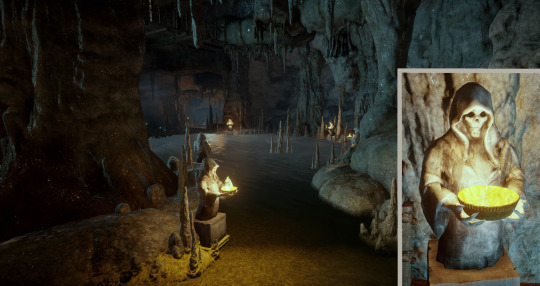
Underground, there are some creepy caves with statues of hooded skeletons that work like braziers. The same statues were used in the Lost Temple of Dirthamen and in Cradle of Sulevir.

When heading to the Dam, we find more statues of howling wolves in this pointy style that makes me question if it’s Ferelden,


Further south-east we find a ruin of a fortress with Ferelden Wyvern statues that we will see in ancient Tevinter ruins like The Still Ruin or in ancient Elven ruins, like the Tomb of Elandrin, and some isolated ones peeking over the hills of the Hissing Wastes. They are also present in two parts of the Fade, in one of them in front of Andraste’s head, forcing the player to notice those similar spikes.
Here we find two things beside the flag of the “Blind Men”:
A note called Fereldan Wyvern Statues, explaining that these statues are inspired in a legend of Andraste taming them with a song, but it strongly specifies this tale is non-official. In the book World of Thedas 2, we find a story without much moral about Andraste and a Wyvern.
A crumpled note that explains that these ruins are used by villagers to feed a dragon in order to keep them calm. We find skeletons of humanoids and… things that I still don’t know to what kind of animal they are.Their bodies appear everywhere in the game and what keeps unsettling me is that their skeleton has metal-armour protectors and spike. What kind of natural animal has metal in their bones?

Almost leaving the map, we find a broken statue of Andraste. Here we find a landmark that explains that this pond is not natural but consequence of a sinkhole from which the darkspwan emerged, being filled with water later during the big flood of the town.

Heading to the North, we enter to Rocky Slope. It has a path decorated with elven/dalish elements contaminated with red lyrium: the squared stone with eluvian-shape windows, the ragged banners with branches depicted on them, the ancient elven owl statues. We find a landmark called The Guide of Falon'Din, which explains that Falon’Din took an owl as a messenger servant who guides The People through the Veil. In Emerald Graves we find another codex explaining that Andruil took the owl as a messenger, so when Dorian confuses this owl as a messenger of both… it’s reasonable. Of course, the source of this bit of information is a Dalish Keeper, so chances that this is wrong are quite high.

At the end of the place we find a Fen’Harel statue, protecting a cave.


In the centre of the map there is a unique place called Wyrm hole, which entrance shows two big harts. It’s a small basin, with a waterfall, and many elven painting on its walls. They are the ones showing The row of slaved elves, The Dragon, The Battle and The Armoured Figure from the post Nation Art: Elvhen.
[Index page of Dragon Age Lore ]
#crestwood#paintings#ferelden design#Sitting Fen'Harel statue#Elven Owl statue#Elven hart statue#Andrastian design#Dwarf with long limbs#Ferelden Wyvern#free marches design#Mabari statues#Table of Wolves#guardian of the path#Playing DA like an archaeologist
7 notes
·
View notes
Text
Design: objects, statues, monuments, and patterns
Andrastian
Avvar - Alamarri
Dwarven
Dalish
Elven
Elvhen
Ferelden
Free Marches
Grey Warden
Orlais
Tevinter
Non-Identified
Visual Post
Patterns and Styles: Elvhenan
Patterns and Styles: Ancient Elvhenan
Patterns and Styles: Dwarvish
Patterns and Styles: Tevinter
Patterns and Styles: Orlais
Patterns and Styles: Others
Unique art/sculpture
Nation Art: Ferelden
Nation Art: Elvhen
Nation Art: Tevinter
Paintings
-- Avvar/Alamarri/Chasind/Felderan --
Mabari statues
Keepers of Fear
Dwarf with long limbs
Monolith with swirls
Eroded dragon skull
Table of Wolves
Tyrdda statue
Ferelden Wyvern
-- Andrastian --
Andrastian Design: Stained Glasses
Andrastian Design: Tapestry and Tryptich
Faceless figure holding a crown [The Maker]
Man holding bigger head
Blocky bearded humanoid
Andrastian Statues
-- Free Marches --
Free Marches eagles
Free Marches Sun
-- Elvhen --
Golden Ring
Elvhen funerary lid
Dragon Mythal statue
Humanoid Mythal statue
Howling Fen'Harel statue
Sitting Fen'Harel statue
Elven Owl statue
Elven hart statue
Elven Archers
Elven Tree Statue
Humanoid Dirthamen/Falon'Din
Red inuksuk
Elven Ancient Shard-based door
Shard [called elf-stone]
Evanuris Mosaics
Asterisk Symbol
Elven Orb
Vhenadahl
-- Tevinter --
Astrarium
Thrummer
Tevinter bird
Razikale Ceremony
Horned warrior holding a sword
Stone in Razikale-Ceremony-style
Potential foci
Unknown symbol
Water dispenser
Tevinter objects
Tevinter urn
Tevinter artefact with spikes
Tevinter golem
Artefact of Temple of Dumat
Sacrificial altar
Claw of Dumat
-- Dwarven --
Dwarven sarcophagus
Dwarven stone-paintings
-- Non-identified --
Quincunx
Skull bud with sword
Strange wolf-halla-like banner
Beheaded ram-man
Griffons [maybe Tevinter?]
The Colossus
Female Kossith/ Desire demon /Tevinter Warrior
Stone in Razikale-Ceremony-style
Man holding bigger head
Pointy tower
Sun-head creature
Moon-head creature
Bull horn-head creature
Beetle-head creature
4 notes
·
View notes